gabrielle union
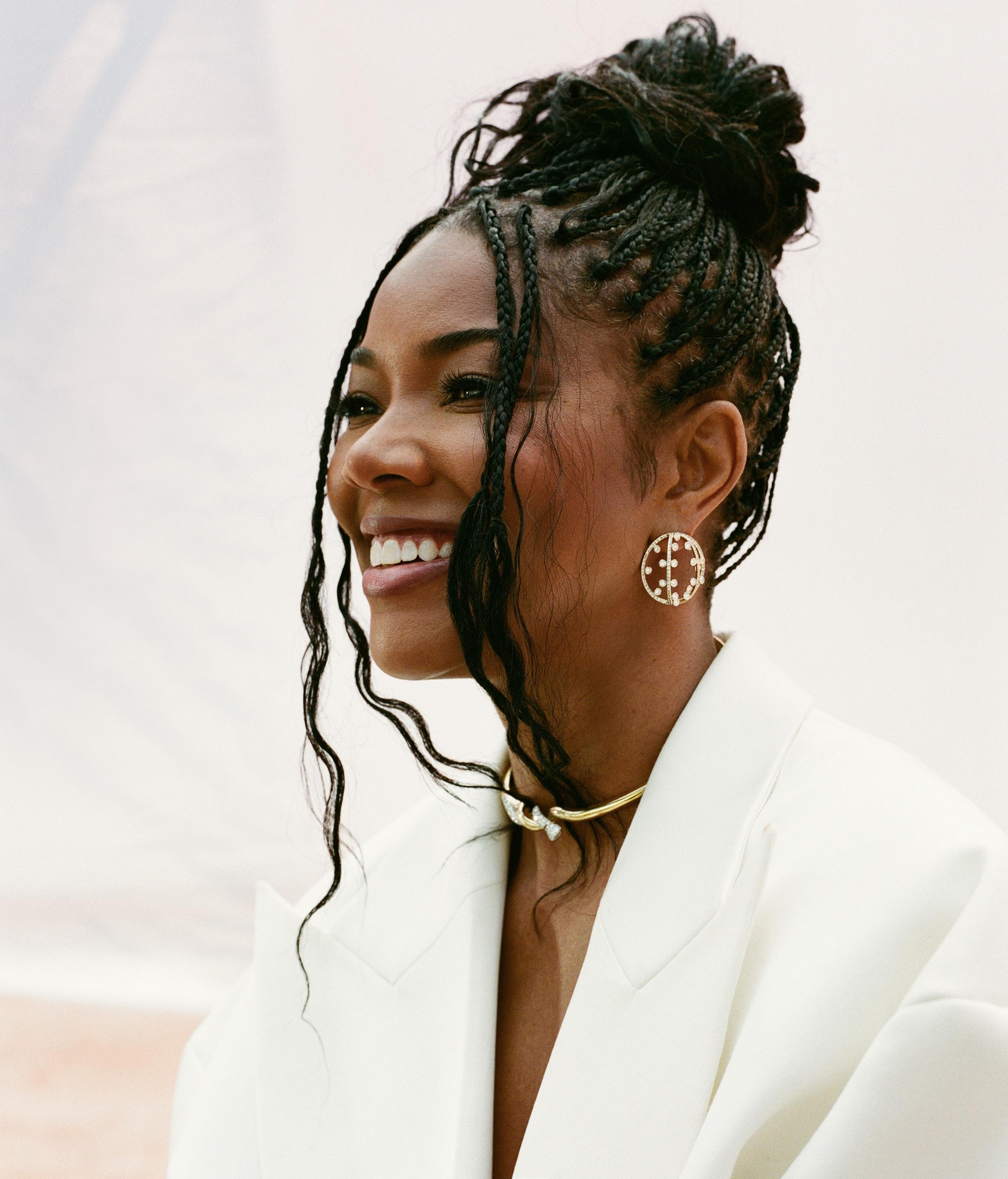
Informed by over 100 years of diamond-cutting expertise, Kwiat announces a collection of proprietary diamond cuts in iconic shapes, ensuring maximum brilliance and absolute consistency.



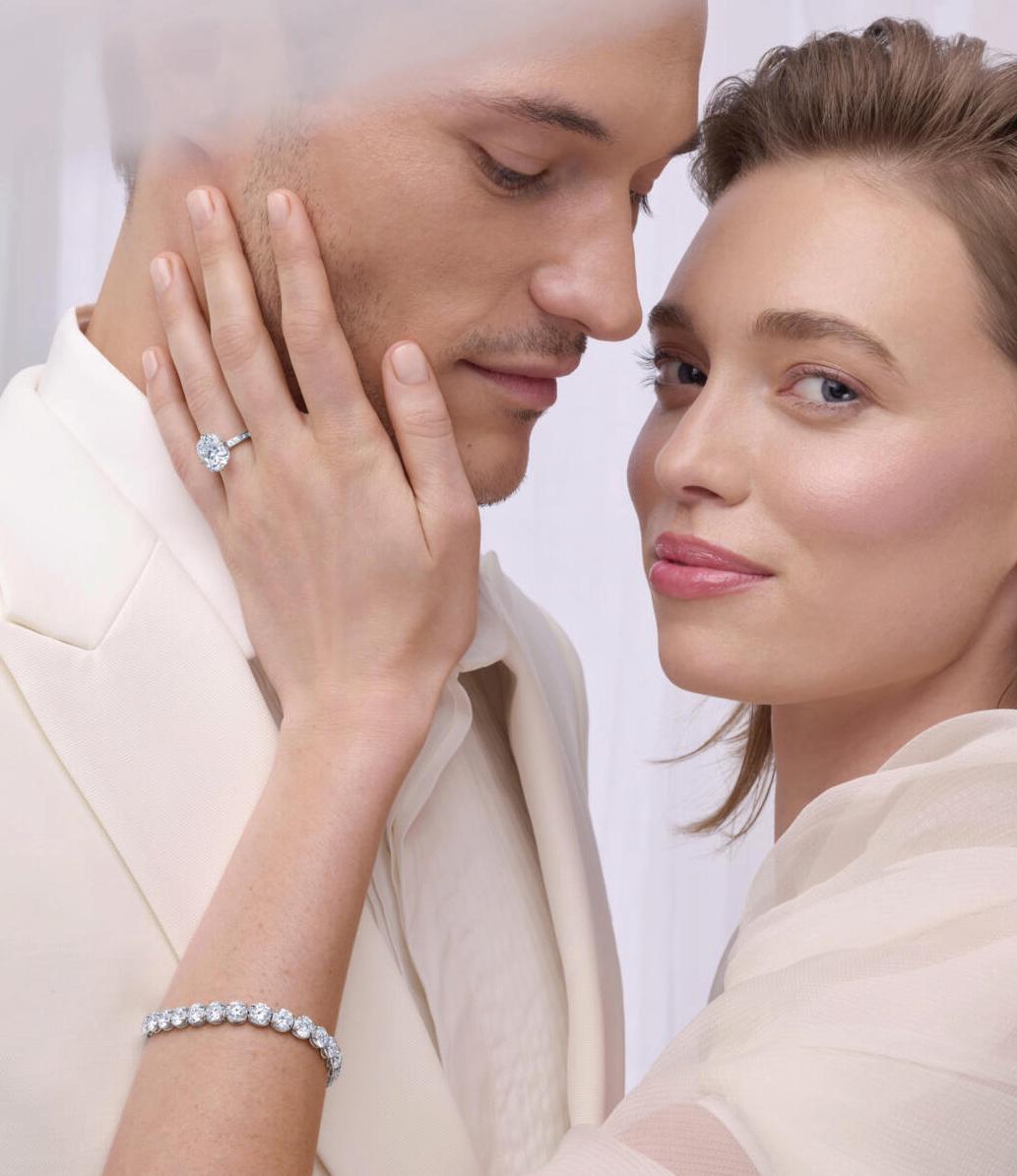
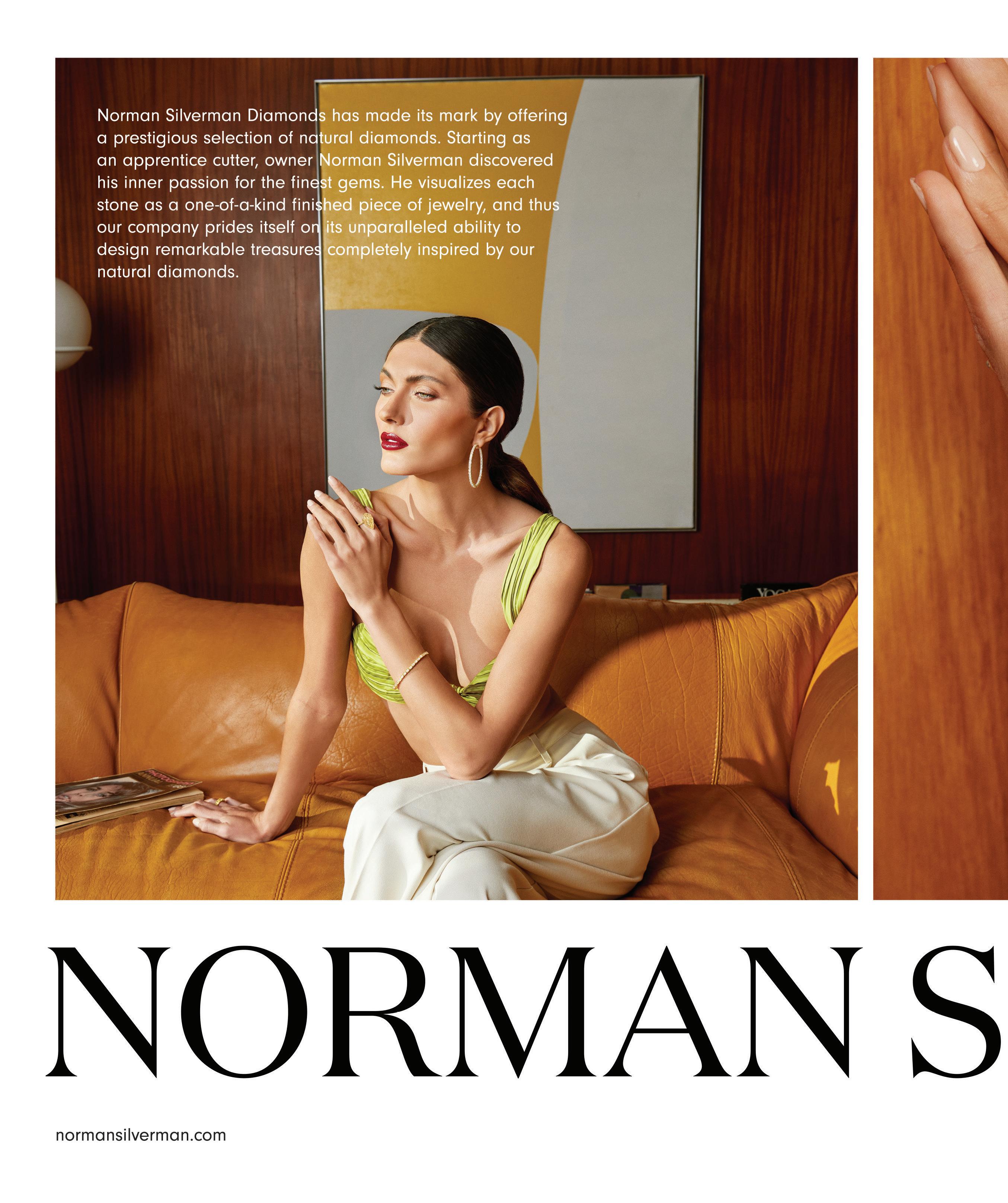

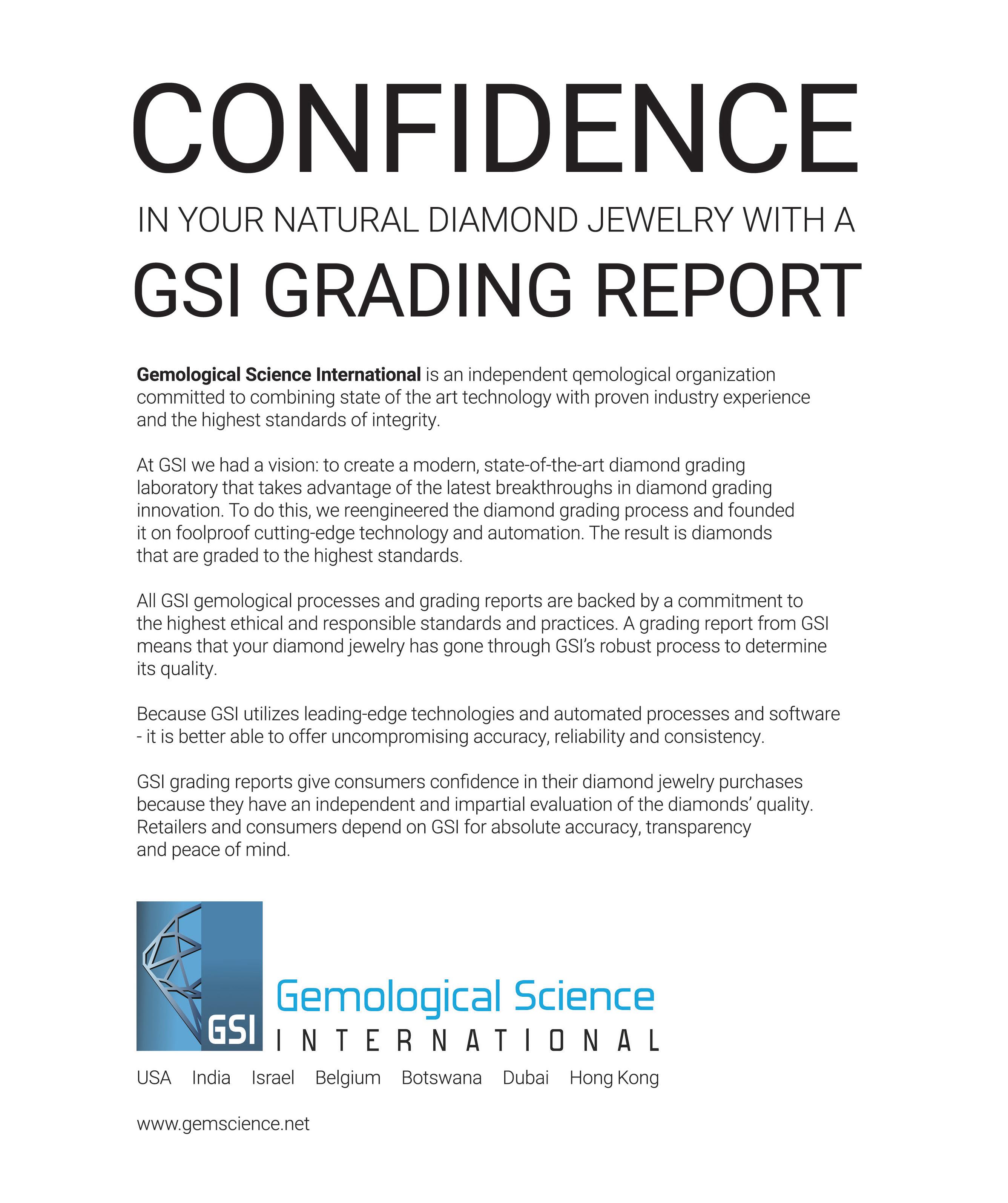
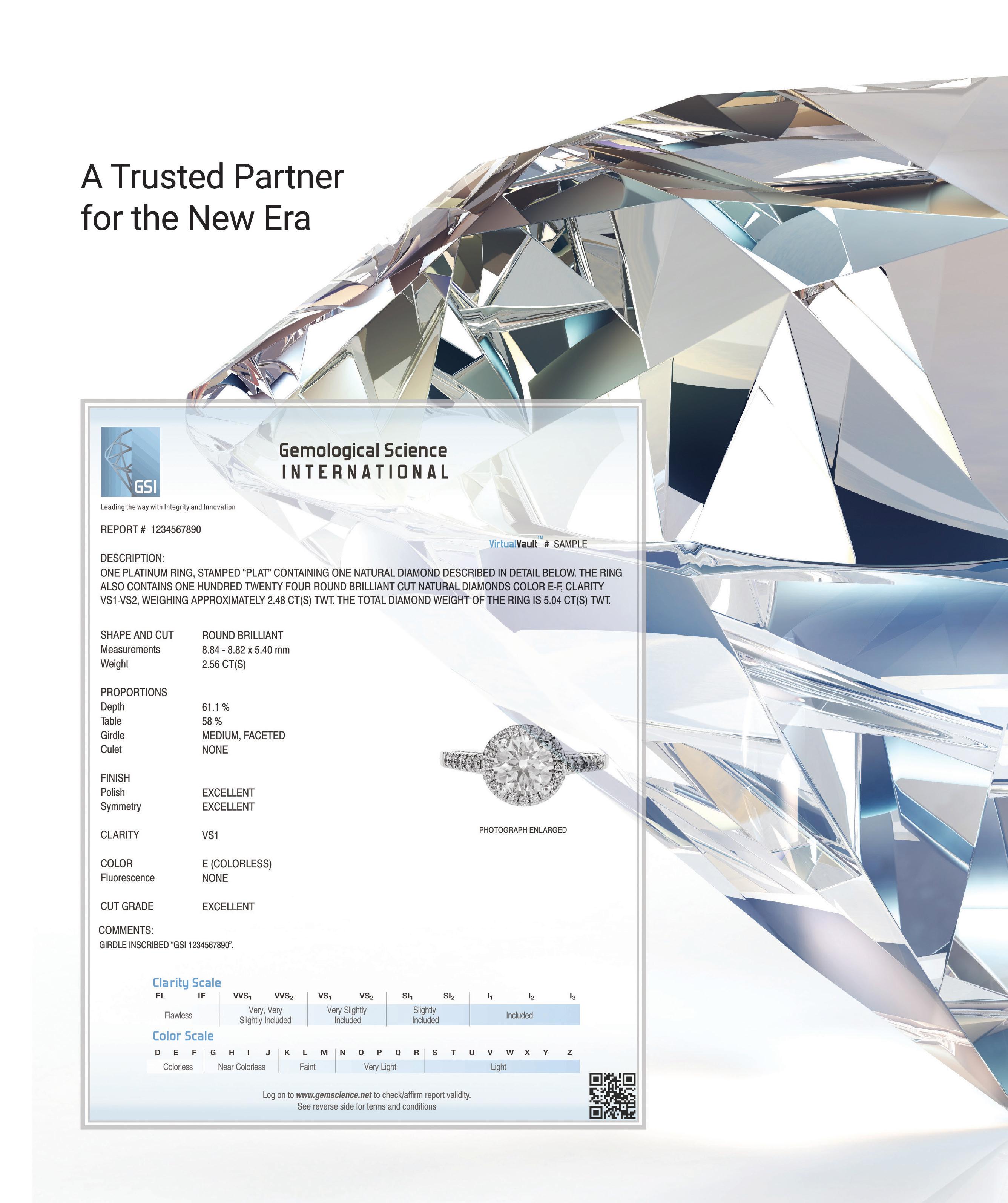


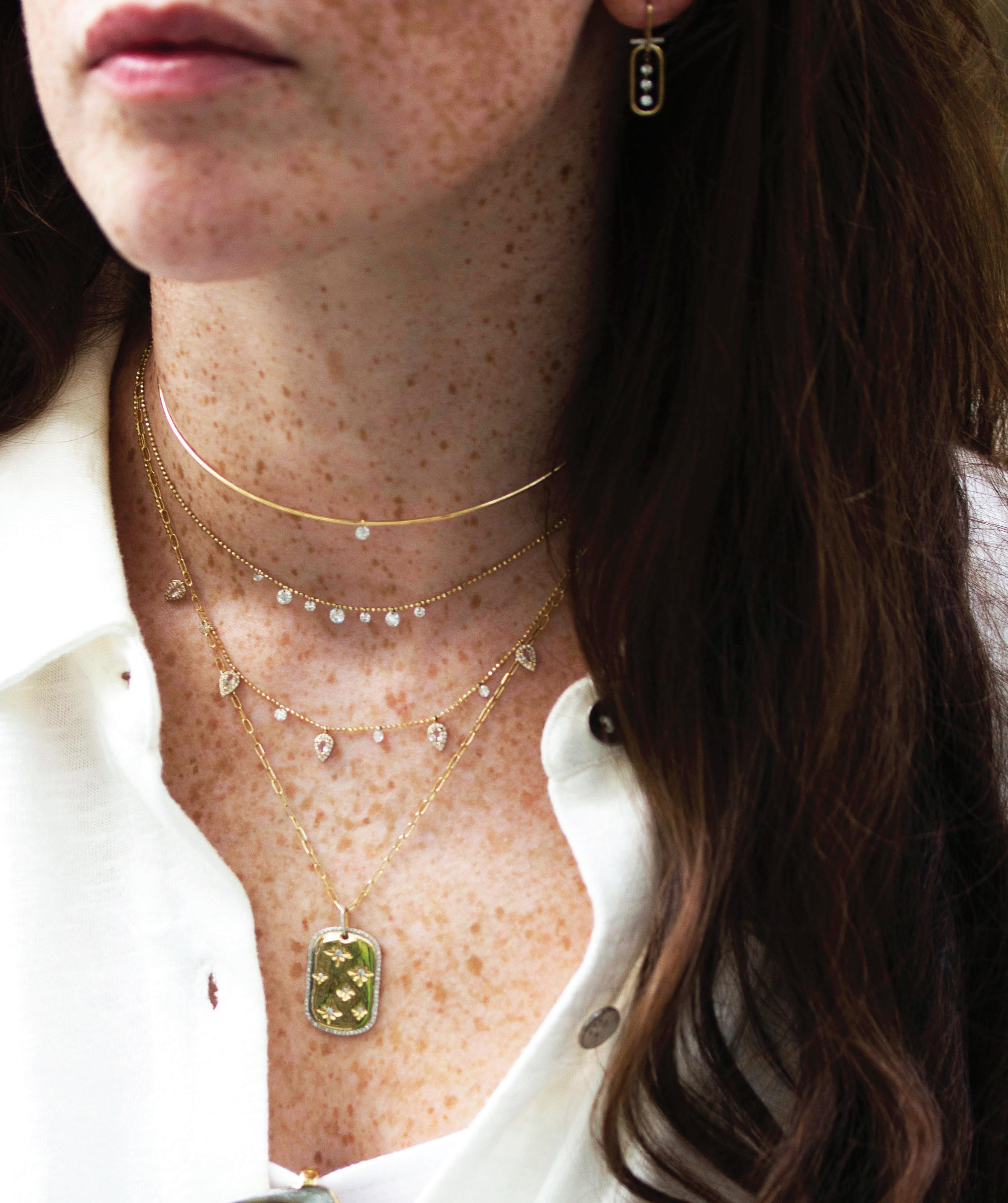
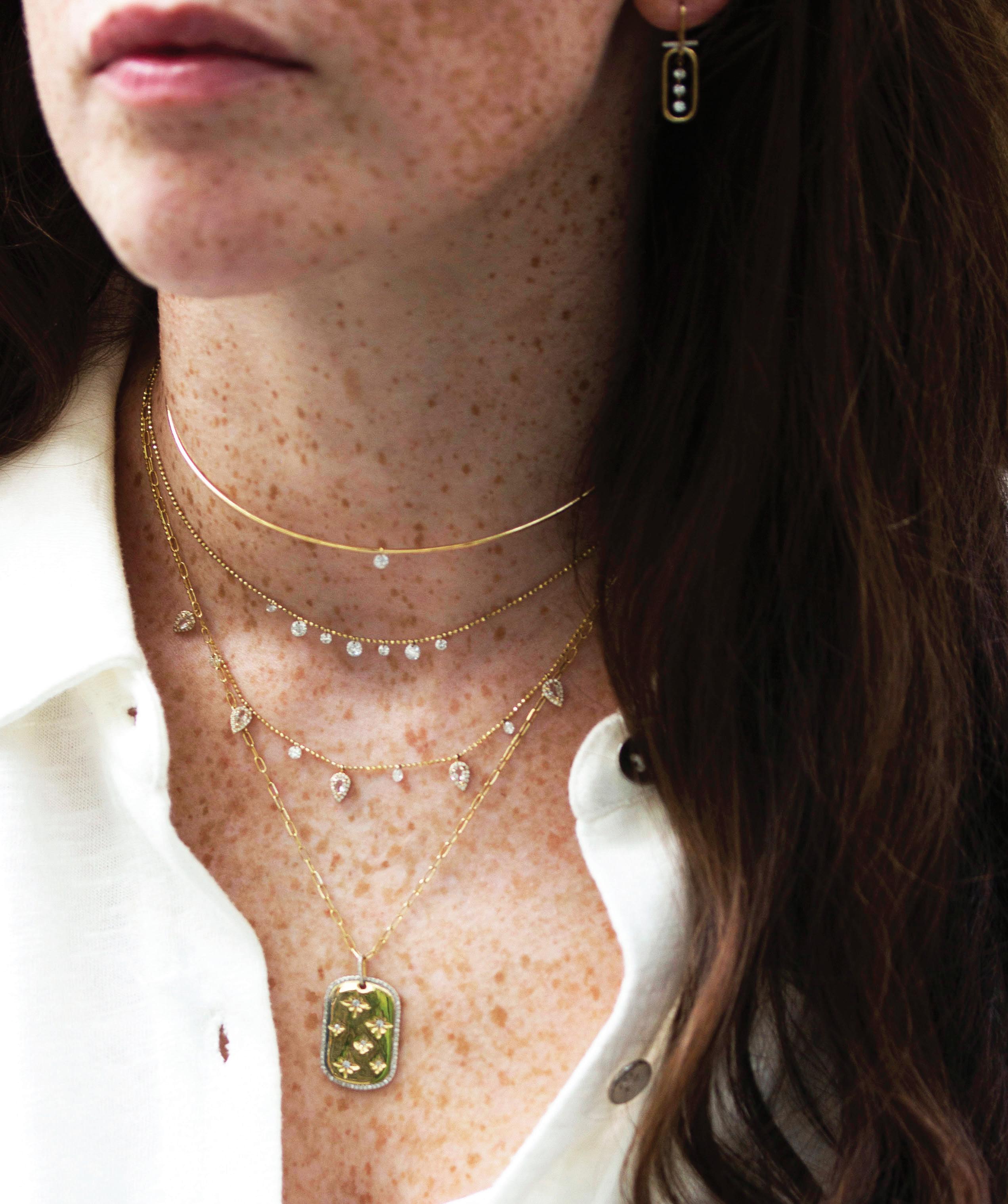
who isn’t just a little obsessed with time? Running late, running early, looking forward or looking back- this is the human condition. It’s no wonder we are drawn to the idea of timelessness. Trends come and go but the ultimate luxury is time. For Only Natural Diamonds’ inaugural print issue, it’s only fitting that we home in on what will perennially entice and retain value, just like a natural diamond. We focus on more than style or inspiration. We speak to the strides and impact made by transparency and sustainable practices and commitments.
Natural diamonds may be older than the stars in the sky but are hotter than ever on our cover star, Gabrielle Union. She is a vocal supporter of ethical causes and at 50 can still rock her cheerleader costume from 2000’s Bring It On. Union models the torque necklace which is as inspiring today as its classical roots. On the topic of origin, discover how the Ekati diamond mine, the oldest in Canada’s Northwest Territories, demonstrates the ways in which modern recovery techniques can coexist in harmony with our natural environment. Further afield, follow actress and NDC global ambassador Lily James as she sees first-hand the importance of diamonds to the country of Botswana. James de Givenchy, whose eponymous brand Ta n turns 27 this year, has crafted designs with natural diamonds of every hue that stand the test of time, each sparkling creation so modern that they transcend any trend. While only 23, Kiernan Shipka has played many roles but see her like never before in essential diamond jewelry. The 1970’s is an era whose style innovations continue to resonate. Whether it’s the streamlined look of the fashion or the piled on bohemian eclecticism of the jewels, it always feels current. Brazilian singer and model Alici models an updated look at the era’s sparkling style. Don’t miss an exclusive video with her vocal talents on naturaldiamonds.com as well as videos for all this issue’s features.
A special thank you to the editorial team and our spectacular cast of contributors. Time to Shine.
SAM BROEKEMA Editor-In-Chief
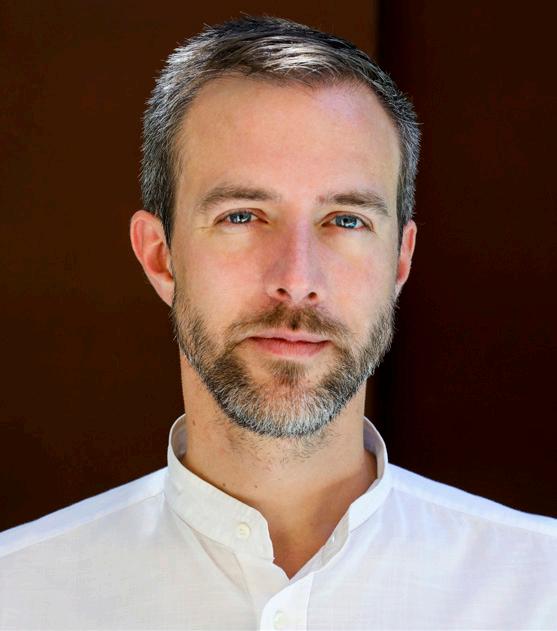

10 | THE EDIT 2023
EDITOR’S LETTER
On the cover Gabrielle Union wears David Webb necklace and rings, Mateo earrings, and Magda Butrym blazer. Photographed by Shaniqwa Jarvis
Trends
16 TORQUES & CHOKERS
Jewelry armor.
18 70'S STYLE JEWELRY
Why we can't stop loving it.
20 THE SECOND SKIN BANGLE
A defining accessory.
22 AKIMBO DIAMOND ENGAGEMENT RINGS
All the right angles.
24 MEN’S TREND REPORT
Searching for permanence.
26 FIVE JEWELRY CITIES
Vintage diamonds from around the world.
Sustainability
28 MEET LILY JAMES IN BOTSWANA
Think you know diamonds?
38 COEXISTING WITH NATURE
An inside look at natural diamond recovery in Canada.
Features
44 THE BIG ASK Questions you should ask when stone shopping.
46 MELANIE GRANT
On her new role as Executive Director of the Responsible Jewellery Council.
48 THEIR TIME TO SHINE
Meet Olivia Landau and Kyle Simon behind The Clear Cut.
52 EMERGING DESIGNERS DIAMOND INITIATIVE
The talented designers from 2023.
56 SUZANNE BELPERRON
Her arrestingly modern style lives on.
60 VALÉRIE MESSIKA
The queen of diamonds.
60 HISTORY OF ENGAGEMENT RINGS
How the storied style has evolved over the years.
66 GABRIELLE UNION
Photographs by Shaniqwa Jarvis.
80 AKIMBO À GO-GO
Photographs by Mark Lim.
94 KIERNAN SHIPKA
Photographs by Alexander Saladrigas.
106 SECOND SKIN BANGLES
Photographs by Jennifer Livingston.
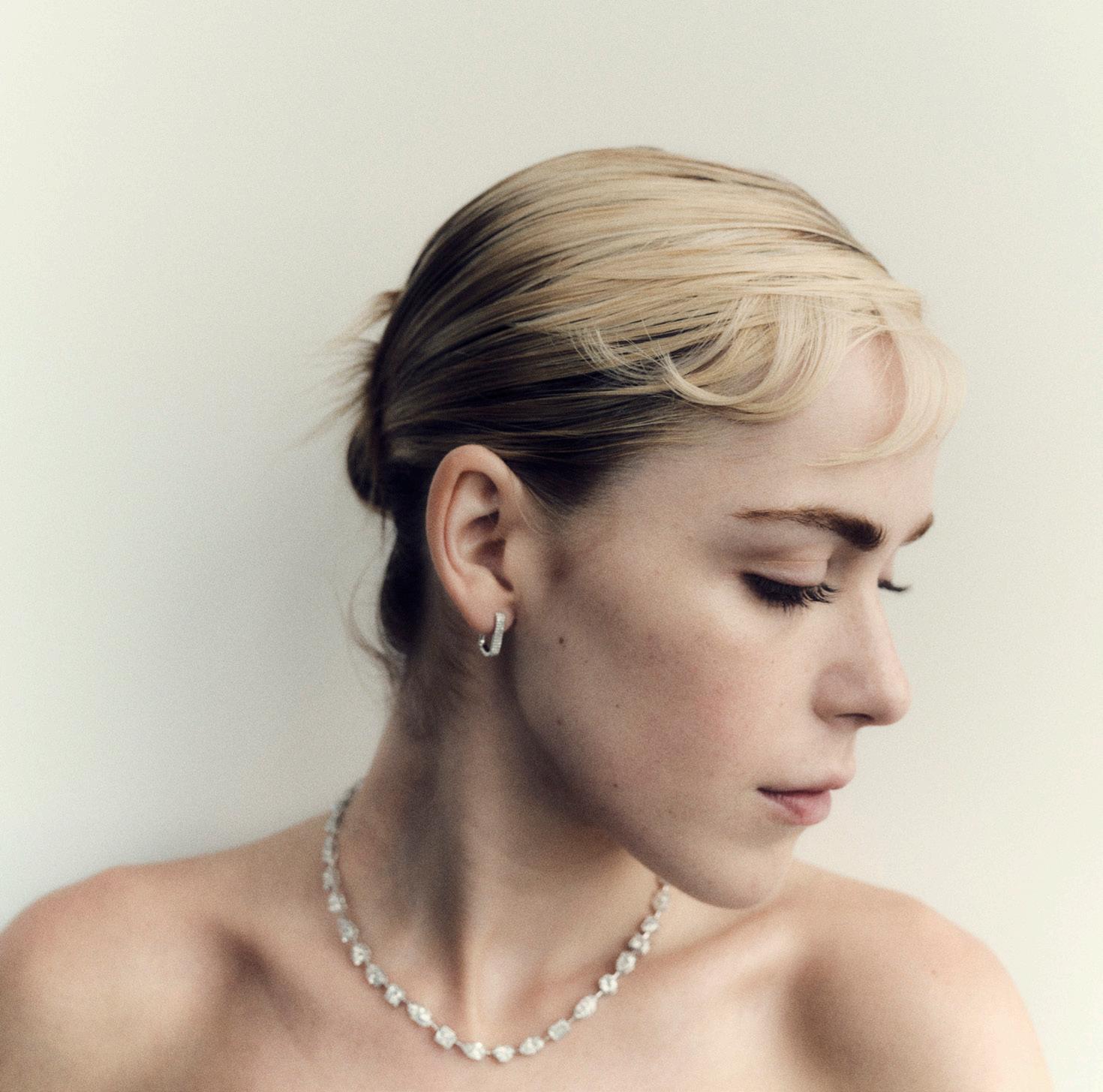
126 70'S DIAMOND DAYDREAM
Photographs by Alexander Saladrigas.
138 TAFFIN’S DESIGNER JAMES DE GIVENCHY
Feat of Engineering & Fancy.
KRISTINA BUCKLEY KAYEL
Managing Director
SAM BROEKEMA
Editor-In-Chief
SHANNON LYNCH
Senior Features Editor
GRANT MOBLEY
Jewelry & Watch Editor
JANE ASHER
Social Media Manager
ANNA MCFILLIN Assistant Editor
NANCY GIAMBONA Marketing Lead
CARRIE CRECCA Head Of Press CONTRIBUTORS
Brian Anstey, Sarah Cristobal, Vincenzo Dimino, Marion Fasel, Anthony Federici, Lucy Fox, Jessica Iredale, Faran Krentcil, Jill Newman, Lizzy Oppenheimer, Bryan Vargas, Andrew Werner, Christine Whitney, Lynn Yaeger
THE EDIT 2023 | 11
DAVID KELLIE CEO
Kiernan Shipka wears EF Collection earrings, Norman Silverman necklace. Photographed by Alexander Saladrigas.
CONTRIBUTORS
MARION FASEL
Founder and Editorial Director of The Adventurine online jewelry magazine, Marion Fasel is an esteemed jewelry expert, author, curator and trend forecaster.

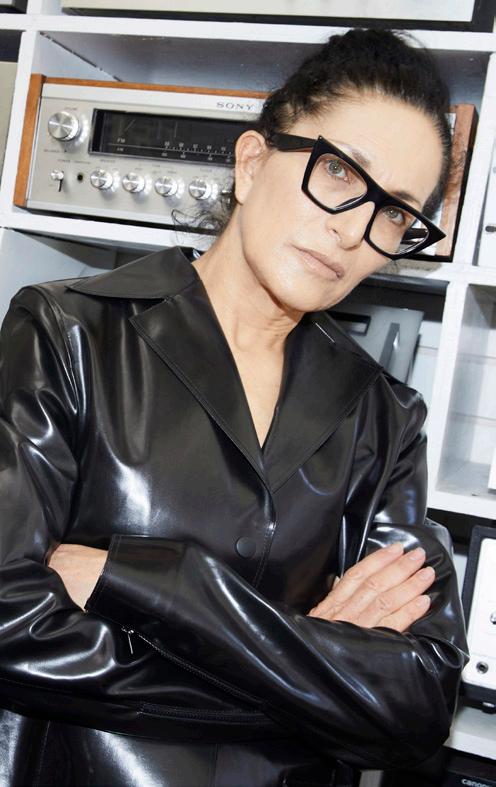

HAIDEE FINDLAYLEVIN
New York based creative director, fashion editor and stylist. She works consistently for US and International publications and is a Contributing Editor to T Magazine, Harper’s Bazaar and Numero amongst others. She has worked as Creative Director for numerous designers and brands, consulting on their creative identity, advertising and product development. Her work reflects beauty and sexuality. Her vision is provocative, original and always empowering. Haidee challenges traditional male and female identity within her work, glorifying the complexity and fluidity within.
LAURA FREEDMAN
Founder and CEO of the iconic jewelry store, Broken English Jewelry, Laura Freedman has had an appreciation for jewelry and gemstones from an early age. She opened her first store in 2006 in Los Angeles and has since expanded with a robust e-commerce o ering and, most recently, the opening of a brandnew Soho location. From contemporary designers to curated vintage collections, Laura prides herself on curating the widest variety of designers and vendors.
MARK LIM
Mark Lim is a photographer and director based in Brooklyn, New York. Having graduated from Parsons School of Design, his work often takes a conceptual approach, whether it be fashion, still life or his own personal projects. With his partner, he founded Nicotine Magazine, an internationally distributed fashion and art magazine, in which he is the CoEditor-in-Chief and Creative Director.
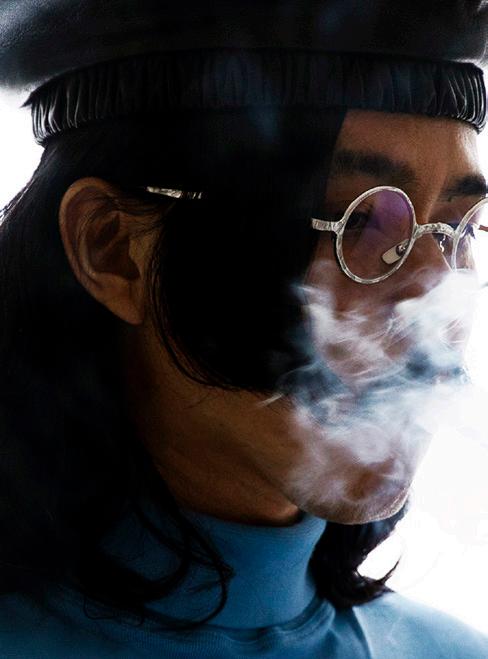
12 | THE EDIT 2023
JILL NEWMAN
A jewelry authority, editor and storyteller, Jill Newman has been immersed in the industry for more than 25 years. Her assignments have taken her to diamond mines across Africa, cutting workshops in India and Belgium, and jewelry ateliers around the world. Jill is the Natural Diamond Council’s Editor at Large and her work appears in the International New York Times, Town & Country, Elle Décor, and Robb Report.
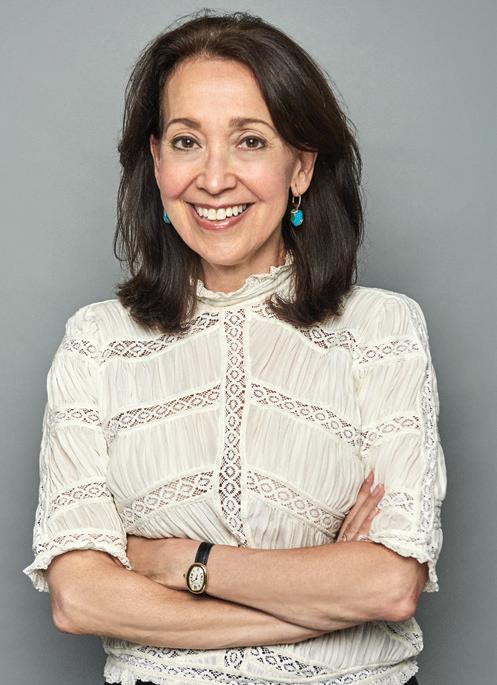
JOSH PESKOWITZ


Josh Peskowitz’s opinion and perspective are sought after by businesses and designers across the fashion spectrum. With a primary focus on menswear, his experience spans both editorial and retail, including his own shop Magasin. His writing has appeared in the New York Times, GQ Style, Esquire’s Big Black Book, GQ Style Germany, and Fantastic Man, among others.
JASON REMBERT
ALIETTE designer

Jason Rembert is one of the fashion industry’s most forward thinking and prolific creators. He built his career steadily, moving seamlessly for years between the editorial world, and as a stylist to powerful individuals in pop culture. Over time he established an innate understanding of craft and form, as well as an acute ability to express personality and uplift people through wardrobe. In 2019, this led to the conception of ALIETTE, a modern luxury brand.
ALEXANDER SALADRIGAS
Alexander Saladrigas was born and raised in Miami, Florida to a family of first generation Americans that emigrated from Cuba. He attriutes his success to the work ethic that he learned from his family members and their nurturing of the exploration of his passions. Growing up he always excelled in art, which led him to photography as his preferred form of creative expression. He began to consider photography as a career path in 2013, which led to his move to New York City in 2014.
THE EDIT 2023 | 13
 Gabrielle Union wears Retrouvai ring, Skeie's Jewelers necklace (top), Anita Ko necklaces, Louis Vuitton top. Opposite page: Casey Perez necklace.
Gabrielle Union wears Retrouvai ring, Skeie's Jewelers necklace (top), Anita Ko necklaces, Louis Vuitton top. Opposite page: Casey Perez necklace.
STYLE
Photographed by Shaniqwa Jarvis.
TORQUES AND CHOKERS
Written by MARION FASEL
Over the last several years, lucky charms have held a dominating position in the diamond jewelry landscape. One motif was followed by another and another and on and on. In consideration of all that the world has gone through recently, it’s easy to understand why people wanted a symbolic jewel to ward o evil and attract good energy.
Now the idea of jewelry as a form of protection is being expanded into high diamond designs. I am not talking about oversized diamond clovers or pavé-set diamond horseshoes. Instead, designers are revamping the ancient idea of jewelry as armor into bold torque diamond and gold necklaces and wide solid gold chokers lit up with diamonds. “They lend the wearer a feeling of strength,” says fashion writer and entrepreneur Josh Peskowitz.
Torques, in particular, have a history of being supreme warrior wear. The silhouette, which today is loosely defined as a neck ring with an opening, was worn throughout historic cultures by men. Ancient Romans sported them. So did the Vikings. And other cultures had them too but, the Celts—who lived throughout western Europe during the Iron Age—perfected the look. A one pound Celtic gold example on view at the Metropolitan Museum of Art in New York City shows the mastery.
The term for the style evolved from the Latin word torques and means twist. Some torques, like the Celtic one at the Met, have a twisted metal design but the embellishment is by no means necessary to the style. The most contemporary torque in the Met collection, made by master goldsmith Daniel Brush in 2014, is an engraved aluminum tube sprinkled with diamonds.
Designers making diamond studded torques now contour the hard gold surfaces into all kinds of shapes from slight arcs to flat expanses. Then they take their signature motifs

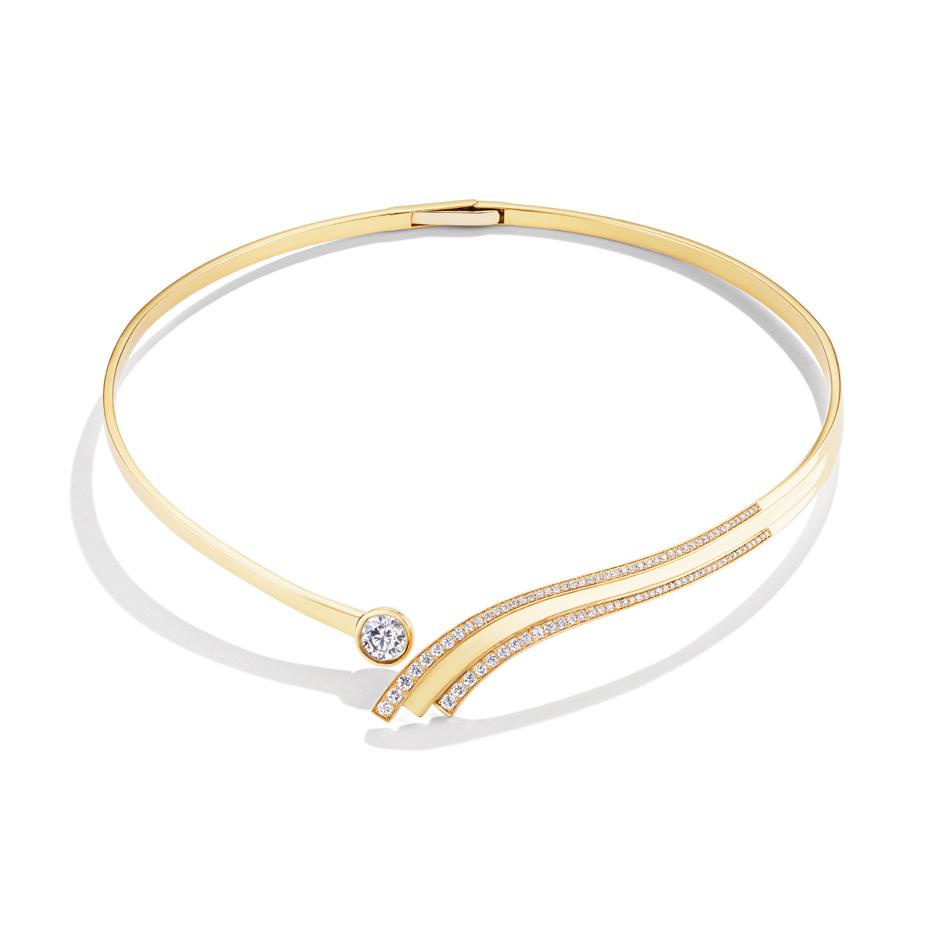
and make the form uniquely their own. Some texture the gold. Others might paint a pattern with enamel. All the best examples are something fierce. Or you could say badass, like what aviators are to eyewear—or a bomber jacket is to fashion.
Diamond chokers are the soulmates of torques. Of course, not all diamond chokers but the styles that are solid metal and have an arms and armor vibe. Some designers working the look are inspired by ancient torques but they have completed the circle on the design and transformed the concept into a choker. Others take design cues from the neck rings worn by the Maasai of East Africa.
Something that is actually even closer to what fine jewelry designers are making now is the ring chokers worn by Dora Milaje (pronounced “dora-meh-LAH-shay”) in Wakanda Forever. It’s a style that was closely echoed on the Golden Globes red carpet this year by Angela Bassett AKA Queen Ramonda of Wakanda. The regal actress wore a wide Messika choker punctuated with giant diamonds.
Angela Bassett is far from the only person to wear a solid statement diamond and gold choker on the red carpet. Amanda Seyfried sported an extraordinary Almasika collar with a languid line of 14 carats of diamonds flowing from one side to the next at the Time 100 Gala last year.
Jewelry designer Lorraine West ri ed on her signature neck rings, famously worn by Lizzo at the 2022 Met Gala, to create a hinged gold choker open in the front with large round diamond accents. Keke Palmer put on a divine design for the New York Film Critics Awards in December.
At the 2023 Screen Actors Guild Awards, Zendaya took the wide solid choker idea to even higher highs. The stylish actress, working in concert with her image architect Law Roach, paired her color blocked Armani Privé strapless cutout gown with a pavé-set diamond choker punctuated with colorful gems. The e ect was as empowered as could be. ♦
THE EDIT 2023 | 15 JEWELRY ARMOR
Written by JILL NEWMAN
JEWELRY





IT’S BACK AND EVEN BETTER
Brazilian model and singer
Alici wears Chanel earrings and Ann Demeulemeester top.
Photographed by Alexander Saladrigas.
Product clockwise from top: Sidney Garber earrings, Bernard James ring, Lizzie Mandler bracelet, Van Cleef & Arpels earrings, Beck Jewels ring, Akaila Reid ring, Uniform Object necklace.
16 | THE EDIT 2023
WHY WE CAN’T STOP LOVING 7O ’ s STYLE
O
7
We have the ‘70s to thank for some of our most iconic and empowering jewelry styles. There is Elsa Peretti’s Bone Cu and Diamonds by the Yard®, Aldo Cipullo’s Juste un Clou nail bracelet for Cartier, David Webb’s totem pendants, glam rock diamond hoops and statement medallions. The list is long. The jewelry was unapologetically bold, glamorous and expressive.
As we move toward bigger, statement jewelry in 2023, there are clear nods to our favorite ‘70s themes. You could say the jewelry is aligned with the latest fashion, which is true, but fabulous diamond jewels have never been just about trends. These stylish new pieces are timely—and timeless. When the fashion whims move on, the diamond hoops and signature pendants will stay relevant.


That brings us back to the here and now. Ask almost any stylist, and they will declare the ‘70s as their favorite era. “I always gravitate towards the 70s,” says stylist Elissa Santisi, who is a longtime champion of the ‘70s look. “It was a glamorous time, it was androgynous...men dressed like women and women dressed like men, there was sleek minimalism and bold, personal statements, there was a sleezy side and sexy and chic side.” Her favorite style icons of the era included Bianca Jager, Charlotte Rampling and David Bowie. And their expressive style is so relevant again right now.
Jewelry designers are embracing the strong ‘70s vibe, but let’s be clear, this isn’t a repeat. It’s a reference to the era’s defining jewels. Its influence is in minimalist, genderless designs, sexy torque collars and layers of long pendant necklaces. It’s in statement brooches and chunky cocktail rings, and glitzy diamond hoops and long drop earrings. It’s in symbolic astrological signs, hearts and butterflies and in pops of enamel color.

“That ‘70s feel is back and it f ilters into my psyche when I’m designing,” says Paul Morelli, who began designing his eponymous jewelry in the mid-’70s. That spirit comes to life in his ‘ultimate hoop’ earring. “It’s a big, well-engineered diamond hoop that is angled the right way and looks great on.” New bolder and heavier diamond necklaces with what he describes as having a “glam rock feel” also echoes the ‘70s vibe.
The ‘70s style conjures up images of caftan dresses with long bold pendants and denim shirts unbuttoned to reveal layers of necklaces, says Jennifer Alfano, a jewelry designer who also has the fashion blog Flare Index. “There was a simplicity and streamlined style of dressing in the ‘70s that I’m drawn to,” she says. Her new J case in gold with diamonds is a “love letter” to that era: it’s a large, hinged case that opens to reveal inscribed words or a drawing. And, she says it’s perfect over a caftan (or really anything).
It’s not that designers are nostalgic about the ‘70s, they are more empowered by it. As Marion Fasel, founder of The Adventurine explains, “It was a time when women started heading to the o ce in the masses, so jewelers had to change and create everyday work designs.”

She points to Van Cleef & Arpels’ Alhambra, Bulgari’s Monete (coins), long swinging necklaces and everyday diamonds (especially diamond stud earrings), as the new everyday jewels. Today, we are seeing new variations of these ‘70s styles.
The ‘70s style reminds us that one great statement piece (or layers of jewelry) is all you need to express your style, mood and independence. ♦

THE EDIT 2023 | 17
TREND
THE SECOND SKIN BANGLE
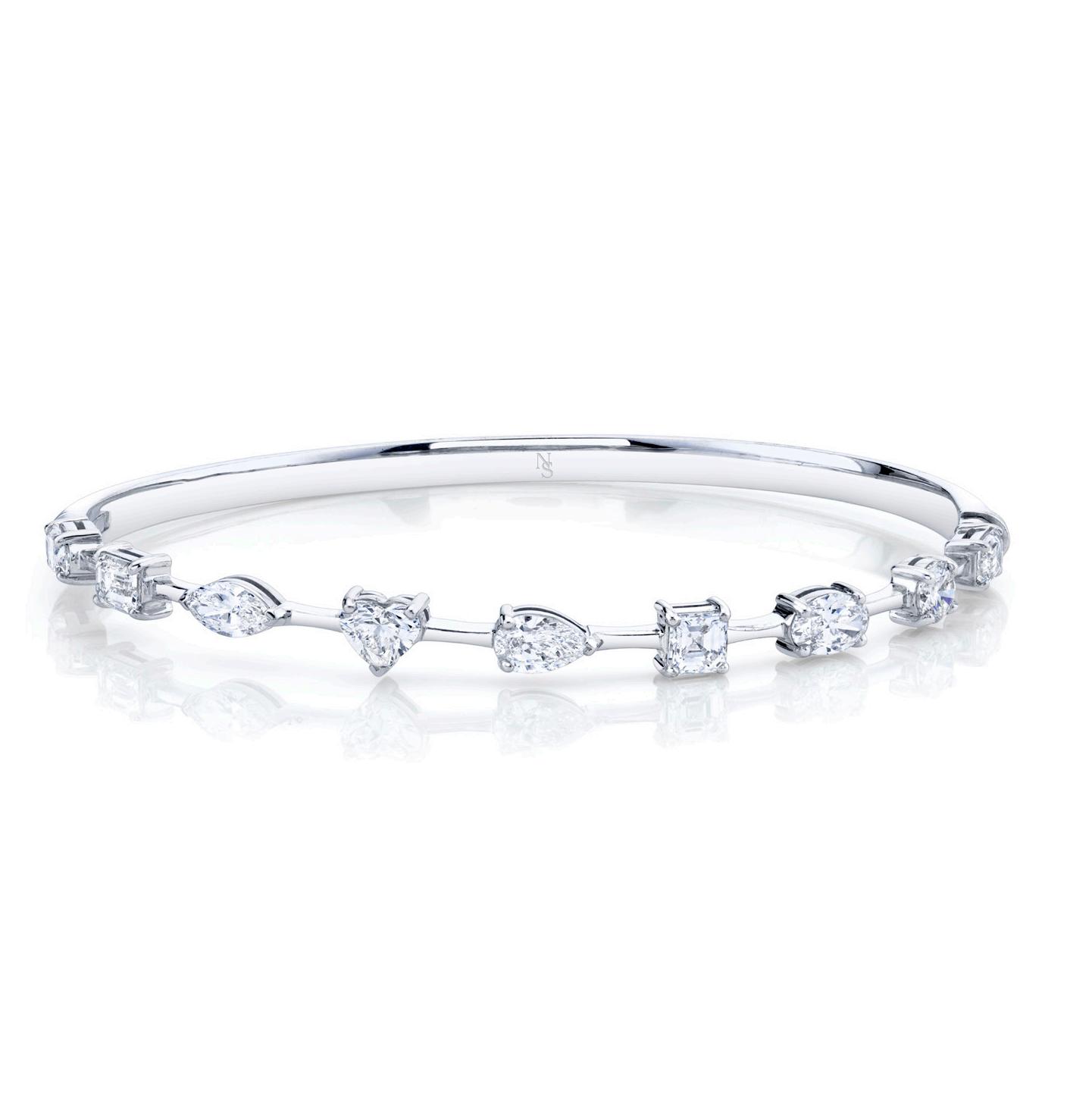
or stylish chaos.
It’s been a wardrobe essential for decades, so why all the fuss about bangles now? It’s this year’s signature accessory: it’s genderless, fashionable and versatile, and one is never enough.
Jewelry houses and countless designers are putting their own spin on diamond bangles. Today’s stylish options signify friendship, love, milestones and status. New signature designs, including Ti any & Co. ‘s Lock, Pomellato’s Together and Louis Vuitton’s Empreinte, are as recognizable as a status handbag: You can identify it from across the room.
SEXY IS BACK
There’s something sexy about slipping on a bangle and never taking it o . Now that fashion designers are bringing sexy back, the slinky and sparkling diamond bangle fits right in.
Cartier’s iconic 70s-era Love Bracelet—worn by style icons from Jennifer Aniston and Tina Turner to Tom Ford
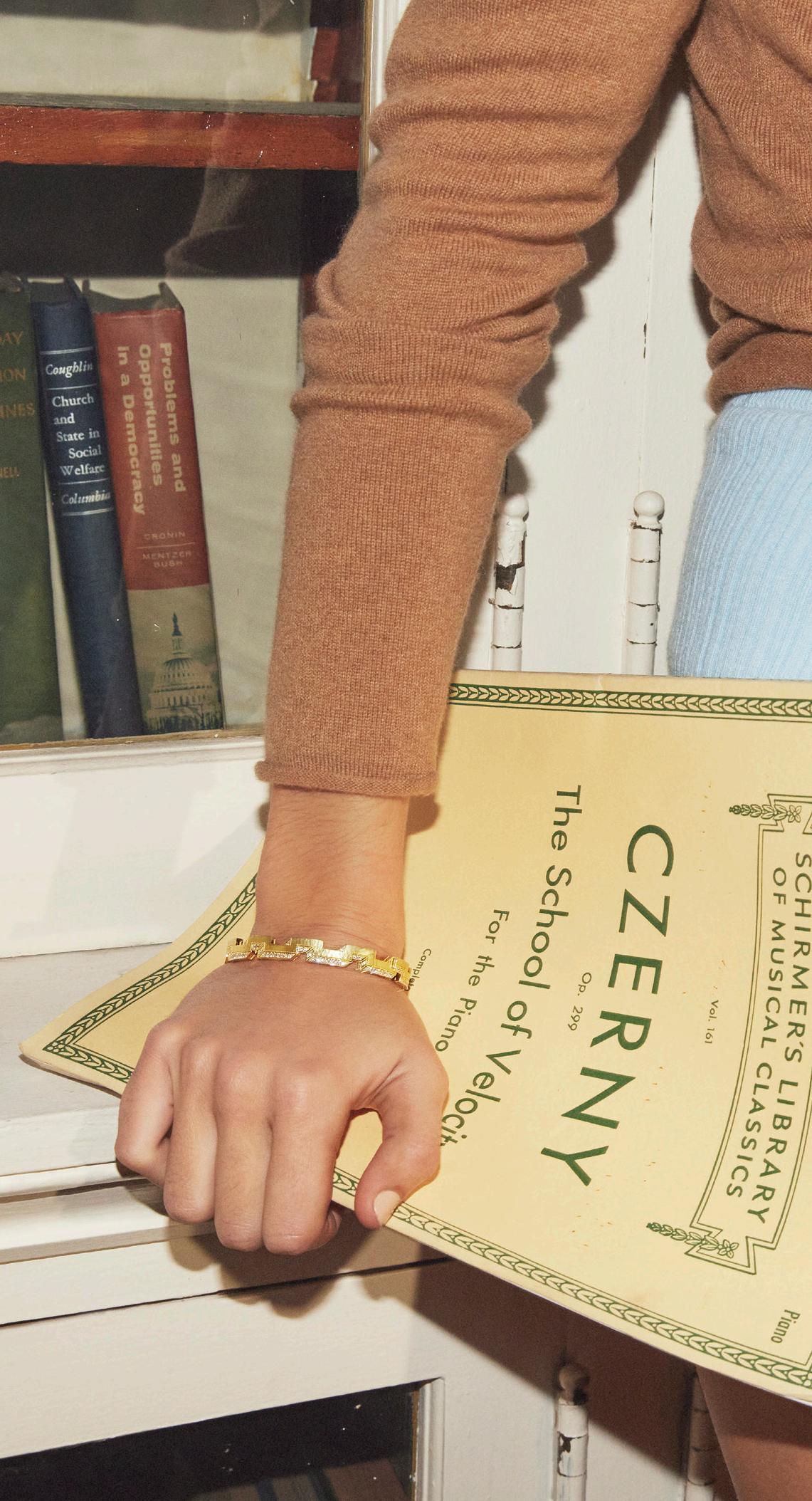
and Kendall Jenner—is an instantly recognizable status bangle (we love it with diamonds). It literally locks on the wrist with screws and requires a special screwdriver to open it. In a show of commitment, famous couples like Steve McQueen and Ali MacGraw, and Elizabeth Taylor and Richard Burton wore matching Love Bracelets; the romances didn’t last but the style endured.
The bangle’s symbolism was established long before designer Aldo Cipullo dreamt up the Love Bracelet in Cartier’s New York studio as a symbol of love and promise. In ancient times, the bangles denoted power, wealth and devotion. They were worn by Ancient Egyptian women as early as 2000 BCE, and by both men and women in ancient Greece, Rome and China. In Hinduism women still wear them as part of the marriage ceremony to reflect their commitment.
18 | THE EDIT 2023
STYLE
STYLISH AND SENTIMENTAL

For Victoria Lampley, owner of The Stax jewelry advisory, “the bangle marks milestones, time and relationships.” Her stack includes matching Ti any & Co. friendship bangles that she received from her mother on her 18th birthday (it never comes o ), and one she shares with her own daughter.
“I’m more of a maximalist in terms of jewelry,” says Lampley pointing to Iris Apfel’s signature armfuls of bold bangles as a great example of personal expression. While Lampley prefers to wear them stacked, she says a single bangle can look beautiful.
“I get wrist envy when I see a woman who has beautiful skinny bird-like wrists that are perfect for the bangle.” She lists Pippa Small, Beck Jewels, Octavia Elizabeth and Rosa de la Cruz for her favorite diamond bangles.

Another great thing about bangles is that they don’t require much thought; just slip one on anytime. Still, some of the simplest looks are, in fact, nuanced. “Scale and comfort are key to a bangle that you can live in,” says Anne Russell, Executive Vice President of Hamilton Jewelers. It should fit snug but easily move on the wrist, she says.

“The bangle is like a blazer; it can pull your look together and appear really elegant,” she adds. Hamilton’s most popular bangles are a stretch diamond style, Fred’s bangles with diamond clasps and Walters Faith’s Fluted diamond and gold bracelets. Russell suggests pairing a wider bangle with your signature timepiece or on the opposite wrist to balance your look.
Don’t be shy about piling them on. Go on and mix old favorites with new designs to refresh your wrist game. ♦
THE EDIT 2023 | 19
Zoe wears Vendorafa bangle, Guest in Residence sweater and briefs. Hailey Bieber wears Tiffany & Co bangles.
Photographed by Jennifer Livingston. Product from left to right: Norman Silverman, Heart The Stones.
Hailey Bieber
AKIMBO DIAMOND ENGAGEMENT RINGS
Written by MARION FASEL

razy in Love’’ isn’t just a chart-topping hit from Beyoncé. The idea is real— but you know that. Just think back to how you got butterflies in your stomach when you first met your true love. The sight of your paramour still takes your breath away. In short, you are a little o -kilter in the best of all possible ways. And now you are looking for an engagement ring to represent your romance.
Well, designers are on to this feeling as a metaphor in jewelry. It’s a tricky thing to do, but they have managed by turning diamonds a bit to the left or a bit to the right in engagement ring settings. In other words, the gems are o -kilter. Creating a pretty perfect design for what all the emotions feel like.
Where did this trend start? Honestly, no one is sure exactly. It’s a rarity that a jewelry trend doesn’t have a historical precedent. Yet there isn’t one. Sure, you might be able to find an example or two from the distant past, but good luck searching...
The contemporary market, however, is a di erent story. When the Style Collective behind this Trend Report got together and batted around the idea of the setting, just about everyone named a di erent label where they saw it first. The idea has definitely been in the air.
It was, for a time, also on the third finger of the left hand of uber-influencer Emily Ratajkowski. Mind you, this is not saying she was the first to wear a diamond set at an angle. The model-actress was perhaps just the most high-profile person to ever do it. The ring she conceived in 2018 with her now ex-husband, movie producer Sebastian Bear-McClard (and an assist from jewelry designer Alison Lou) had a princess-cut diamond with a pear-shape diamond set a little askew.
The Emrata jewel got a lot of attention at the time the couple was engaged, and it’s still a subject of fascination. The ring helped catapult two-stone diamond rings (also referred to as Toi et Moi designs) to the forefront of fashion. The angle on the pear-shape in Ratajkowski’s ring was also clearly a point of interest, because the mode has been popping up in two-stone rings for the last few years.
In the celebrity world of engagements, Ariana Grande’s husband Dalton Gomez proposed with a custom-made Solow & Co Toi et Moi ring in 2020 featuring a stunning oval shaped diamond set at an angle alongside a pearl. And there is Megan Fox’s engagement ring. At the end of 2021 Machine Gun Kelly worked with designer Stephen Webster on the jewel featuring a pear-shape diamond and a pear-shape emerald tilted towards each other.
While this trio of celebrity engagement rings are all two-stone designs, the new wave are solitaires. The solo gem makes the slant of the single stone the primary focus. After that each designer puts their own signature style on the concept.
So, you must be wondering: what’s this new look called? Well, it didn’t really have a name. Explaining the design as stones set “akimbo” resonated with pretty much everyone in the Style Collective immediately. One of the definitions of the word akimbo is “to one side” or “askew” which is exactly how these solitaires are positioned. Either way, the style is here to stay.
According to Broken English’s Laura Freedman, “The akimbo style is a fresh way to make a solitaire feel special.” Jewelry editor extraordinaire Jill Newman adds, “I expect we will see more women reset their classic engagement rings, turning their stones slightly askew to create akimbo rings.” ♦
20 | THE EDIT 2023 ALL THE RIGHT ANGLES
“C
STYLE

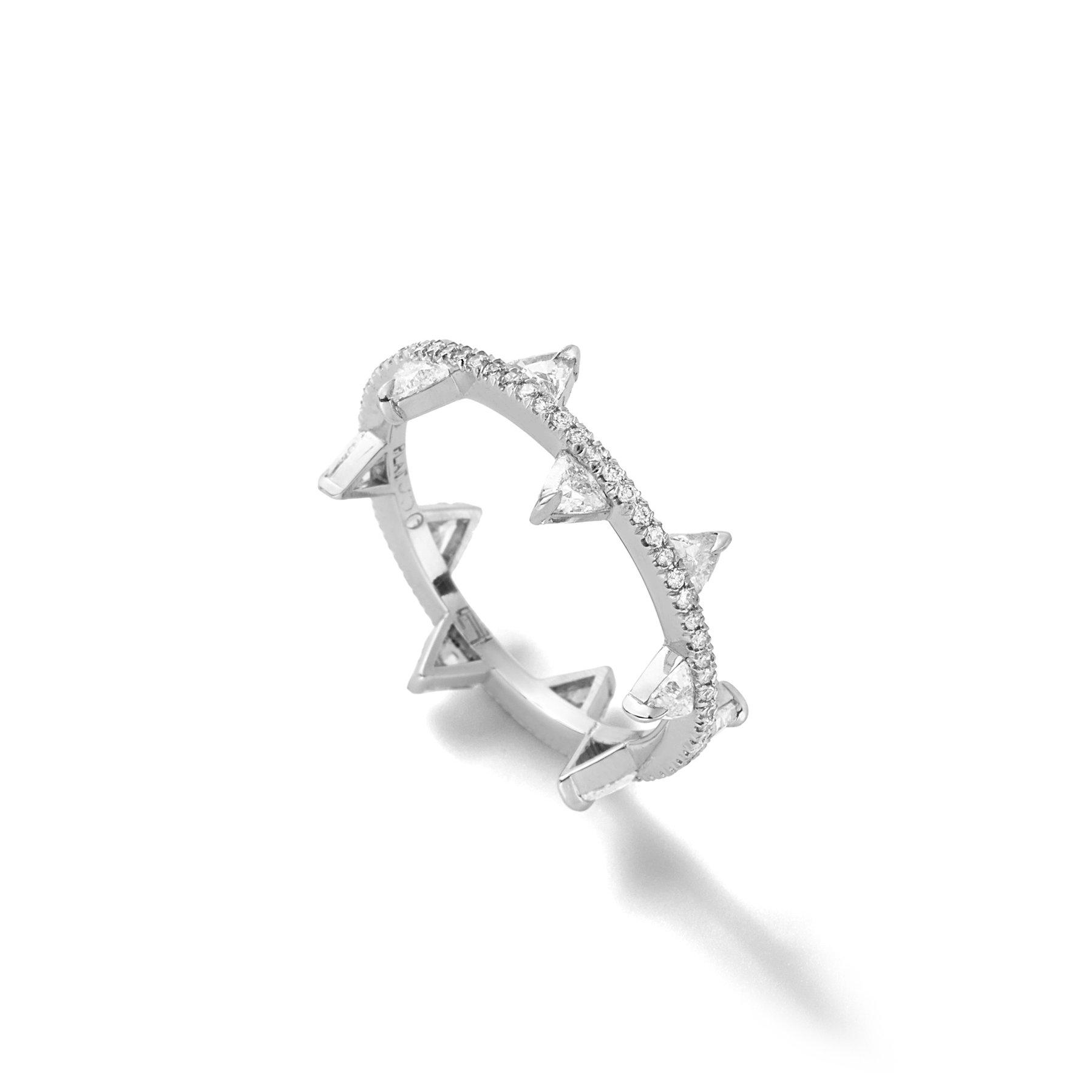


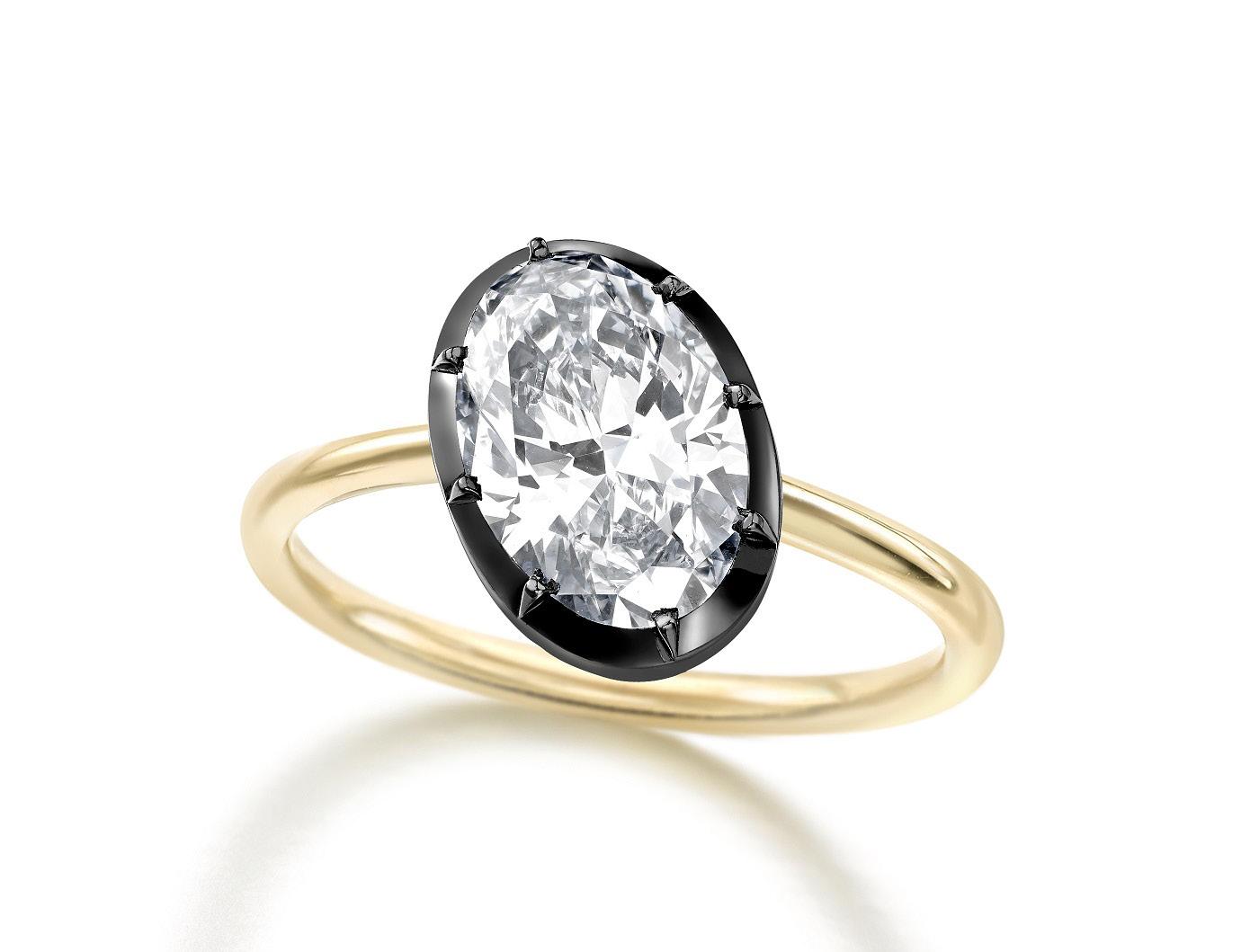
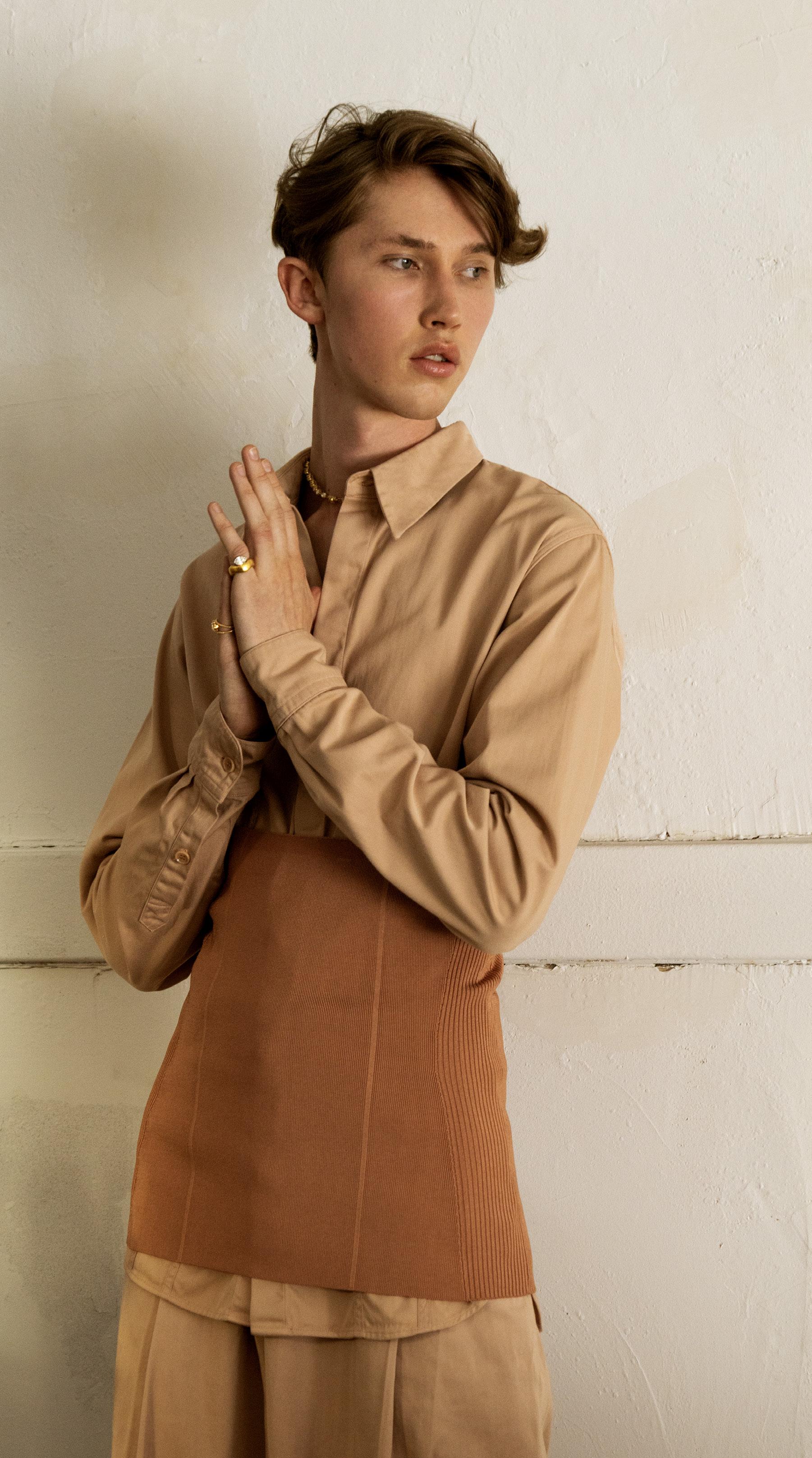
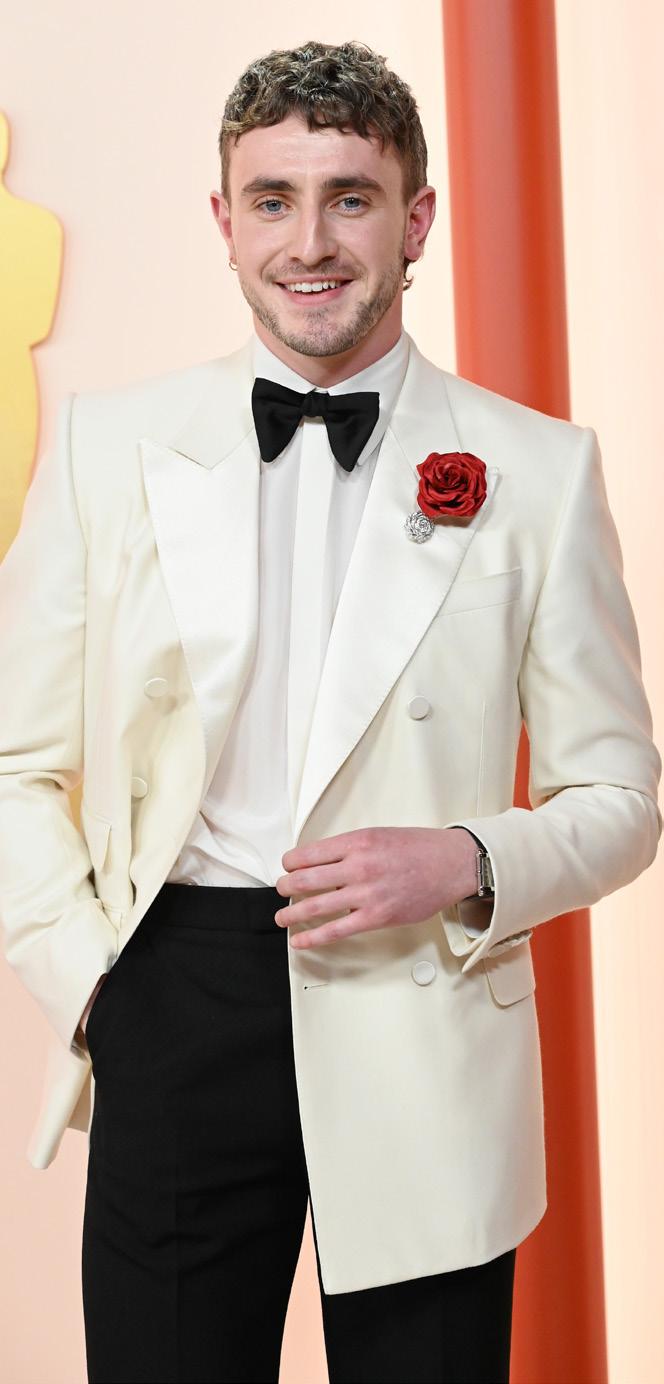
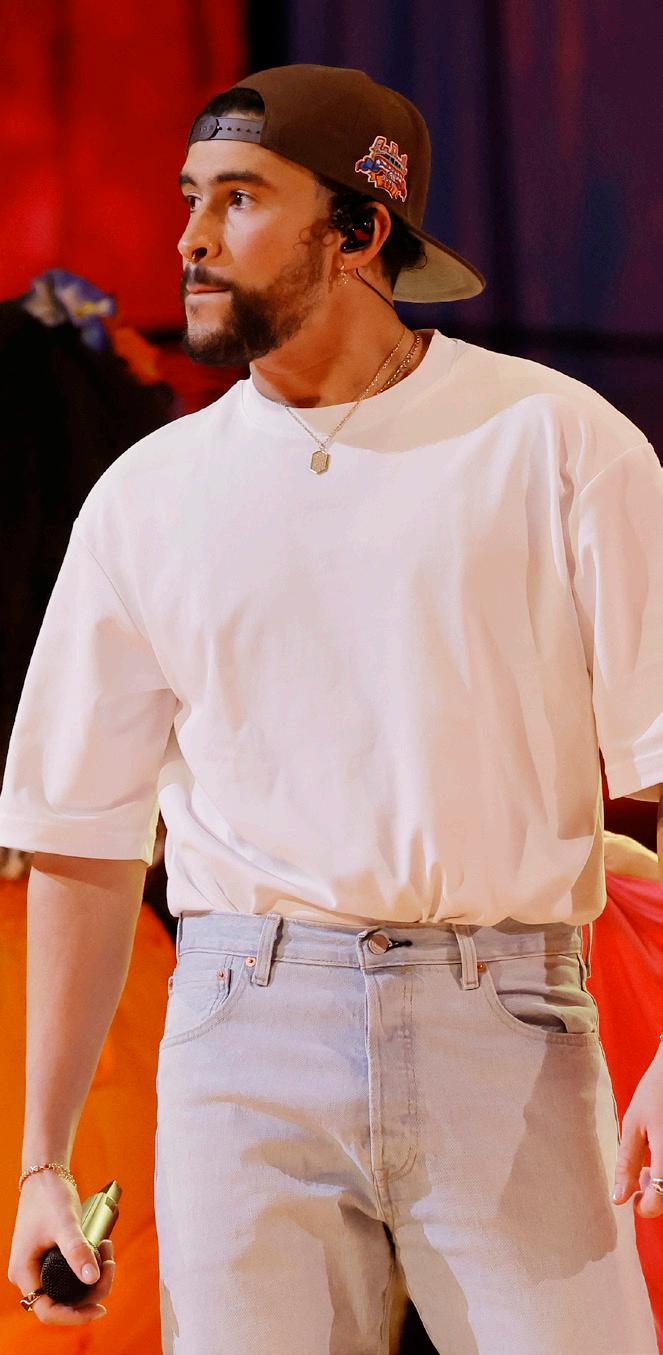
22 | THE EDIT 2023 STYLE
Clockwise from left Paul Mescal wears Cartier brooch. Daniil wears Jade Trau ring, Belperron ring, Sorellina necklace, Dries Van Noten top, cummerbund and pants.
Photographed by Mark Lim. Bad Bunny wears Marvin Douglas necklace.
SEARCHING FOR PERMANENCE IN A TRANSITORY WORLD
Written by JOSH PESKOWITZ
023 feels like the end of something as much as it feels like the beginning. It is a year of transition, as the world moves on from the pandemic and into something new. Few of the things that were broken in the plague years will be put back together the same; this is largely for the better. The only constant may be change, but many of us were stuck in our old ways and felt as if it would go on forever. But hegemony has broken, and the globe is topsy-turvy. Men and women are searching for something tangible to hold onto. Billions-of-years-old diamonds and precious metals that were birthed in supernovas can feel like a talisman or a bulwark against the chaos beyond our doors and between our ears.
Generations are changing. Millennial and Gen Z men have a di erent attitude towards fashion, style, consumption and gender norms than their predecessors. How all this plays out is yet to be determined, but we know a few things to be true. First is that social media has changed everything—but invented nothing. We have reached an inflection point where pretty much anything that has ever been in style is all on trend now. Images that are pulled together from di erent decades, regions and subcultures are all in our feeds right now. The lack of context can lead some to choose their own style adventure and give us some very interesting new combinations. It can lead others into existential paralysis without any grip on what’s appropriate to wear and when. Jewelry su ers from neither of these problems; it is inherently less trend-driven and meant to feel personal. The personal can still feel universal: everyone can recognize the chicness of a diamond pendant or tennis bracelet—both of which are enjoying a glinting moment in the sun.
Secondly, many men wear the same jewelry (or a small rotation) daily and it becomes part of their essential character. In choosing jewelry, men choose to enhance their individuality no matter what clothing “style” they tend to favor. A monochrome man may love colorful stones; a fully patchworked and mohaired dude might love a simple Figaro link bracelet.
Speaking of Figaro links, they are more popular than ever, in
addition to Cuban Links and even Herringbone, as they speak to a simpler time and are as universally loved as anything in men’s jewelry could be. Adorning the wrists and necks of men from every walk of life, demographic set and style inclination, they are enjoying a resurgence that borders on being trendy.
This means that, thirdly, even though trends are dead, there are still trends. Many of them are encompassed in the most significant macro shift in many generations. This is the breakdown of gender norms in jewelry. Led by athletes, musicians, actors and folks on the street the refreshing result is multitudes of adornment choices open to men that would previously have been scorned. Look to Michael B. Jordan draped in Ti any & Co. pearls for February’s Rolling Stone. Rappers such as Tyler, the Creator, and designers such as Charaf Tajer of Casablanca are similarly and regularly festooned. Actors like Timothée Chalamet and “regular” fashion show attendees have opted for diamond broaches (Chamalet most notably on the steps of the Met Gala) creating moments of inspiration and acceptance. Bad Bunny’s dangly earring and advanced fashion choices haven’t hurt his rise to be the highest charting Spanish language artist in history.
These guys are unafraid to use sex appeal, and the trickle down can be seen in the louche ‘70s aesthetic percolating through youth culture. It’s empowering to men to be able to present their sex appeal more broadly, especially in atmospheres that have traditionally been focused on ultra (and many times toxic) masculinity. Case in point: Paul Mescal’s swingin’ dinner jacket/broach combo at this year’s Oscars. A similar trend towards smaller and more delicate timepieces has overtaken the fine watch world only recently dominated by pieces more reminiscent of a heavyweight title belt than complicated wristwear.
Lastly, whether they ascribe to a minimalist or maximalist philosophy for their jewelry, men look at their pieces as an investment. Natural diamonds are indeed forever, and that feels reassuring at a time when we are constantly reminded of our impermanence. Be it a locked bangle (like Ti any & Co.’s hugely successful launch), a tennis bracelet or a stack of both, the idea of having something solid and precious with you—and to you—at all times is reassuring. ♦
THE EDIT 2023 | 23 MEN’S TREND REPORT
2
JEWELRY CITIES
 Written by LYNN YAEGER
Photographs by ANDREW WERNER
Written by LYNN YAEGER
Photographs by ANDREW WERNER
Some people travel to visit far-flung museums, or seek out gastronomic experiences, or climb the highest mountain, or trek through deserts, or just lay on a beach and stare at the sky. Not me. When I am lucky enough to embark on a trip, the first thing I do is google “Antique Jewelry” and the name of the city. What could be more fun than uncovering an o -the-grid shop or vintage market, in search of the perfect diamond souvenir? You will be happy to know that I seldom fail in this quest, and my jewelry box is bursting with exquisite keepsakes. Here are some of my favorite finds from five of my favorite cities, with the back story of how I unearthed them.
24 | THE EDIT 2023
STYLE
1. PARMA, ITALY
I love Italy, and I don’t get there nearly as much as I would like. But a decade ago I did manage to f inagle a press trip to the vast Mercantein f iera in Parma—hundreds of dealers in football- f ield size halls—everything from the hugest pieces of furniture—oh, to be able to get these home! to a Lenci toy of Donald Duck’s nephew on skis (ok, I bought this) to the fabulous diamond bracelet you see here. I thought the way its lacey Belle Epoque diamonds contrasted with the chain links was unusual—is this the original piece, or did some enterprising designer put these two elements together? Who knows? It’s part of the mystery, and the thrill, of antique jewelry.

2. LONDON

When I am in London, which is a few times a year (Fashion Weeks!) I hit all my favorite spots—Portobello Road on Saturday morning (the earlier the better); Alfie’s Antique market—great for vintage clothes in addition to jewelry; and the upscale Grays Antiques Market, where, as a young girl, I first saw a huge 1920s portrait diamond and nearly collapsed with desire. This hatching chick is from Grays—I looked at it for a long time and finally the dealer, realizing that there was an audience of one for an egg-and- chick (which came first?) lowered the price su ciently. He is gold topped with silver and I suspect dates from the mid-to-late 19 th century.
3. NEW YORK
My hometown!
So many diamond jewels I could show you that I have bought here over a lifetime, but I have settled on these two Victorian snake rings, since I wear them virtually every day. The first one, two intertwined serpents with a cabochon sapphire and a diamond in their respective heads, was purchased in 2008 from DK Bressler on 47 th Street. The second I bought only a few months ago at the legendary Fred Leighton on Madison Avenue. Leighton shares its space with Kwiat, and I was in the house to interview diamond expert Greg Kwiat for Only Natural Diamonds. After we talked, I cruised through the Leighton side of the shop, and in one of the cases saw this creature with a single diamond—but a lovely big one—sunk into his noggin. I was toast.

26 | THE EDIT 2023
STYLE
4. PARIS

I will admit that in Paris I have been known to contort my entire schedule to accommodate my two favorite markets—maybe in the whole world!—the charming Porte de Vanves—weekends only and closes up by noon—and clear on the other side of town, the massive Clignancourt Marche des Puces. (If you are nuts like me, you can do both in one day-- that is why God invented Ubers.) If there is no wonderful diamond jewelry to be had at either place (unlikely, especially given the highend dealers at Clignancourt) there are other alternatives. Many fancy street fairs set up for a few days or a week at di erent locations, and these can be found by referring to the following indispensable website: https://vide-greniers.org. It was at of the markets, in a tony neighborhood near the Arc de Triomphe, that I found this incredible brooch, in what appears to be its original box. It spells out Souvenir in diamonds, which means “Remember” in French—and of course I do.
5. LAS VEGAS
You might think that when I am in Sin City for the annual Couture jewelry show, I would spend most of my time at the Las Vegas Antique Jewelry Show, which takes place at the same time as Couture. But life—and jewelry—are full of surprises! Over the years, I have found myself increasingly enthralled by the designer jewelry at Couture, so much so that—at least for a few afternoons—antiques actually take a back seat. Here are three rings I cherish and that I found at Couture, from a pair of designers who have become friends—the two birds in flight are by Arman Sarkisyan, and the gorgeous star is from Selim Mouzannar. They all mix beautifully with my antique pieces, which only goes to show that diamonds are always ready to make friends with other diamonds. ♦

THE EDIT 2023 | 27
THI NK YOU KNOW DIAMONDS?
MEET LILY IN BOTSWANA
Following the Journey of Natural Diamonds was Life-Changing for NDC’s Global Ambassador.
 Written by JESSICA IREDALE
Written by JESSICA IREDALE
Photographs by MOLLY SJ
LOWE
SUSTAINABILITY
Lilly James in the Orapa Game Park in Botswana. One of eight conservation sites funded by De Beers Group around Southern Africa

“Who are we going to see?” Emily Mompe, the class’s teacher, asked the room of 8 and 9-year-olds. “Lily James!” they answered in unison.
The children were high on the anticipation of meeting James, the English actress who is known for her roles in Pam & Tommy, Rebecca, Baby Driver and Downton Abbey. The kids knew her as Cinderella from her part as the title character in the 2015 Disney film version of the classic fairy tale. When she arrived, the students’ reaction progressed from shy shock and awe to emboldened engagement and curiosity, as they plied her with questions: How did you become an actress? Where do you live? “Can I have your phone number?” as one boy inquired.
“Would it be weird for a 33-year-old woman to give an 8-yearold her number?” James said, mostly joking, later in the day.
The meet-and-greet was of mutual benefit. The kids got to meet a Disney princess in the flesh; James got to see the heartwarming fruit of Botswana’s diamond industry, of which she is now the global face in her new role as ambassador of the Natural Diamond Council.
The Livingstone House Primary School, an elementary school with a student body of 600, ages 6 to 13, is a direct result of the economic development driven by natural diamonds. Speci f ically, the school is one of four in Orapa funded by Debswana, a 50/50 joint venture between De Beers and the government of Botswana, which provides free primary and secondary school education to every Botswanan child.
James was in Botswana to get an education herself. When she signed on to be the Natural Diamond Council’s ambassador, it was not to play a character. Part of the deal was seeing exactly what she was representing. On the ground research was required. Her trip included visits to almost every part of the local diamond value chain — the Karowe Mine, De Beers Global Sales, KGK Diamonds cutting and polishing unit — as well as witnessing the reverberative e ects on the surrounding communities and wildlife, via a school or the Orapa Game Park.
“You want to make sure when you’re putting your name to something, that there’s more to the story,” said James, who had done her due diligence on Botswana’s history with diamonds as best she could without witnessing it f irst-hand. Prior to working with the NDC, her passing knowledge of the country came from a good friend from boarding school in England who had grown up there. “She was always talking about Botswana. She had initially wanted to be a conservationist and studied geology at university, so that all comes from here,” said James.
“Part of all of this is about breaking down any stigma and really telling the true diamond story,” said James. “Particularly with regards to Botswana, the ethical side of it was a massive draw. It would be something I would be able to talk about because I would care rather than just being like, ‘Oh, a luxury good.’ Being here is seeing the value and the human aspect of it. It feels so genuine and real and powerful.”
“Part of all of this is about breaking down any stigma and really telling the true diamond story.”
Visiting the Livingstone House Primary School was one stop on an intense three-day trip to Botswana during which James was indoctrinated into the country’s unique relationship with natural diamond mining, which at 33 percent is the largest contributor to the country’s GDP. Botswana was a British Protectorate from 1895 to 1966 when it declared its independence. Diamonds were discovered the following year and the mineral is owned by the country per the prescience of the country’s first president Sir Seretse Goitsebeng Maphiri Khama, who decreed that any diamond found in Botswana belonged to the people rather than the individual. Any diamond-related industry is conducted via a licensing agreement with the government, which puts more than 80 percent of diamond revenues back into the country’s economy. That governance has allowed for the development of a large middle class in Botswana, as well as investment in critical infrastructure, such as hospitals, roads and schools. ithout diamonds, we wouldn’t have a country,” said Pat Dambe, Vice President of Market Outreach at De Beers Group, noting that at the time of Botswana’s independence it was the third poorest country on the African continent. “We practice, as a result of our culture, that we’re all together. In unity, there’s
30 | THE EDIT 2023
By 1:30 pm on a Monday afternoon in Orapa, Botswana, a mining town over 300 miles from the country’s capital Gaborone, the classrooms at the Livingstone House Primary School had emptied for the day. Except for one. The students in third grade had stayed late, not as a punishment but a reward.
SUSTAINABILITY



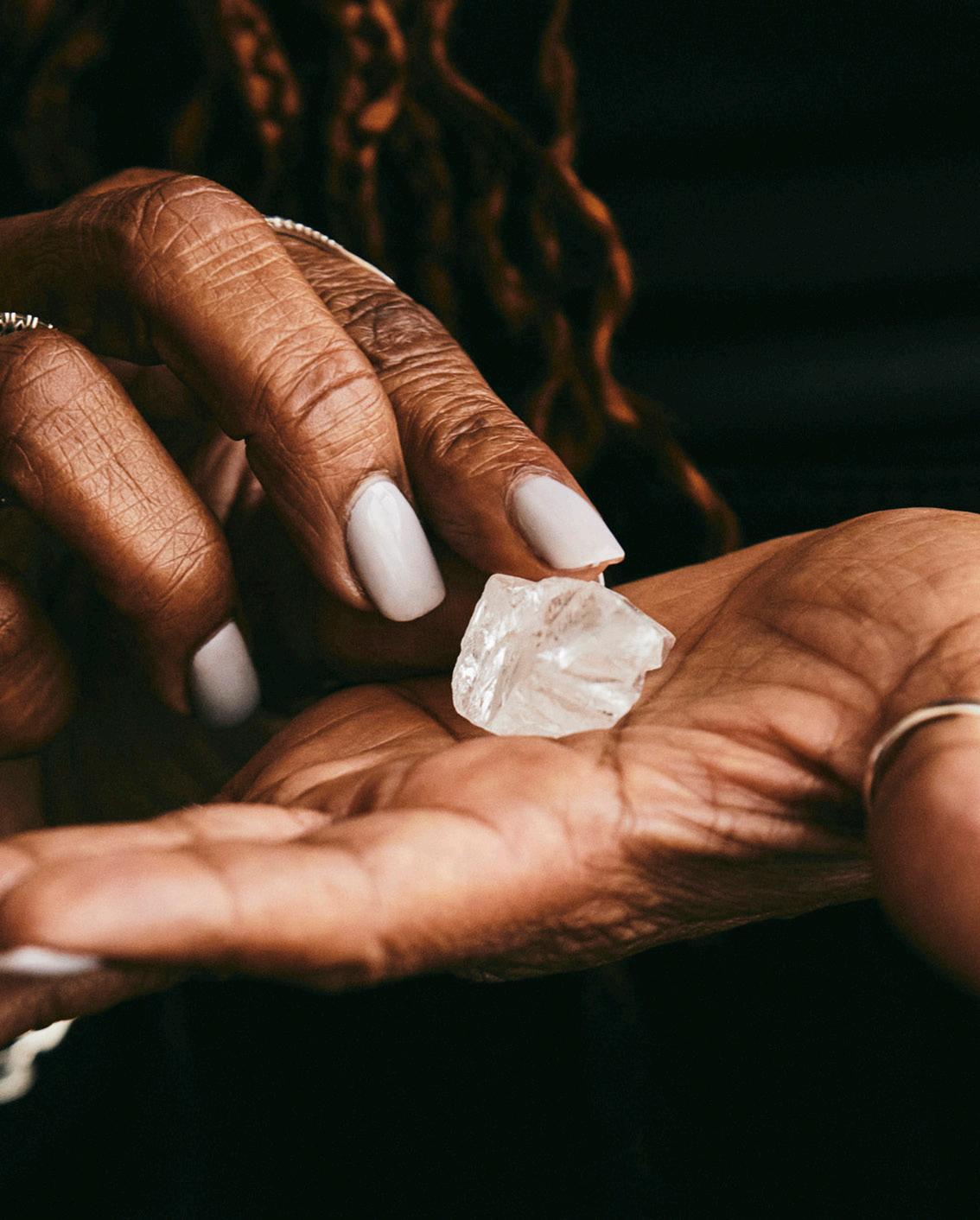
THE EDIT 2023 | 31
From top left: Lydia Tendy, De Beers Diamond Valuator separates rough diamonds; A De Beers expert examines rough diamonds; an exceptionally large rough diamond; Pat Dambe, De Beers Vice President Market Outreach examines natural fancy color rough diamonds
strength. The average person you speak to here has a good education, thinks about their children going to school, has a house.”
Emily Mompe attended the Livingstone House school years before she became a teacher there. “When I think of Orapa in the 80s versus what we have currently, it’s one of those things that you need to live here to believe it,” she said of the development in the area. “We used to have bumpy roads and now, of course, paved roads. We used to have a clinic the size of a three-bedroom house and now it is a hospital. We had no secondary school in my day, now we have two junior secondary schools and a senior secondary school.” Mompe’s classroom has a smart board that was essential for remote learning during Covid. Swimming is an essential part of the curriculum and there are three pools among the local schools, all heated during the winter so that the kids can still swim when the temperature drops.
“We are not just concerned with academics,” said Mompe. “We want to provide for the whole child.”
Many of the students’ parents are employed by the natural diamond industry yet the students themselves are raised to envision life beyond diamonds. “I asked them all what they wanted to be when they grow up and the answers were presidents, vets, doctors, rappers,” said James. “They were so bright and so ambitious.”
Such progress is directly connected to the economic impact of the natural diamond industry at large, but also locally. Orapa is home to two active diamond mines — the Orapa mine, owned by De Beers, and the Karowe mine, owned by Lucara, which James visited a few hours before going to the school. On a purely superficial level, the Karowe mine is a sight to behold to those unused to seeing a mine up close. The open pit descends to a depth of 324 meters and is traced in graphic, linear paths that carry trucks to the mine’s lowest point. It brings to mind something out of Star Wars.
Relative to other mines, Karowe is small, yet in the 10 years that Lucara has been operating it, the mine has yielded an

32 | THE EDIT 2023
Lily James with Eira Thomas, CEO Lucara Diamond Corp, and Naseem Lahri, Managing Director, at the Karowe Diamond Mine. Opposite page: Lilly James with Emily Mompe, Teacher at the Livingstone House Primary School; Lily James with students at the Livingstone House Primary School
inordinate number of large, high-value Type IIA diamonds. “We are the only mine in world history to recover three diamonds in excess of 1,000 carats in size,” said Lucara’s ceo Eira Thomas, presenting some of Karowe’s key stats to Ms. James. Some of Karowe’s most high-profile, record-setting stones including the historic 1,758 carat Sewelô, which was purchased by Louis Vuitton; the 1,109 carat Lesedi La Rona, which was purchased by Laurence Gra , and the 813 carat Constellation, which sold for a record $63 million.
It would be impossible not to be impressed by diamonds of such size, but what James found equally if not more inspiring was the people behind Karowe’s operation. “The first thing that hit me was Eira, whose story is incredible in itself,” said James.

Thomas, a Canadian geologist by training, is the one who bet big on Karowe. Lucara purchased Karowe in 2010 and began unearthing its bounty of enormous stones. Mines have a lifespan and originally Karowe’s was estimated to run through 2026. During her presentation to James, Thomas noted that Lucara had secured $550 million to expand the mine a further 800 meters underground, extending its life to at least 2040. That means more jobs, more growth, more progress and stability in Orapa.
In addition to these remarkable stats, Thomas, a female CEO in the world of mining, said that 31 percent of Karowe’s workforce is female and 75 percent of its executive committee is female. That includes Naseem Lahri, the f irst female
managing director of a diamond mine in Botswana, and the youngest female MD in mining in the world. Lahri oversees Karowe’s operations from the ground up — and down — but also how it impacts the surrounding community.

Karowe supports 18 villages, reinvesting in their economies and communities via healthcare, education, agriculture and Gender Based Violence initiatives. For the most part, Orapa relies on food imported from South Africa. When Covid restrictions closed borders, the local villages had to rely on their own agricultural cull. The poorest of the 18 villages developed its own vegetable and chicken farm, growing, thriving, generating food, jobs and income to the point that it’s no longer the poorest village. The farm is run by a woman and 90 percent of her sta are women.
“Naseem told me that they were tracking the schools in these villages and there was a gap where the girls weren’t going to school,” said James. “They found out they didn’t have access to sanitary towels so they weren’t able to go to school. Now, Karowe is providing that for free. It’s such a simple thing but the impact is huge.” ahri said Karowe has a record number of females in its workforce for a reason.
“They’re seeing females in the forefront and more women are actually coming to apply for jobs here because they know it can happen,” she said.
The holistic relationship between Botswana’s natural diamond industry and its people and land is evident at every point
THE EDIT 2023 | 33
“We are not just concerned with academics, We want to provide for the whole child.”
SUSTAINABILITY
–Emily Mompe
of James’ tour of the country. Adjacent to Orapa’s tiny airport is the Orapa Game Park, one of eight conservation sites funded by De Beers Group around Southern Africa. Just before sunset on the day she arrived James took a tour along a select route of the park’s nearly 50,000 hectares to see the wildlife reserve’s protected black and white rhinos, zebras, gira es and impalas. She got an education on the animals and awesome scenery as well as Debswana’s mission of conservation. “For every acre of land mined, they set aside six for the protection of the animals,” said James.
James’ trip follows the route of the “rough” mined in Orapa to the city of Gaborone, where much of raw material ends up in the hands of diamond cutters, such as the employees of KGK Diamonds, the largest diamond cutting and polishing facility in the city. Run by Siddarth Gothi, KGK has circularity and sustainability built into its entire operation in Gaborone. There’s an on-site creche to care for the employees’ children, a vegetable garden used to make company meals, and the building is outfitted with solar panels and water-recycling technology.
Many of the employees are young locals, who enter a training program that often leads to full-time employment. KGK prioritizes disadvantaged young adults, many of whom are disabled or lack access to advanced education. Armstrong Gabanamotse is a 23-year-old polisher who started with the company in 2019, learning how to scan and polish stones to take them from rough to brilliant cuts with as little waste and breakage as possible. Now he operates KGK’s most technologically advanced machine, the Optimus, to yield fancy cuts — pear, heart-shaped, oval,
marquis, emerald. He says he’s proud to work at KGK because diamonds gave Botswana an identity. “From rough to the final product, when you look at it, it gives you a smile,” Kamanan said. “I’ve made something shine.”
One of the final stops on James’ trip is the De Beers Global Sightholder Sales, where rough diamonds from all over the world are sorted and sold. More than 32 million carats in diamonds passed through the building in 2021. Security is understandably tight. All guests are scanned and monitored through multiple checkpoints as the enter and exit the building. Allowing outsiders, especially an ambassador like James, to witness the diamond value chain is worth the security risk in the eyes of Susanne Swaniker, De Beers Global Sightholder’s CFO. “Sometimes people think we have the ‘mineral curse,’ but we have positive stories,” she said. “It’s important for somebody from outside Botswana to understand how an individual on the street can actually have medical care, schooling, basic housing, water, electricity in their house because of these revenues.”

Inside, dozens of specialists value and sort the rough stones, group and pricing them for customers. A young diamond valuator Lydia Tendy leads James through the sorting room, placing exceptional stones of up to 100 carats in her hands. In many ways, this is the moment that crystalizes everything for James.
“You really feel the power,” she said. “This is Mother Nature. These stones were created billions of years ago, lifted up to the earth’s surface via volcanoes. They really do feel quite miraculous. To be in Botswana and see the e ect the stones have on the community, the value of them has only grown in my eyes.” ♦
34 | THE EDIT 2023
SUSTAINABILITY
Lily James with Siddarth Gothi, Lead Manager of KGK, and Josephine Basinyi, at KGK Diamonds. Opposite page: Giraffes in Orapa Game Park; Josephine Basinyi at the KGK Diamonds farm; Ompatile Galaletsang, Assistant Conservation Officer at Orapa Game Park; Rhinos in Orapa Game Park

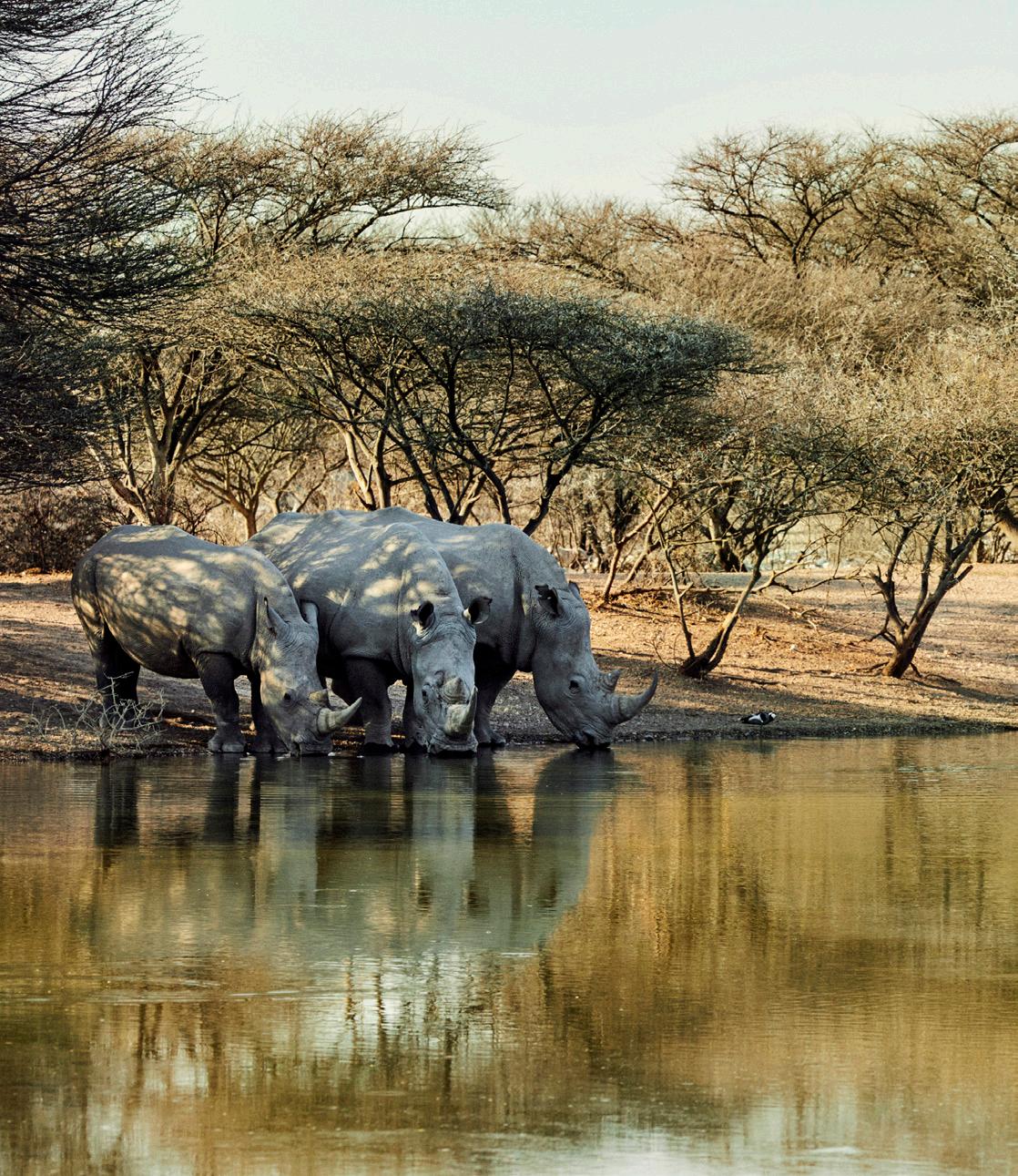
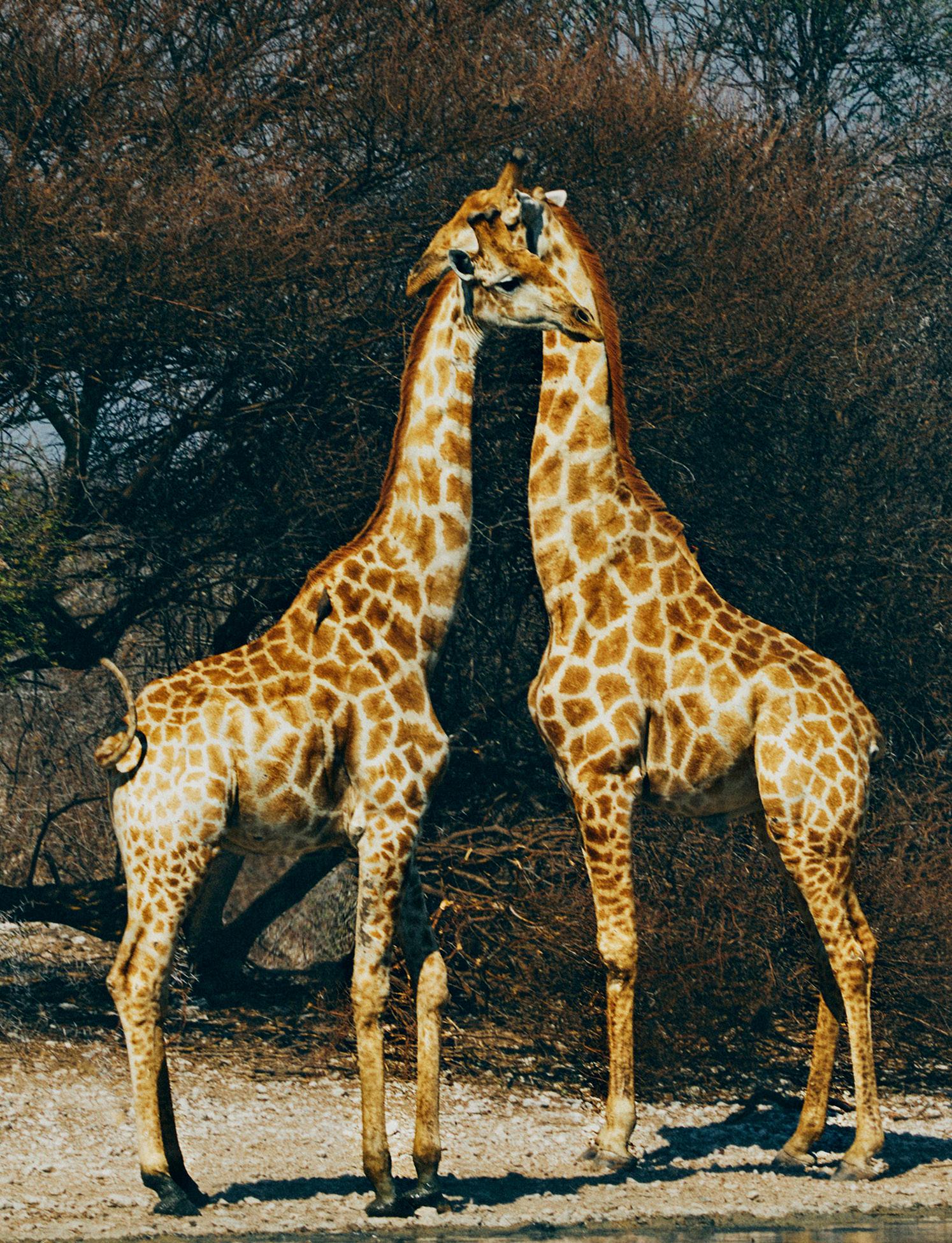

THE EDIT 2023 | 35
THE MILLION DOLLAR RAVEN COEXISTING WITH NATURE IN NATURAL DIAMOND RECOVERY

 Written by GRANT MOBLEY
Written by GRANT MOBLEY
At an American Gem Society conference in April, a Colorado School of Mines geologist told the group that “everything that is not grown on Earth is mined.” The more I thought about this statement, the more I realized how true it was. The raw materials for nearly everything we use are excavated from the Earth. Whether it is your cell phone, computer, the sheetrock in your house, the pipes in your walls, playground equipment, solar panels, or bicycles, every one of these items and countless others are made from materials extracted from the ground. Evidence shows humans began mining up to 40,000 years ago. So, how do we continue to live in a world where mining is essential without negatively impacting our natural environment? Diamond miners have shown it’s possible.
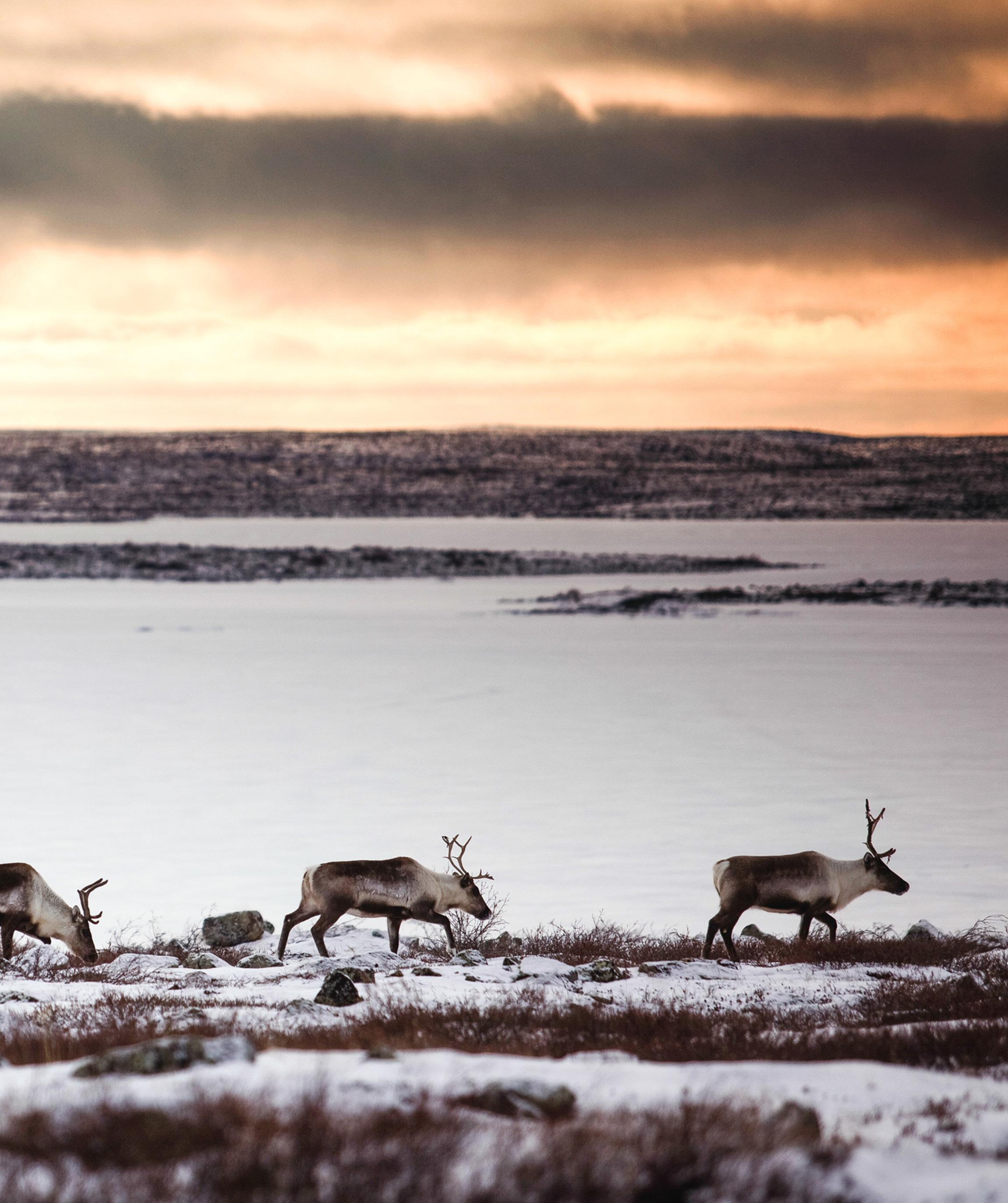 Wild caribou roam the area near the Ekati Diamond mine in Canada’s Northwest territories.
Wild caribou roam the area near the Ekati Diamond mine in Canada’s Northwest territories.
SUSTAINABILITY
Canada is the world’s third-largest producer of diamonds. Most of those diamonds are found in the tundra region of the Northwest Territories, north of the 60th parallel, close to the Arctic Circle. Upon arriving here, you are struck by the vastness and beauty of the treeless landscape dotted by a seemingly infinite number of lakes. “The land of the midnight sun,” as they call it, since for several weeks in the summer season, the sun never fully sets. By contrast, if you were to see it in winter, that same landscape would be one endless sheet of ice and snow, and the sun would seldom make an appearance.
In this pristine environment, you can find Canada’s first diamond mine, Ekati, which in the local Tlicho language means “Fat Lake.” Exploration and development work began in 1981, with Ekati o cially producing diamonds in 1998. The Ekati Mine and surrounding areas would be the main focus of my visit. Speaking with mine employees, government of f icials, locals, and Indigenous community leaders of the area, the common thread among them was pride. Proud that the most desirable luxury good on Earth comes from their backyard and is recovered in a way that sets an example for mining industries worldwide.

Jonas Sangris, former Chief of the Dene First Nation of the area, recalls when diamonds were first discovered in the area. Sangris was Chief of the Dene people at the time of the first diamond discovery in Canada and took part in the negotiations with the government and industry to open the mines. He recalls little, if any, benefit to the area from other mining operations before this time. However, upon the discovery of diamonds, they would make sure that would change. Working together with all the stakeholders involved, they could outline plans for how the mine would operate with respect to the Dene people and environment.
Canada’s diamond mines are now recognized as global leaders in sustainability, and the Mining Association of Canada’s Towards Sustainable Mining (TSM) standard is a globally recognized sustainability program that supports mining companies in managing key environmental and social risks. Before a diamond mining project can begin, an independent review board completes a comprehensive environmental assessment to mitigate environmental impacts through various tools and measures. One of these tools is creating a Socio-Economic Agreement (SEA). SEAs set out commitments and predictions made by a company regarding their impact, the progress of which is continuously monitored and published in a yearly report to the Government of the Northwest Territories. he pristine environment in the Northwest Territories and its preservation are a driving force for the local people in pushing for such strong environmental protection and regulations that seemed ahead of their time in the 80s. Walking around the mining area, this beauty is everywhere. A family of wolves with three newborn cubs had settled near the location. Trying to get closer and closer, mine employees remind us that we must keep a speci f ic distance with absolutely no interference. This point was evident later when a grizzly bear was spotted roaming an area not far from where the wolves had settled. Most people would want to do what they can to protect the newborn cubs from the exceedingly close grizzly bear. Still, just like nature photographers, even our instinct to protect isn’t allowed to compromise a zero interference policy. It was comforting to be informed weeks later that the cubs had survived the bear and were thriving. Previously, at a mine in the area, a bird nesting on the side of a mine, and the nests’ proximity to operations, meant that mining in that area had to be
38 | THE EDIT 2023
SUSTAINABILITY
The entrance to the main building at the remote Ekati Diamond mine in northern Canada, housing a hospital, sports courts, gym, cafeteria, fire department, offices, and more.


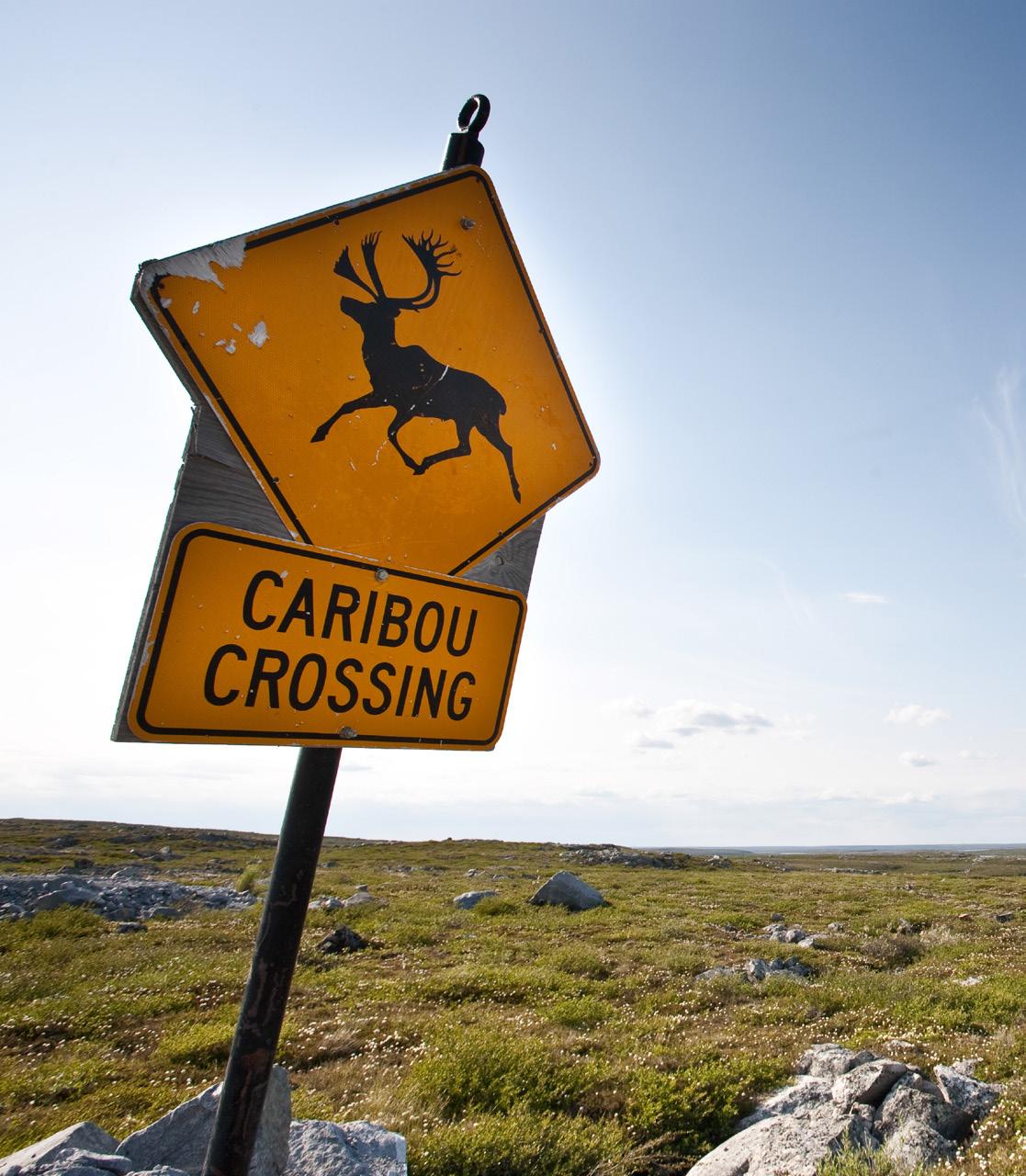
THE EDIT 2023 | 39
From top left: A sign near the Ekati diamond mine separating an area known to have migrating caribou; an exceptionally large caribou overlooking the landscape; a family of wolves roam near the Ekati diamond mine in winter.

40 | THE EDIT 2023
SUSTAINABILITY
A grizzly bear roaming the Canadian landscape in the Summer. Opposite page: a hawk spotted hunting near the Ekati diamond mine. Photographs by Arcitic Canadian Diamond Company.
halted until the bird’s nesting process was complete and the bird naturally migrated away. Even in cases like these that could cost millions of dollars, the environment comes first. In following up for more details on the bird’s nesting, a tenpage document was shared that details and documents all birds near each mine. The document is supported with photos and video monitoring to prove that operations were halted or changed in every case to avoid the disturbance of birds nesting near or in the mines. This detail made it clear that in a Canadian diamond miner’s eyes, even a common raven is put before diamonds. The attention and care given to the bird population can be seen in every animal native to the area.

Animals are far from the only environmental aspect taken into account. The land and air are equally important. While all mining requires di g ging, processing, and moving Earth, and generally altering the landscape, diamond mining is set apart in how they restore the land when the mines close. Part of the agreement signed before the mines open requires money to be set aside yearly in escrow, accumulating to hundreds of millions of dollars for reclamation. This money can only be used to restore the land to its previous state after the mine closes. These closure projects can nearly eliminate the evidence mining operations in only a few years. This is already happening in diamond mines that have entered the closure process. At Ekati, the whole diamond recovery process was made clear. Kimberlite ore, the rock that diamonds are found in, is recovered from the mine and processed on-site using only water. A series of recovery techniques, from pressure to special magnets and infrared lighting (to name a few), is used to release the diamonds trapped inside. According
to a 2017 study, 83% of the water used in diamond recovery is recycled. Once the diamonds are separated from kimberlite, diamonds are sold, and kimberlite is stored next to the mine, used later in the closure and reclamation process. This deceivingly simple process ensures the smallest footprint possible, yet, the mines’ environmental experts, geologists, and other scientists are continually looking for ways to improve. The diamond mining industry’s most significant environmental footprint is carbon emissions. Still, even this is mitigated through a fuel tax and carbon tax paid to the Canadian government to help o set carbon impacts. Also, the Diavik Diamond Mine in the Northwest territories installed its wind farm, which now supplies around 10% of its energy needs. To add context to the impact, a study by TruCost in 2017 combined data from the world’s leading diamond miners and estimated that the carbon emissions of a onecarat natural diamond from mine to f inger have a similar carbon impact as manufacturing three iPhones.
Since 1996, diamond mines in the Northwest Territories of Canada have contributed over $24 billion to the economy. Nearly $17 billion went toward local businesses and $7.5 billion to Indigenous-owned local companies. Seeing the mines f irsthand and speaking with the locals, you leave the Northwest Territories with a new appreciation for Canada’s diamond miners. Positively contributing to the economy with a focus on Indigenous and local people is undoubtedly a feat, but doing it in a way that respects, protects, and restores the environment, is what makes Canada’s diamond mining industry a leader in sustainable mining practices and an example for others to follow. ♦
THE EDIT 2023 | 41
In a Canadian diamond miner’s eyes, even a common raven is put before diamonds.
THE BIG ASK
Our favorite diamond pros on the questions you should ask while stone shopping—and the answers you can know right now
Written by FARAN KRENTCIL
Yes, buying a diamond is a commitment. It can also be so much fun. From exploring cuts and sizes to learning about artistry and history, choosing a natural diamond isn’t just a shopping trip; it’s also a very luxe adventure. (Plus, what beats the moment when you see a gleaming gem scatter sparkles of light all over your hand? Let’s be real: not much.)
To prep for this ohhh-inducing experience, it’s best to know some essential etiquette surrounding your purchase—namely, that it’s good form to be curious about your stone. “Of course we want you to ask questions!” says Quig Bruning, Sotheby’s Head of Jewelry for the Americas. “How else can we know what you’re looking for? And just as important, how else can you know what you’re getting?”
In the Beginning: Your Diamond’s History
Much like Marvel superheroes, a stone’s origin story is vital. “A diamond is based on the mysterious inner workings of our earth,” says fine jewelry designer Anna She eld, who designed Eva Longoria’s engagement ring, along with pieces for Jennifer Lawrence and Kerry Washington. “That equates to magic in my mind.”
The advantage of a natural diamond, of course, is that it’s harnessed 100% of that magic, developing through the power of our planet for hundreds of millions of years. Thanks to incredible advances in science, natural diamonds are recovered ethically.
As for the big di erence between antique and modern stones, gemologist and Greenwich Street Jewelers partner Christina Gandia Gambale sums it up this way: “An antique diamond is one that was cut over 100 years ago or one cut in an antique shape… These diamonds were faceted before tech-
nology was a tool in diamond cutting, and are appreciated for their rarity, history and the craftsmanship that the master cutter used to perfect the diamond at a time when skill was paramount.” Created with a more subtle glimmer than their modern counterparts, Bruning describes them as “cut to glow in the candlelight.”
STEAL THESE QUESTIONS ABOUT ORIGIN:
· Is it a natural diamond?
· Has it been laser inscribed for easy tracking?
All That Glitters: Getting Your Best Value
“The first two questions you need to ask yourself when looking for a diamond are, ‘What’s my budget?’ and ‘Do I love this, or does the person I’m shopping for love this?’” Bruning says. “There’s this idea that ‘budget’ is crass, but the truth is, you can get something beautiful at any price point, so don’t be afraid to know your price point.” It’s important to note there’s no one amount that’s “right” to spend on an engagement ring or any diamond. Plus, it’s perfectly fine to go online and browse pieces to get a sense of the price range, or even to visit a jewelry store and simply ask. (After all, Pretty Woman is just a movie and actually inquiring about something you want to buy is more than okay—it’s encouraged!)
Designer Eva Zuckerman, Co-founder and Creative Director of the label Eva Fehren, also notes that value and size aren’t always the same. “One of the most common assumptions we see is that a higher carat weight equals a lxqarger-appearing stone,” she explains. “We often have clients who are fixated on carat weight until we show them two stones with the same carat weight and shape, but that take up completely di erent amounts of real estate on the finger!
42 | THE EDIT 2023
STYLE
Ultimately, people should focus on what the stone looks like on.”
After all, loving how it looks when you wear it is the ultimate sign of luxury.
STEAL THESE QUESTIONS ABOUT VALUE:
· How much is the diamond?
· Does the diamond have a grading report?
· Do you have similar stones in a different price range I could see?
· Do you have a diamond upgrade program?
· What is your return policy?
The Fifth C: Custom
Supreme x Louis Vuitton isn’t the only luxury collaboration available. Thanks to custom design services from renowned artisans, you can invest in a one-of-a-kind collab that takes your diamond purchase to the next level. But like romantic relationships and pickleball practice sessions, communication is key for optimum results.
“We start o with multiple sketches and stone layouts,” explains Jillian Sassone, Founder of Marrow Fine Jewelry, which specializes in reworking heirloom pieces into mod-
ern stunners. “Once we land on a design with the client we move to the CAD (computer aided design) and rendering phase to ensure the layout and design are exactly what the client wants. Though the computer can’t accurately show the beauty of the stones, it does give an accurate depiction of the final design.”
Customization can also happen with something as simple as resizing—though be prepared for that to take some time as well. “The shank of a ring can be safely sized up or down a full size without risking any damage,” explains Zuckerman. “Any more than that and an entirely new shank will probably have to be made. Sizing can take anywhere from a few days to a month depending upon the intricacy of the piece.”
When possible, always know the size of the ring before ordering the piece. And if you must be sneaky? Measure a piece they already own (that you’ve seen them wear on their ring finger!!!) with a piece of string, then align that string with a tape measure or ruler for an exact number.
STEAL THESE QUESTIONS ABOUT CUSTOMIZATION:
· How long is the process to create a custom ring?

· Can I see some past pieces you’ve customized?
· Does the ring have a warranty?
· Does this design require any special care? ♦
THE EDIT 2023 | 43
EXECUTIVE
DIRECTOR,
RESPONSIBLE JEWELLERY COUNCIL MELANIE GRANT
The newly appointed executive shares her learnings from a multi-hyphenate and multi-faceted career
Written by SAM BROEKEMA
Life comes in chapters, and few have written the expansive tome that is Melanie Grant’s career. A multi-hyphenate, her work has spanned the role of a stylist, art director and writer. Before joining The Economist and covering watches and jewelry, Ms. Grant owned and ran her own creative agency. She penned Coveted: Art and Innovation in High Jewelry as an author and has curated blockbuster exhibitions such as Brilliant & Black: A Jewelry Renaissance with Sotheby’s auction house. Ms. Grant next curates the contemporary jewelry section of “Crown to Couture” at Kensington Palace. And now she is the newly appointed Executive Director of the Responsible Jewellery Council, which sets global sustainability standards for the jewelry and watch industry. Ms. Grant opened up to Only Natural Diamonds about the hallmarks of a storied career and what’s next.
Only Natural Diamonds: What was the first story that sparked your love for this industry?
Melanie Grant: Once I started writing about jewelry I experimented with blogs, features, and news and I even had a luxury column online. Then the Books and Arts editor at The Economist, Fiammetta Rocco, commissioned me to write a profile in 2014 on the sculptor and jeweler Wallace Chan and I think that story changed me. He flew to London with his team and bought some of his seminal pieces, including a large jade and diamond cicada and a long carved rock crystal and gem set necklace. As he talked about the journey of his life—going from abject poverty in China to celebrated master jeweler in Hong Kong and the wider world, I was struck by the power of jewelry as a method of transformation.
OND: What are you most excited about in your new role?
MG: All of this is about people, and I feel like I’m entering a whole new universe, which is fascinating. I’m excited by the
chance to do good and to collaborate with others to encourage progress. To meet and to bring the full breadth of the industry together—the entire supply chain—to discuss the challenges and the opportunities that exist in a productive and positive way. It’s a big job, but the support I’ve experienced has been phenomenal. I’ve had messages from trade associations in Angola to DMs on Instagram from miners in Canada. I’ve been taken aback by the sheer scale of it.
OND: Why is it important for the RJC to exist?
MG: Consumer confidence in the standards set out by the RJC is critical for the industry because RJC standards and certification allow member companies to demonstrate their commitment to responsible business and sustainability. Modern consumers are increasingly holding brands accountable for their global impact, actively engaging with them to understand transparency. In order to tackle greenwashing, industry-wide standards are vital as well as our ability to have conversations about what isn’t working. The public needs and deserves this from us and we must work hard to instill that confidence, but it must be a supply chain and industry wide endeavor.
OND: Why are standards and accountability so important?
MG: In the last two decades, the world has woken up to the importance of sustainability and the idea of responsible jewelry has gone from a nice thing to think about to a major driving force for change. The RJC began in 2005 as an industry-wide initiative to create standards that enable companies, from mining to retail, to integrate responsible business practices into their management systems and daily operations. Gen Z sees ethical practice as a necessity, so accountability is now vital at the sales counter.
We have two standards available to our members:
• RJC Code of Practices Standard (COP): providing a common and mandatory standard for all our commercial members for ethical, social, human rights and environmental practices. The COP is a manual for a sustainable and responsible
44 | THE EDIT 2023
jewelry supply chain, covering all aspects including mining, refining, cutting, polishing, manufacturing, and retail. It details management practices to ensure responsible business including labor and human rights due diligence, health and safety, gender equality, non-discrimination and product integrity and disclosure. The 2019 COP is also aligned with the OECD Due Diligence Guidance for Responsible Supply Chains for Minerals from Conflict-A ected and High-Risk Areas and the UN Guiding Principles on Business and Human Rights. • RJC Chain of Custody Standard (COC): This standard defines an approach for companies to handle and trade gold, silver, and platinum group metals in a way that is traceable and responsibly sourced. COC certification is voluntary and complements certification against our mandatory COP.

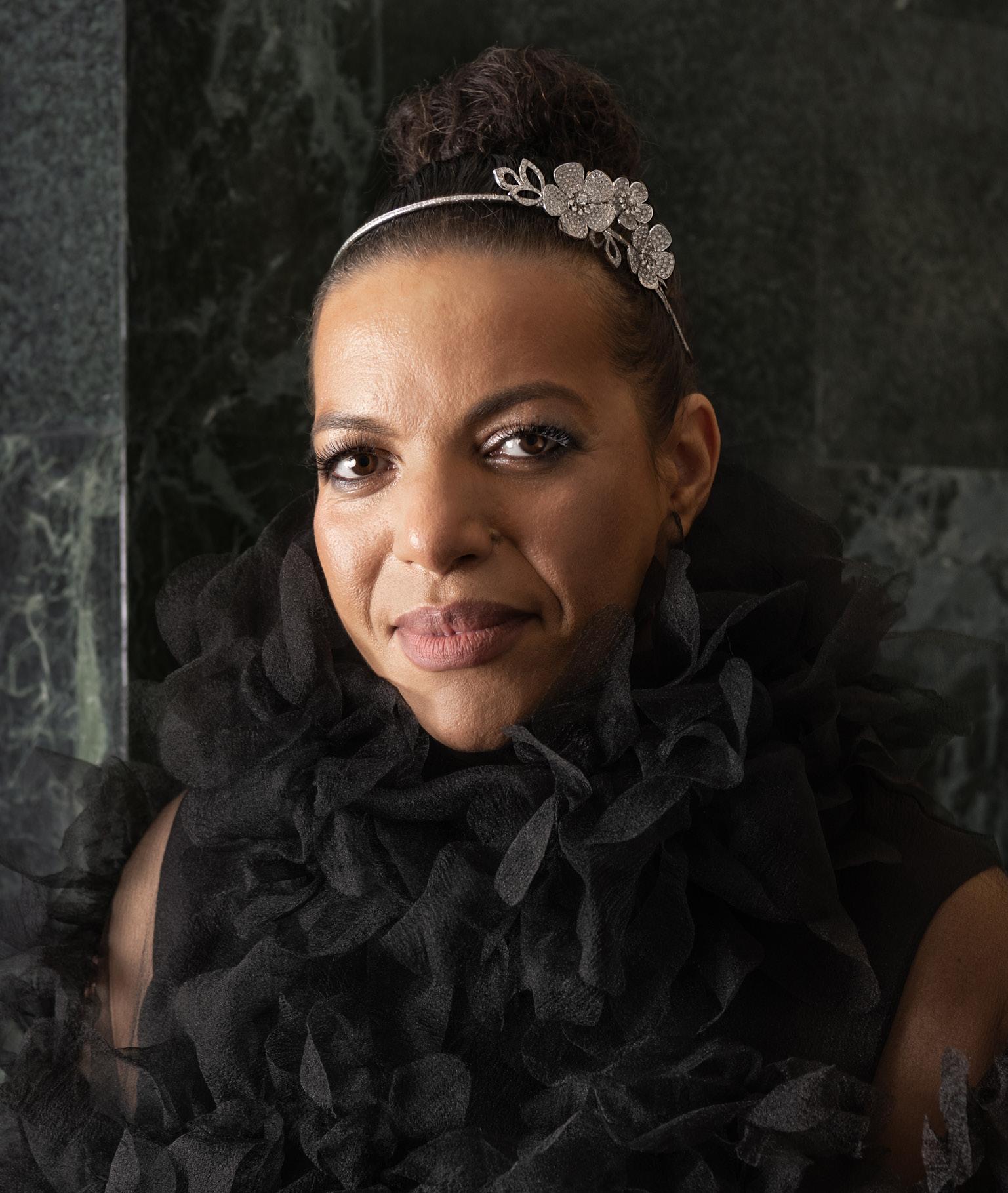
Sustainability is a journey of continuous improvement and RJC standards are updated every five years through open public and industry consultation. Aside from standards, we produce reports, research and educational toolkits to enable the practical application of our standards and to help everyone understand how ethical practice can work in reality.
OND: How do you see the role of the RJC evolving?
MG: We provide a foundation giving practical support, education and guidance to those who want to do better. We aren’t a police force and we don’t have the power to make companies act, but as more and more consumers and collectors ask for traceability we will continue to evolve and adapt with the market. For example, we opened public consultation last year as a first step to creating standards for lab-grown diamonds. It’s important that everyone in our industry abides by a unified standard and that consumers are confident about that.
OND: What do you see as the greatest challenge for the RJC?
MG: I think the scale of its remit is challenging because we provide certification for the whole supply chain which is an ongoing process, and we have members in 71 countries. I think our greatest challenge as an industry is to actively create a more positive dialogue around the way we talk about ethical practices for watches and jewelry. There is a lot of anxiety around greenwashing, and we face serious issues in terms of human rights abuses but there are also people doing great things and I think we should highlight them too in powerful ways. If we are to encourage people to be better inside and outside the industry, we need to invest emotionally and financially in green technologies and wholeheartedly tackle climate change. Everyone needs to do something on a macro and micro level, and I see this role as being part of my contribution.
OND: How can a consumer know they are shopping with an RJC member and why is that important?
MG: Shoppers are now savvier than they’ve ever been. They research and connect with brands online long before they buy and they are increasingly aware of ethical standards, seeking out RJC members. The pandemic gave people the time and incentive to focus on understanding sustainability issues to a greater depth, whether it was repurposing luxury manufacturing to create PPE equipment, or jewelry and watch retailers committing to saving jobs on the high street. Responsible businesses raised the expectations of shoppers and ushered us into a new era. To stay relevant, if brands of all sizes—from global juggernauts to the one-woman bands at their kitchen tables—start thinking about their responsible business strategy, I’d be a happy woman and of course, I would love them to include the RJC.
THE EDIT 2023 | 45
♦
STYLE
From left to right Melanie Grant wearing Julius Klein headband photographed by Andrew Werner. Wallace Chan transformable jewelry.

STYLE
THEIR TIME TO SHINE
The Clear Cut’s Olivia Landau and Kyle Simon on how they turned an “accidental side hustle” into a booming natural diamond jewelry business
Written by SARAH CRISTOBAL
Photographs by VINCENZO DIMINO
Perched high above the Diamond District in New York City sits The Clear Cut’s jewel box of an of f ice. On a clear day, the space is so bright from the sun refracting o the brand’s prismatic natural diamond pieces that Olivia Landau and Kyle Simon, the business’s married co-founders and top execs, will often pull down the blinds.
Landau and Simon’s sparkly love story is worthy of a Nancy Meyers-helmed romcom. It began, essentially, on the subway. In 2013, they were both attending the Gemological Institute of America (GIA) in New York. Landau took an interest in Simon and followed him to the F train after class to strike up a conversation. When Landau continued to chat, multiple stops in the wrong direction, Simon took note.
They bonded quickly and in the years that followed that Kismet encounter they graduated GIA (she as a gemologist and he as a diamond specialist) and persevered through an extra long-distance relationship. Simon started a fair-trade diamond mining company in West Africa’s Sierra Leone—he had lived there while working in local politics and had earned the trust of the community—and Landau developed a firsthand appreciation for well-crafted engagement rings as a salesperson at the Ti any & Co. flagship on Fifth Avenue. By 2015, Simon had returned to New York and enrolled in Columbia Business School and Landau had taken a position at a diamond wholesaler. It was around this time that The Clear
Cut brand began to crystallize after Landau was repeatedly commissioned by Simon’s business school friends to make engagement rings for future fiancées.
“It turned into this accidental side hustle,” says Landau. “I was running back and forth in the Diamond District shipping out hundreds of thousands of dollars of rings [that I had designed]. Kyle pointed out, ‘Oh, there must be a white space in the market if people are trusting you with their life savings.’”
Worth noting is that Landau is a fourth-generation jeweler. Her great-grandfather, grandfather, and father were all diamond cutters and dealers based in Antwerp, Belgium. Eventually, her father moved to the United States and met her mother, who is originally from Taiwan. They settled in New York when Landau was four years old and opened an antique jewelry business working with mostly private clients. “Their dream was for me to work in corporate America and not have to eat what you kill,” jokes Landau.
Up until that point, Landau had hoped to work at a fashion magazine and even interned at Teen Vogue, but when no media opportunities arose, she attended GIA to “buy herself some time.” As the story goes, she fell in love not only with diamonds and gemstones but also with her future husband. (The pair married in the summer of 2019.)
Landau initially started The Clear Cut as a blog and educational resource to guide prospective customers through the complicated process of buying an engagement ring. “Most people didn’t know the first thing about buying a diamond, so I started

THE EDIT 2023 | 47
The Clear Cut for our friends to read before coming to work with me,” she says. “Then I started posting on Instagram and that’s when strangers started following the account, asking if I could help create their rings.”
Landau still oversees The Clear Cut Instagram account, which now boasts 166,000 followers, and responds to most of the DMs. Along with posting informational videos and spotlighting the engagement stories of Clear Cut customers, Landau also includes fun bits like Japanese gel manicure tutorials and the best nail shades for brides.
With Landau’s social media savvy, Simon’s business acumen, and a shared vision to modernize the antiquated industry, the couple o cially expanded The Clear Cut blog to include e-commerce in 2018, with initial pieces being sold via Instagram. Simon admits that having that direct-to-consumer connection was invaluable but also “very unscalable.” So they hired a chief technology o cer and built a custom content management system that made the remote buying process more user-friendly. “Much of this industry is still conducted via pen and paper, it’s old school,” says Simon. “Our gemologists can talk to customers, analyze diamonds, and the rest of the job is automated or tech-assisted.”
That ability to constantly tweak and update the platform is The Clear Cut’s “special sauce,” says Simon. Last year the company started o ering NFTs that store the historical data of their customers’ precious gems. It was an innovation born out of necessity when Landau went to get her wedding ring insured with an antique diamond that was passed down from her grandmother.
“She had lost the GIA paperwork and had to open the ring, take the diamond out of the setting, send it to GIA, and get it re-certified,” says Simon. “Now with our NFT, we have an API [application programming interface] with GIA where it gets sent directly to them. They authenticate what the diamond is and who it is from. Your appraisal, and any alterations to the diamond, are all on that blockchain. Plus, people can know the exact story of the ring and share it over time.”
Simon admits that there was more enthusiasm for the project before the recent cryptocurrency crash, but whereas other luxury houses (like Ti any & Co.) o ered NFTs to purchase goods, The Clear Cut’s NFT aims to fill a functional need. “There is still a lot of interest because of the digitization of your experience,” he says.
The couple is also passionate about debunking the myths about laboratory-grown diamonds. While jewelry with labgrown stones has gained in popularity as of late, Landau equates it to the “fast fashion version of the diamond industry.” As a trained gemologist, witnessing these artificial baubles being promoted in the same space as natural diamonds is deceiving. “[The lab-grown movement] had a great marketing game out of the gate,” says Landau who points out that labgrown diamonds are mass-produced in unregulated facilities in factories in China and India, not ethically sourced from mines that give back to the community.
“It’s mimicking a natural phenomenon that took billions of years to create using fossil fuels,” adds Simon. “Making CVD lab-grown diamonds requires methane.”
There is also a disparity in value, and potential buyers might not know the di erence. “Lab-grown diamonds are in infinite supply,” says Simon. “Ultimately [consumers] need to know that they are being charged $250 per carat today, it will probably be $50 in a few years.”
Earlier this year, Landau created a TikTok video to point out this very issue, which quickly garnered over a million views. “[The video] was about how it sucks if you bought a two carat lab-grown diamond last year for thousands of dollars and now it’s worth $600,” she says. “It probably lasted three seconds but people started freaking out. Commenters accused me of lying so I documented my journey of buying a two carat lab-grown diamond for $600 just to prove a point.”
This led to a new initiative, launched this past February, where clients spending anywhere from $10,000 to $20,000 on their Clear Cut engagement ring are o ered a free labgrown diamond to be applied as part of a decoy travel ring. In the past, The Clear Cut would honor these types of requests using cubic zirconia as the synthetic stone. Landau and Simon believe that the best-case scenario for lab-grown stones is to have them replace CZ rather than natural diamonds.
“When you’re talking to a jeweler who is trying to charge you $10,000 for something that the other jeweler is giving to you for free, it applies some pressure,” says Simon.
And while engagement rings are still The Clear Cut’s main source of revenue, it is the seasonal collections that drive the most tra c. In keeping with her usual strategy of harnessing the power of social media to her advantage, Landau designs the pieces based on what is trending or being requested by repeat customers. Not surprisingly this accessible approach to luxury has worked. Landau and Simon share that they will occasionally receive online orders of up to half a million dollars. And that gleaming midtown o ce? A result of The Clear Cut’s year-over-year growth.
Their newest o ering is the new Chelsea Chain Tennis collection, which launched in April and is comprised of five new SKUs including a delicious and highly wearable tennis necklace that comes in two di erent lengths. And this past May, the brand launched its new wedding band styles just in time for engagement season. Custom orders also play a big part in The Clear Cut’s business and if there is a certain natural diamond you’re looking for, the co-owners are determined to find it. “We will hunt down the exact diamond you want, wherever it is in the world, and get it for you,” says Simon.
And while there is a certain subversiveness to the way The Clear Cut couple is upending the industry, at their core, they are two people in love doing something that they love, and what could be purer than that? “I thought it would be nice to make some rings on the side for fun,” says Landau of her initial foray into jewelry design. “But I never expected to have our own business or work together. It’s the best.” ♦
48 | THE EDIT 2023
STYLE

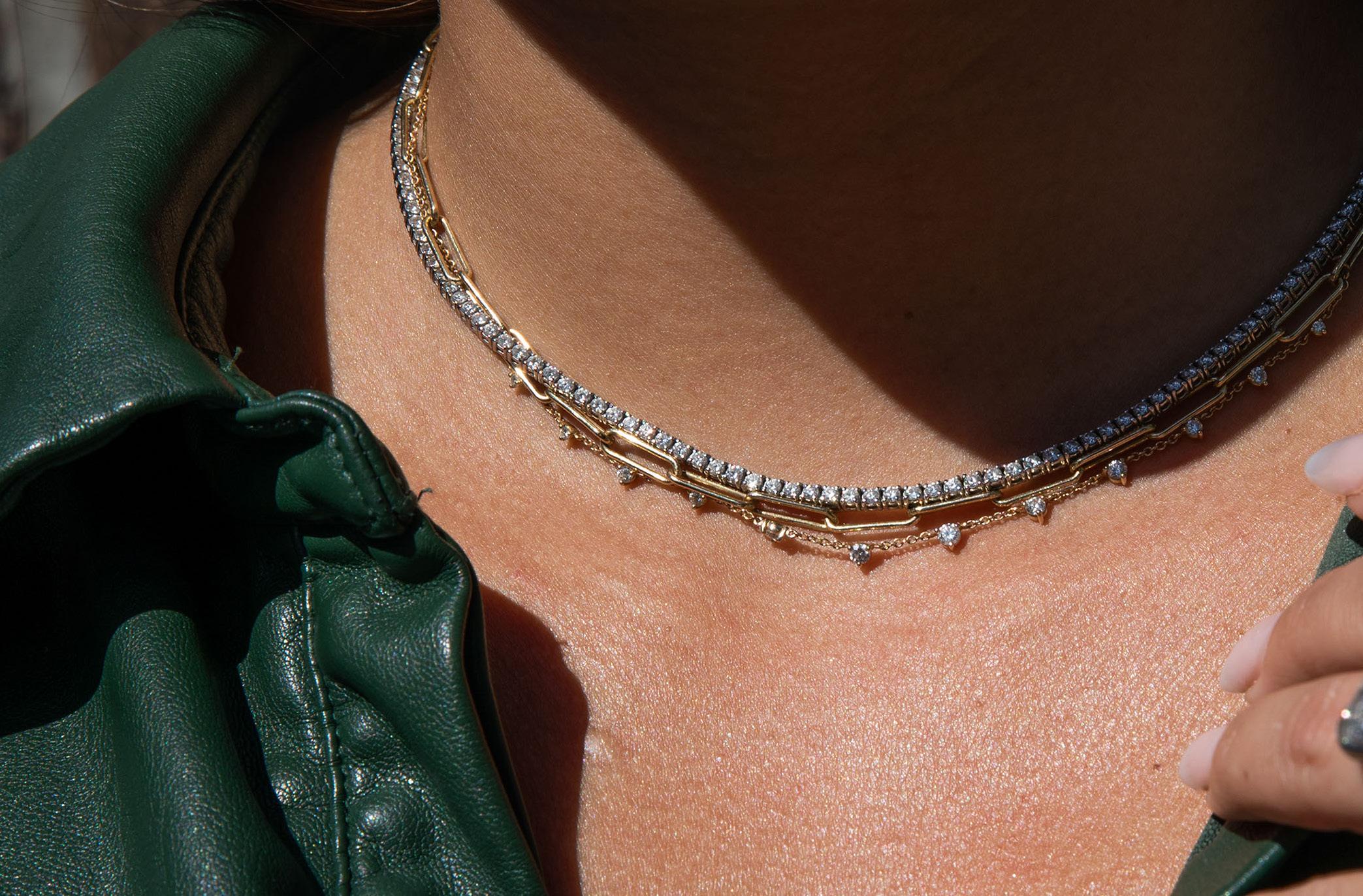
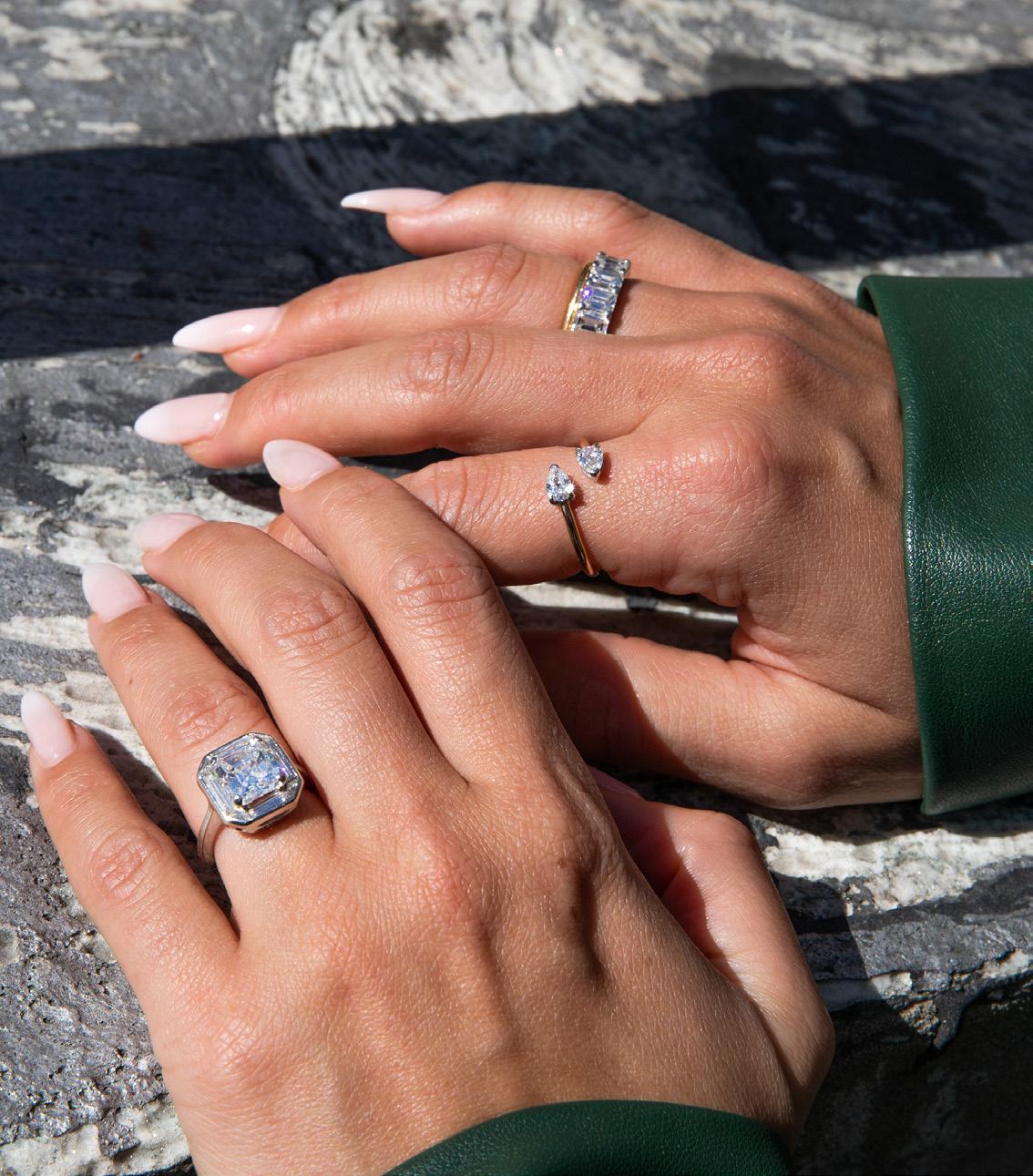
THE EDIT 2023 | 49
Preceding page: Kyle Simon and Olivia Landau in their office in New York City. Top: Olivia’s daily wear diamond tennis necklace, gold paper clip chain, and diamond station necklace. Clockwise from top: Olivia’s engagement ring, wedding bands, two stone ring, and tennis bracelet, a selection of Clear Cut tennis necklaces.
MEET
THE 6 DESIGNERS SELECTED FOR THE 2023
EMERGING DESIGNERS DIAMOND INITIATIVE
Written by SHONTEL HORNE
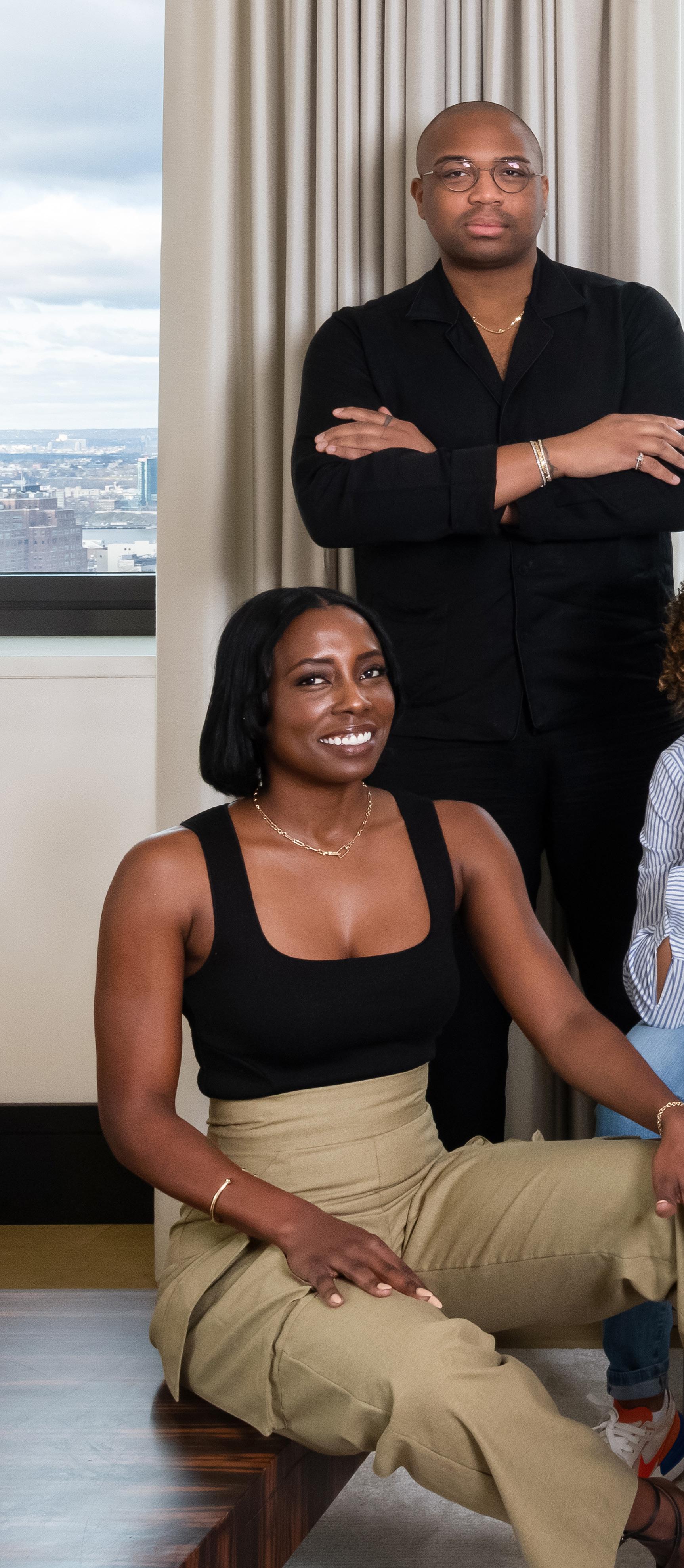
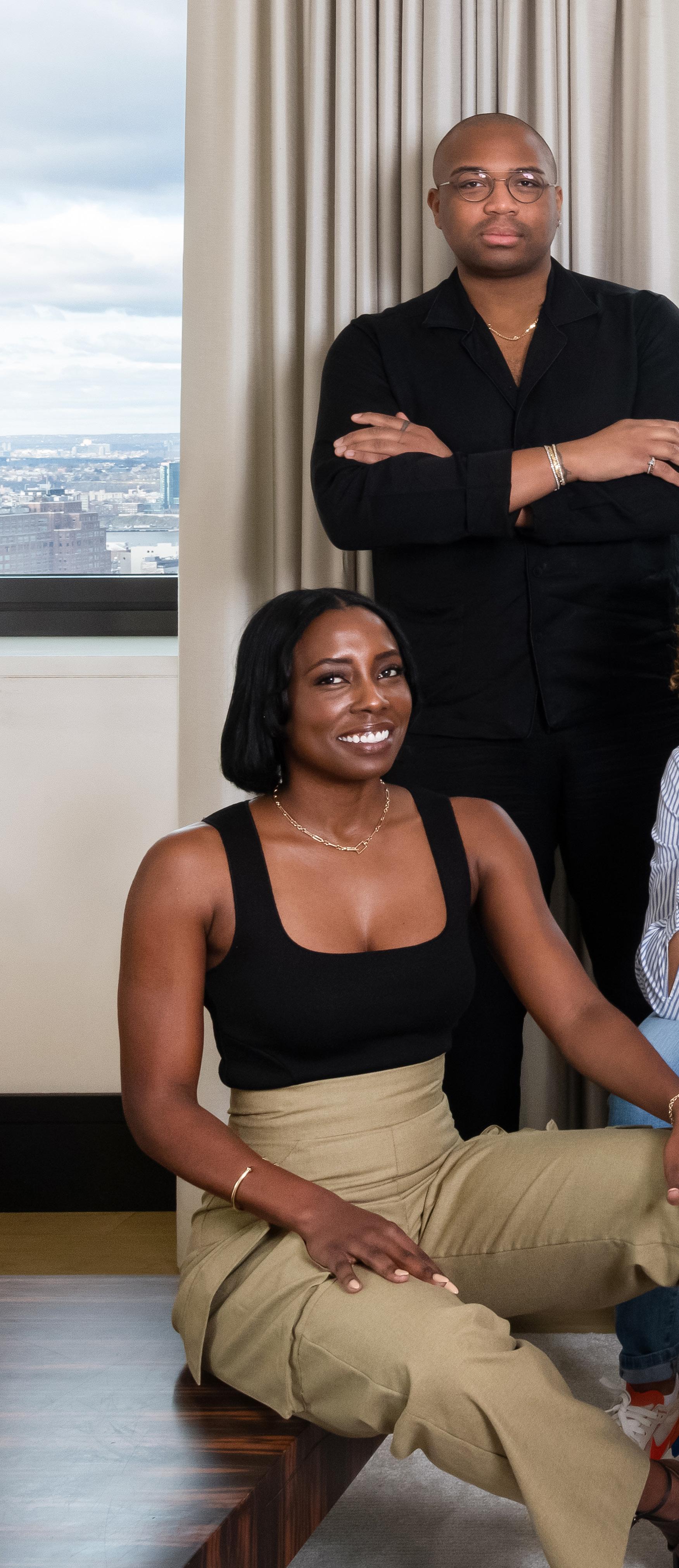 Photographs by ANDREW WERNER
Photographs by ANDREW WERNER
50 | THE EDIT 2023
Clockwise from top left: Bernard James, Amina Sorel, NDC’s Kristina Buckley Kayel, Rosario Navia, Gwen Beloti, Jessenia Landrum, Symoné Currie.

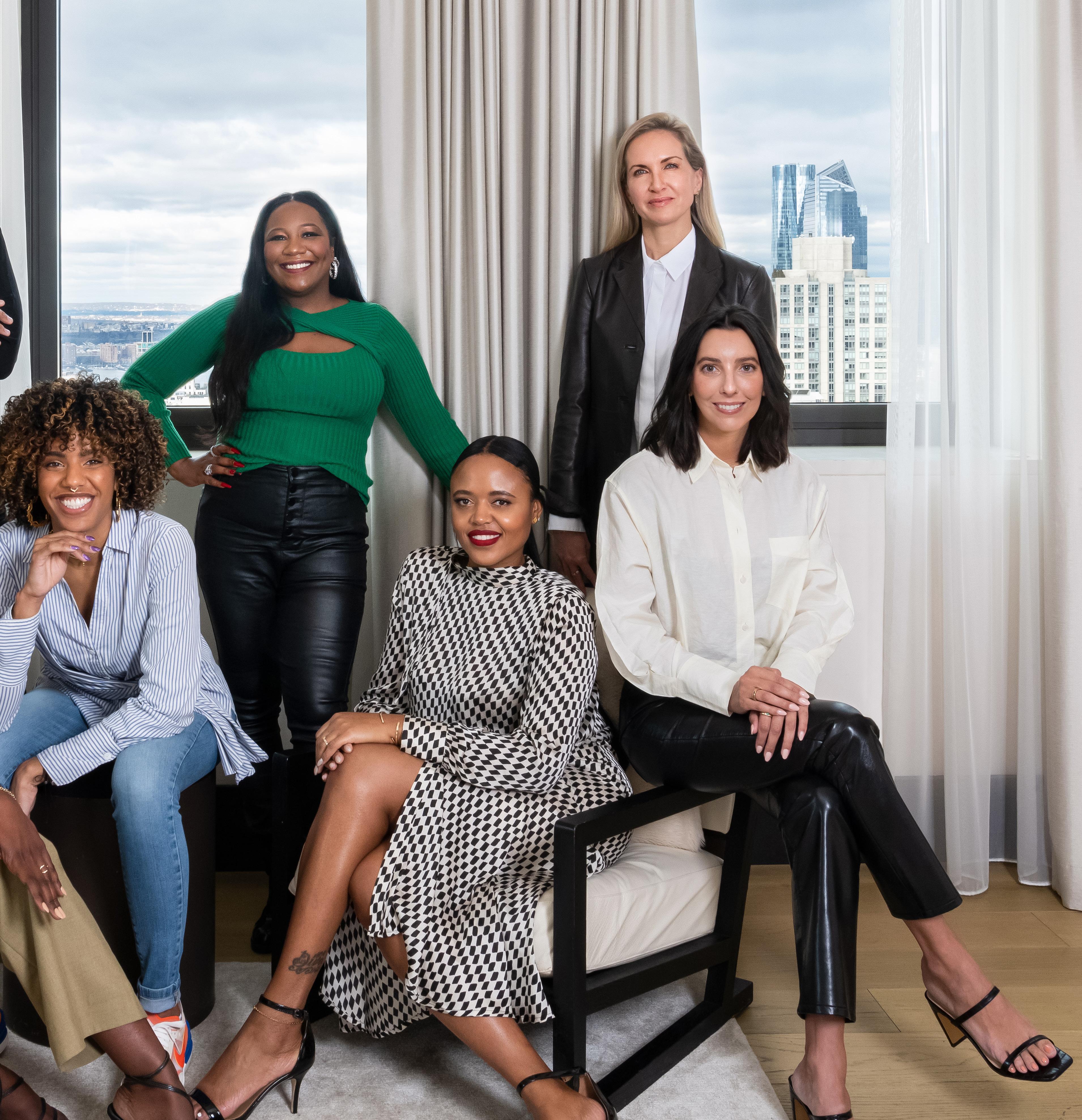
THE EDIT 2023 | 51 STYLE
The 2023 Emerging Designers Diamond Initiative (EDDI) participants have been announced, and these talented designers are well on their way to becoming household names in the world of fine jewelry.
Launched in 2021 by the Natural Diamond Council and jewelry designer to the stars Lorraine Schwartz, the EDDI program provides Black, Indigenous, and People of Color (BIPOC) jewelry designers with unprecedented access to education, opportunities, and resources. This year’s class includes Amina Sorel (Amina Sorel Fine Jewelry), Bernard James (Bernard James Jewelry), Gwen Beloti (Gwen Beloti Collection), Jessenia Landrum (Jevela), Rosario Navia and Symoné Currie (Metal x Wire).

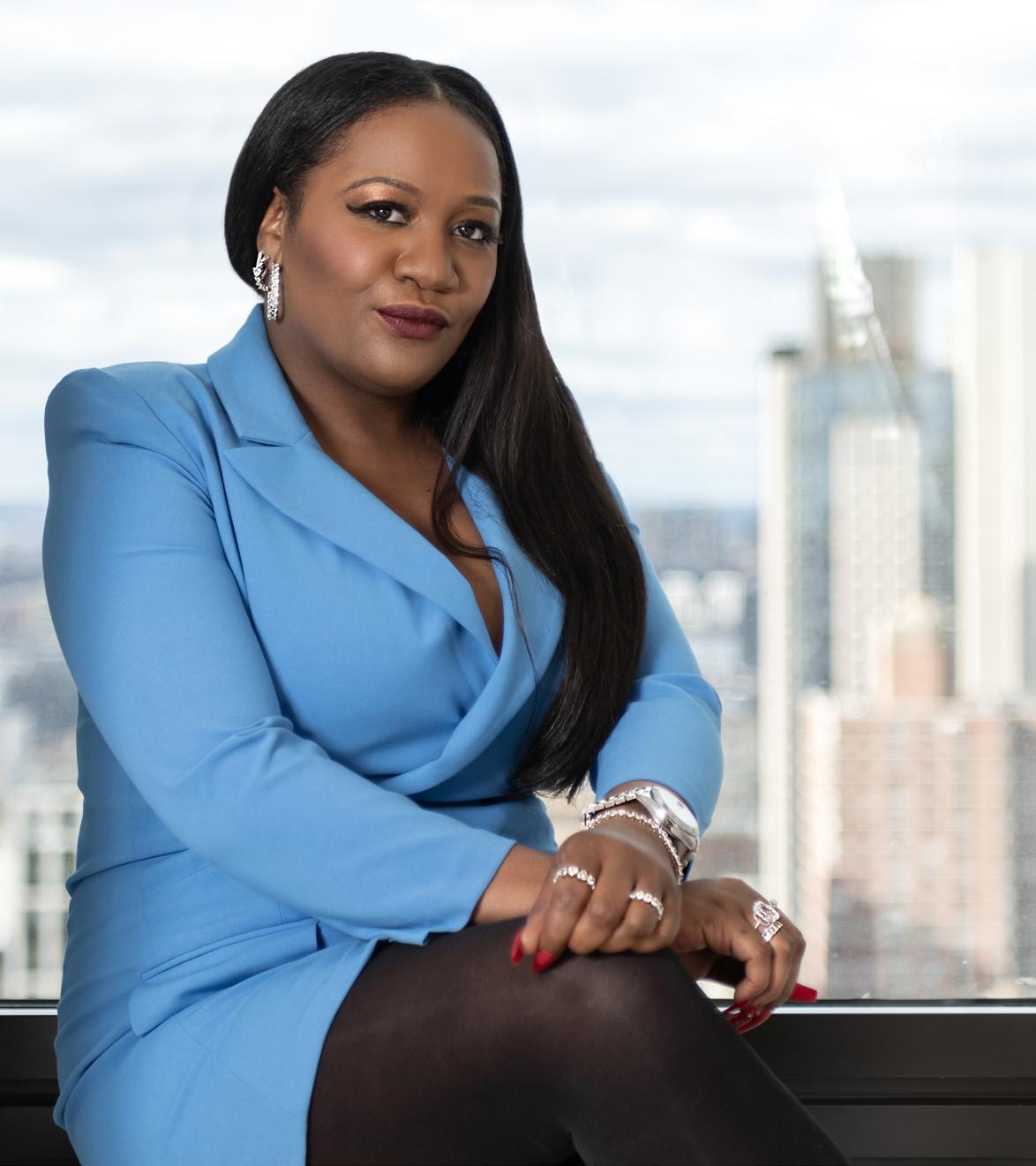
As part of the program, designers receive a $20,000 diamond credit at cost, retail opportunities, selling support, press opportunities, and diamond education. They also receive monetary funds for production, CADs, and sampling to eliminate upfront costs to each designer. The designers are paired with industry mentors to learn the ins and outs of the industry, and they are also partnered with diamantaires to establish a line of industry diamond credit in their own names to select the natural diamonds that work best for them and their collections.
“We are thrilled to partner with the next inspiring group of jewelry designers as part of the Emerging Designers Diamond Initiative,” says Kristina Buckley Kayel, Managing Director of Natural Diamond Council. “The program continues to evolve and yield transformative outcomes for the designers. We are incredibly proud and committed to providing these designers of color with all the tools and mentorship they need to achieve successful and sustainable businesses.”
Previous EDDI participants whose natural diamond jewelry created during the program has been sold on Moda Operandi, Greenwich St. Jewelers, 1st Dibs and Gemist, and worn by Bad Bunny in Vogue , Law Roach at the Met Gala, Winston Duke in Esquire Magazine and Lizzo at the Met Gala and on Saturday Night Live .
“Congratulations to the new class of designers. I look forward to seeing their creativity come to life, and I am so excited to see where it leads them to. It’s been great to work with so many talented emerging designers over the past two years, and inspiring as well,” says Lorraine Schwartz.
As part of the EDDI program, the designers will create and launch a natural diamond jewelry capsule collection and will also be invited to present at this year’s Luxury by JCK Show, taking place May 31 – June 5 in Las Vegas.
Applications for the 2024 program are open and accepted on a rolling basis and jewelry designers within the BIPOC community are encouraged to apply. ♦
52 | THE EDIT 2023
Amina Sorel
Jessenia Landrum
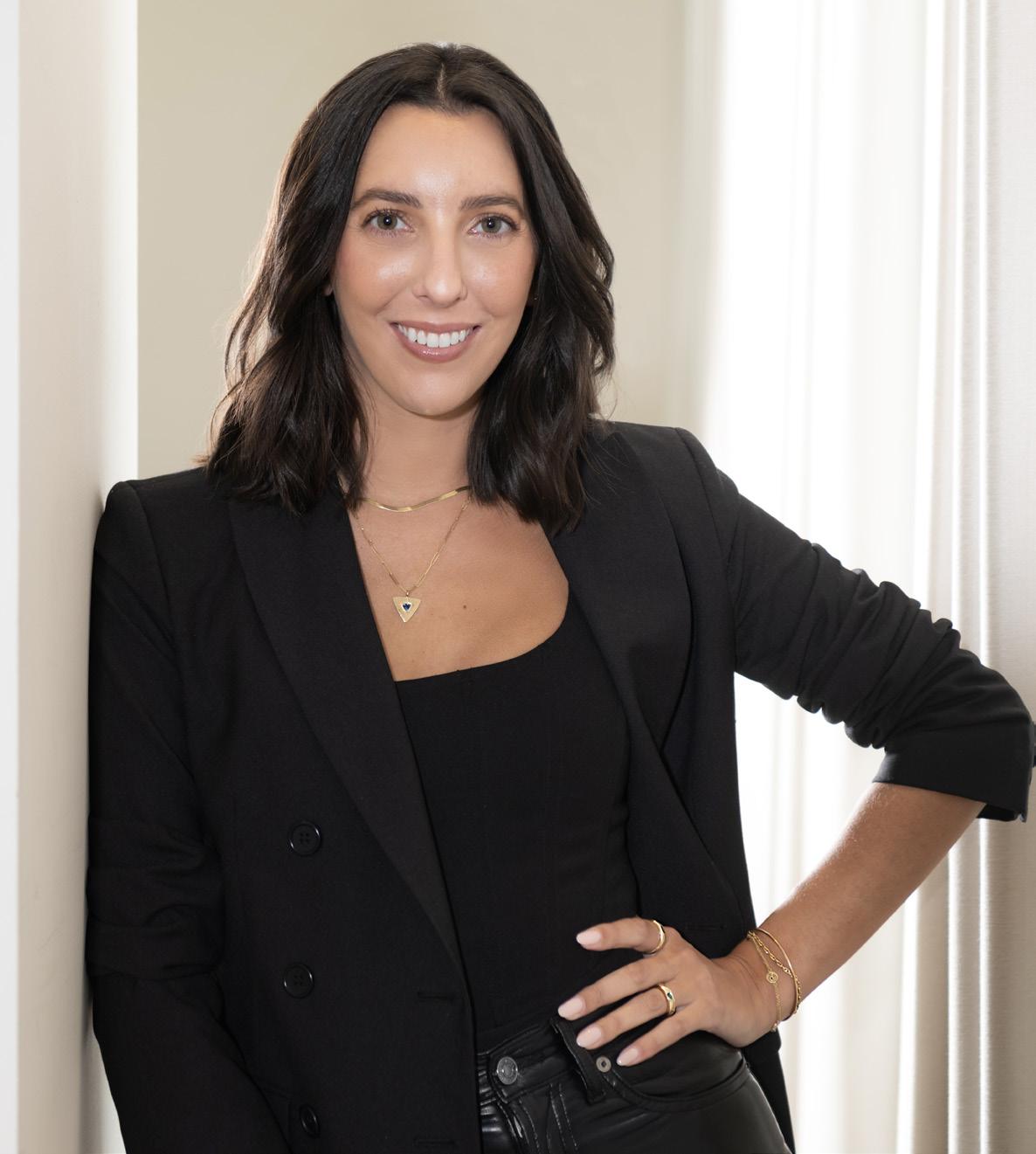



THE EDIT 2023 | 53
Gwen Beloti
STYLE
Symoné Currie
Bernard James
Rosario Navia
SUZANNE BELPERRON’S ARRESTINGLY MODERN STYLE LIVES ON
Written by JILL NEWMAN
Photographs by ANDREW WERNER
The French jeweler’s influence is seen in today’s best and brightest designers.

The word visionary may be overused to describe creatives today, but it couldn't hold truer when it comes to French jeweler Suzanne Belperron. A century ago, when the disciplined Art Deco style was all the rage, she pioneered a new jewelry aesthetic, forging curvaceous, sculptural designs that liberated stones from their prim and proper settings and mingled precious diamonds and emeralds with more quotidian materials. Belperron always favored style over the status of gems.
The designer’s own engagement ring illustrates her early rule-breaking style. After Jean Belperron proposed to her in 1923, she dreamed up the Ying et Yang ring, a bulbous swirl of hammered gold with a two carat cushion-cut diamond nestled on an angle. It was a radical departure from everyone elses’ classic diamond and platinum solitaire rings.
“She envisioned the future of jewelry design,” says Nico Landrigan, whose family acquired the worldwide rights to Belperron’s archive of over 9,200 designs. “She wasn’t just looking at the next season or year—she was designing for the next century,” he explained. In 2015 the Landrigans opened the Belperron Fifth Avenue salon, o ering a curated selection of pieces recreated from the archives. “Some designs are 100 years old, and clients often say to me that they look shockingly modern.”
A PIONEERING DESIGNER WHO DIDN’T SIGN HER PIECES
Despite being one of the most innovative jewelers of the 20th century (devoted clients included the Duke and Duchess of Windsor, Elsa Schiaparelli and Karl Lagerfeld), Belperron’s name remains relatively unknown outside the circle of jewelry collectors. She didn’t sign her pieces, saying, “My style is my signature.” But that made it harder to identify her jewelry.
“Clients who bought Belperron’s jewelry often didn’t know who designed it, but they bought it because they loved it,” says Russell Zelenetz, an owner of Stephen Russell jewelry boutique, and one of the most important dealers in vintage Belperron. He says that Belperron’s arrestingly modern style has become adored by a new generation of collectors. “More people know Belperron’s name and are asking for her jewelry.”
In some ways, Belperron’s jewelry is timelier than ever. Stripped of the formality of classic jewels, her idiosyncratic pieces are bold, colorful and wearable. ‘Wearable’ may seem like a superfluous term (shouldn’t all jewelry be wearable?), but again, it holds true for Belperron. Her streamlined designs are devoid of fussiness, which makes them easy to sport—day or evening. “She created new volumes with di erent visual rhythm and reason,” wrote Karl Lagerfeld in the forward to the book Jewelry by Suzanne Belperron, published by Thames & Hudson in 2015. “Her work never inflicted the wearer with an idea of wealth. There was never any danger of overstatement.”
A high profile fashion icon, Lagerfeld understood Belperron’s
54 | THE EDIT 2023
artistic vision and was a serious collector. He was often photographed with one of his many Belperron brooches—a rock crystal and diamond barrel design or platinum and diamond leaf pin—pinned to his tie or lapel.
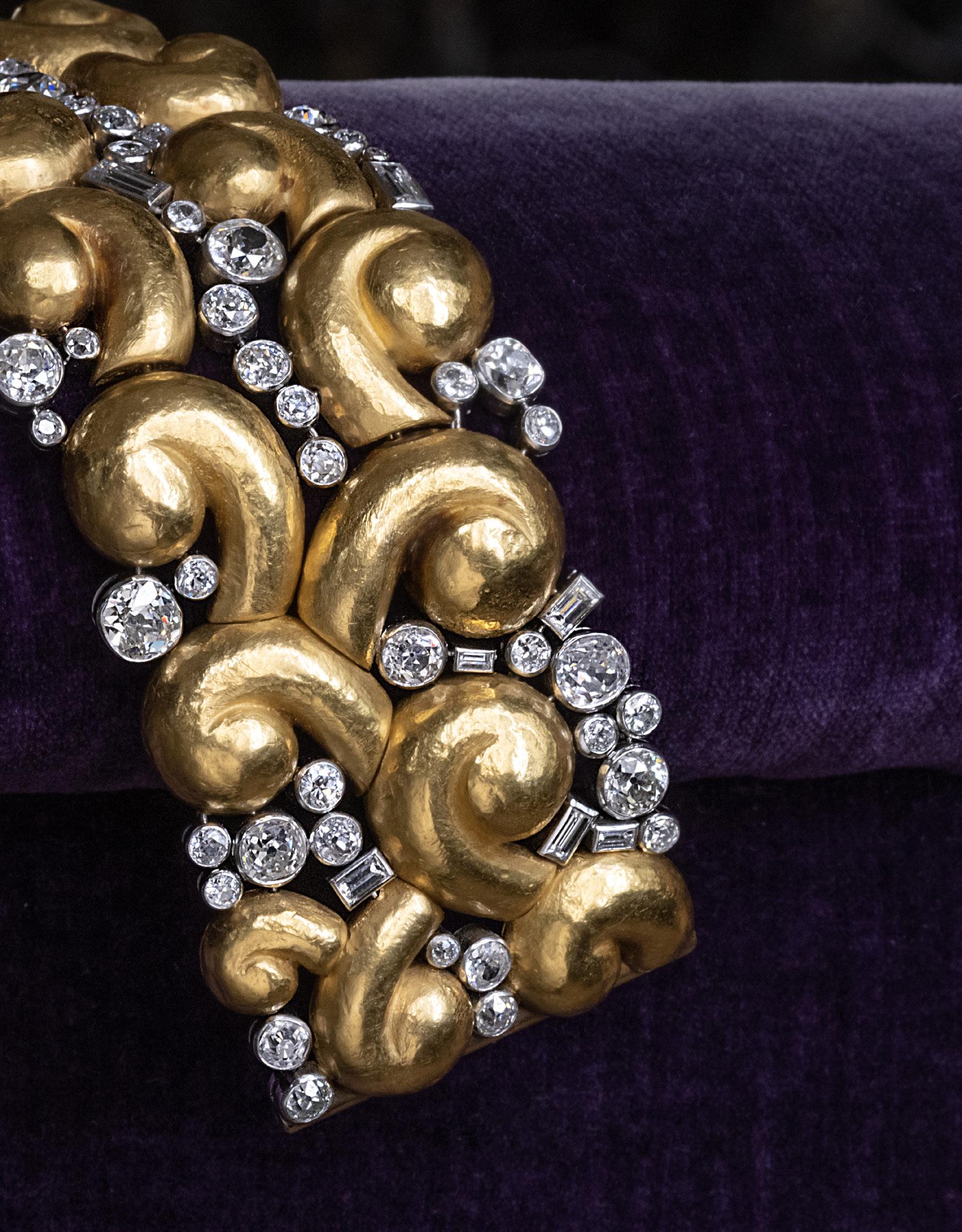
A MASTER OF TECHNIQUE AND STYLE
Belperron’s pioneering aesthetic was rooted in a mastery of technique. After training at the École des Beaux-Arts in Besançon, Belperron (née Vuillerme) moved to Paris at the age of 19 and was hired as a designer for Maison Boivin. During her 13 years at Boivin, she explored various references, from ancient Egyptian sculpture and abstract tribal motifs to architecture and even the Michelin Man, all of which were subtly referenced in her designs.
In 1932, she left Boivin and joined forces with the preeminent French stone dealer Bernard Herz. Working from a by-appointment Parisian studio, she played with proportions, light and gradations of color, and combined precious gems with smokey quartz, agate and citrine. She was known for large-scale
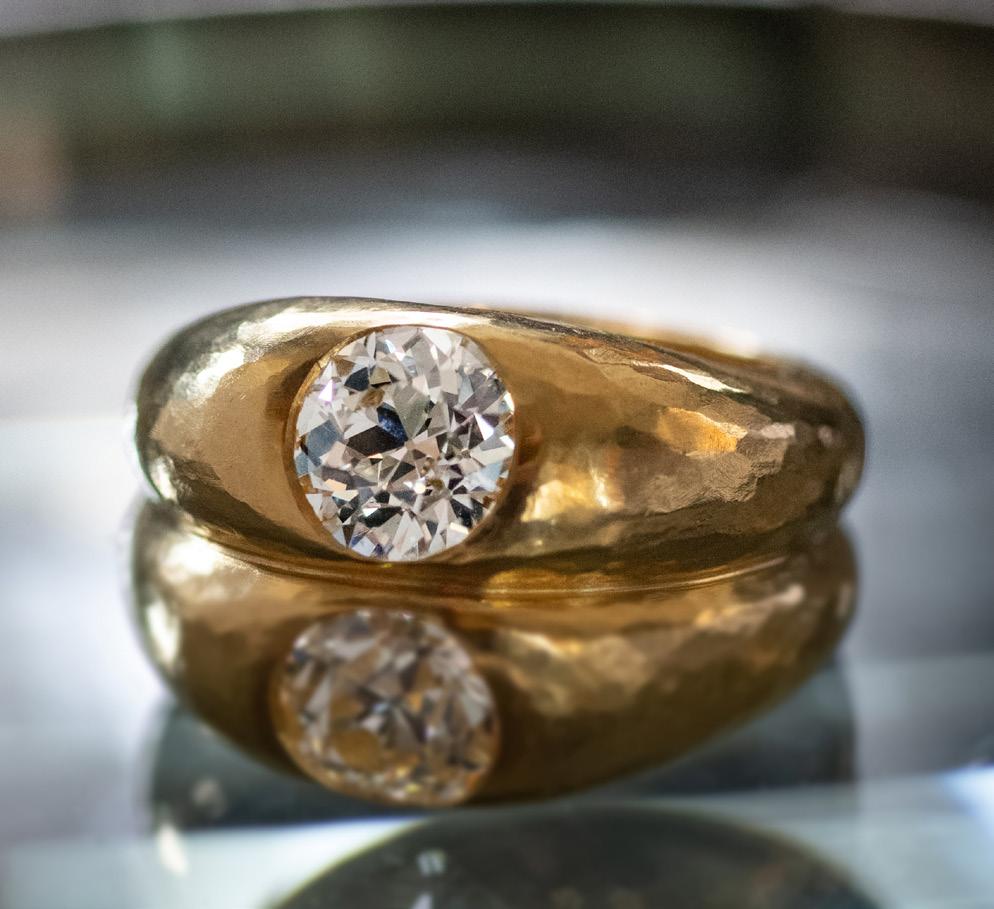
creations that didn’t overpower but expressed lightness and movement.
The ensuing war years showed her true courage. Belperron joined the French resistance (The Jeweler of Stolen Dreams by M.J. Rose recounts the story) and took ownership of her Jewish partner’s business to save the company from the Nazi regime. Sadly, Bernard Herz didn’t survive the war, but when his son Jean returned to Paris, she joined forces with him to start Herz-Belperron. During their 30-year partnership, they created lavish jewels and dressed some of the most stylish icons of the mid-twentieth century. They decided to retire and close the business in 1974 and Belperron passed away almost a decade later at the age of 82.
Landrigan says her early training and her mastery of “the ultra-disciplined Art Deco style” established her strong foundation. But once that style became overly popular, she moved on. “In classic iconoclastic style, I imagine she said to herself, ‘now it’s been done, I’m moving on.’” She applied those Art Deco principles to curvaceous forms, which Landrigan says

THE EDIT 2023 | 55
Clockwise from left: Belperron bracelet, Belperron ring. Amber Valetta wearing Belperron earrings at the 2016 Met Gala from Getty Images.

56 | THE EDIT 2023
From left to right Portrait of Suzanne Belperron by Horst P. Horst/Condé Nast. Belperron rings and necklace, Belperron cuff bracelet from Stephen Russell.
she turned into something “feminine, tactile and appealing.”
Belperron understood what was fashionable—and what made women look and feel beautiful. Take her carved chalcedony and diamond earrings, which swept up the ear like an instant facelift. “Everything she made had a sense of movement,” said Zelenetz. “Everything was aesthetically pleasing to the eye; she never did anything that just sat there.” Her jewelry was made exclusively by the French manufacturer Groene & Darde who, he says, was a genius in engineering. “Even a pair of earrings as large as my fist had balance and laid beautifully on the ears.”
Belperron’s unique sense of color is another signature, says Zelenetz. From layered neutral stones to a mélange of tonal gems, she had an eye for color. An example, he points out, is the oversized tourmaline and emerald cu in his Madison Avenue salon, which is composed of a mosaic of varying green gems. “She took all these green stones and composed this beautiful, happy and elegant piece.”
“People are still astonished by the risks she was willing to take,” says jewelry historian Marion Fasel, founder of The Adventurine. That daring style, she says, is expressed in the designer’s “enormous scale and bulbous shapes, and the way she plunged these large diamonds into other materials.”
INSPIRING THE NEXT GENERATION OF JEWELERS
Belperron’s elegant, modernist designs are in demand today. At auction, her unsigned pieces command top dollar, and both Zelenetz and Landrigan say interest is at an all-time high. Belperron’s record price at auction was achieved at Christie’s in 2018 when a buyer paid $852,500 for a diamond Tube bracelet (the pre-sale estimate was $200,000 to $300,000). Another carved amethyst, ruby and diamond leaf necklace sold for $507,000 in the same auction.
Her influence has resonated with some of today’s best and
brightest designers, says Fasel. “There is a legacy of daring and being an iconoclast that we see in some great designers today, like the incredible work of Ana Khouri and Kristy Stone at Retrouvai.” Their form, use of mixed materials, and way of setting stones in stones recall some of Belperron’s hallmarks.
Brazilian jeweler Fernando Jorge, who is based in London, says Belperron’s legacy inspired him to be bolder and more adventurous. His Flame collection is a sort of homage to Belperron but reflects Jorge’s own idiosyncratic style. Unveiled three years ago, the Flame originated with large, carved swirling shapes in citrine, rose quartz and amethyst, and it’s become his bestselling collection, appearing in new iterations every year. “It has a little provocative e ect and it's intriguing, and that’s what people want,” he says. He’s drawn to her pieces for their simplicity and how they look on the body. “Her designs are adventurous and free-spirited, and they express a bold femininity that I love.”
She also had a sense of wit. One of her popular designs was inspired by the Michelin Man, who is known in France as Bibendum. She carved chalcedony rings and cu s in stacked concentric circles that resembled the geometric contours of the cartoon character and set them with stones.
She also made large diamonds appear discreet and wearable for every day in designs like the Turban ring, which wrapped the stones in gold, and rounded quartz rings with big diamonds dropped in the middle.

Landrigan says that Belperron’s bestsellers today are the Couronne Cu s made in 22 karat gold and set with cabochon stones, and the Wave motif necklaces and bracelets, which appear like undulating gold vines with diamonds placed on the twists and turns.
A visionary indeed: Belperron knew her designs didn’t require a signature; her style became so recognizable that we know a Belperron when we see it. ♦

THE EDIT 2023 | 57


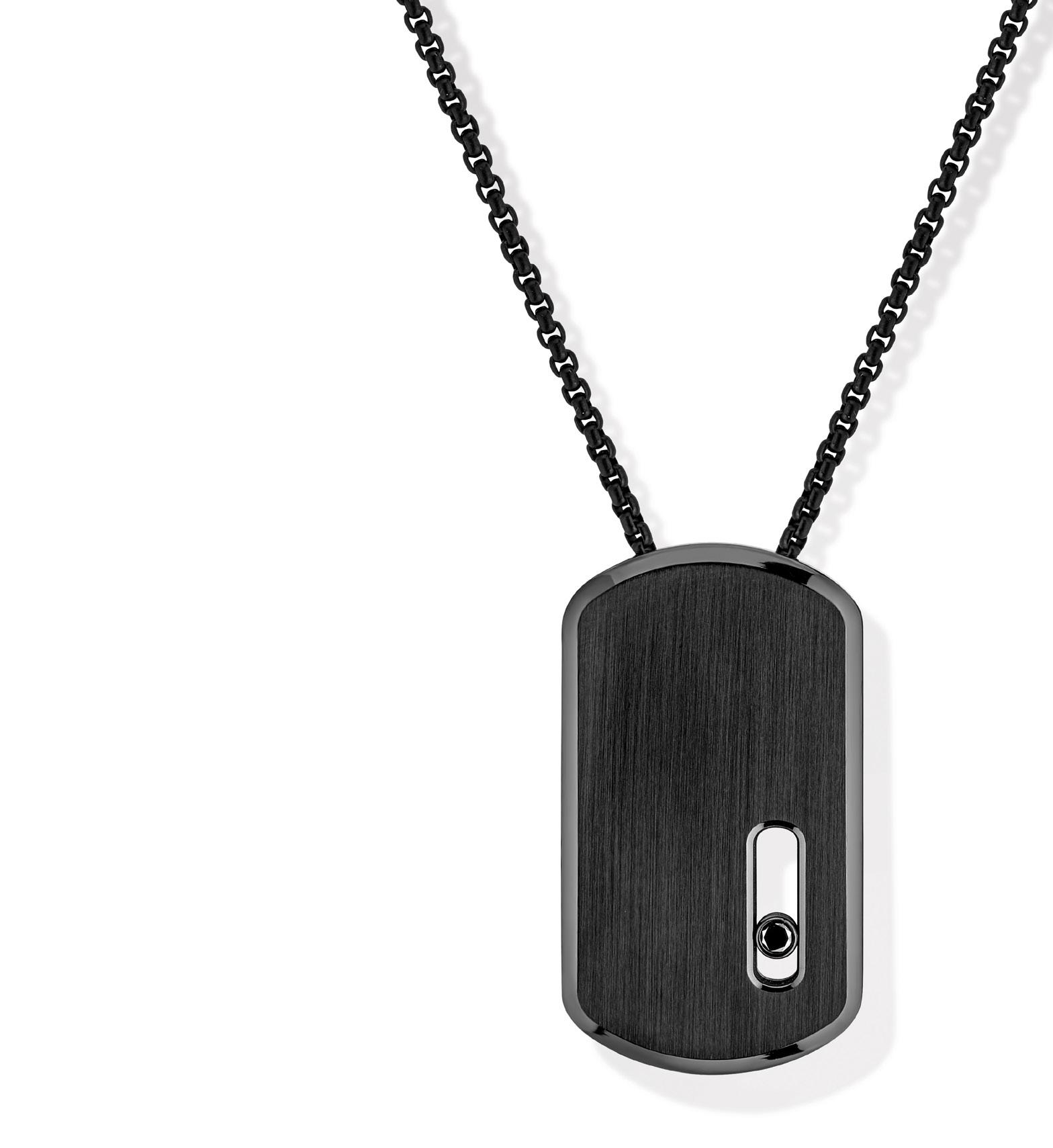
STYLE
THE QUEEN OF DIAMONDS
Valérie Messika’s lifelong pursuit to pay tribute to the sparkle of natural diamonds
Written by SAM BROEKEMA

hildhood is a time for both discovery and delight. For Valérie Messika, growing up was intertwined with the story of natural diamonds. Her father, André Messika, is a legendary diamantaire and taught her to appreciate the beauty but also the importance of science in understanding the rare jewels and their potential. As she explored the secrets of diamonds, Ms. Messika found a whole new world that inspired her creatively and conveyed to her that beauty is deeper than what you can see on the surface. “During my childhood, [my father] used to bring home stones. I would put diamonds on my f ingers, trying to f ind out which stone is more beautiful… Playing with a loupe, you can find an inclusion. So, my father said like a watch, it’s at twelve o’clock, six o’clock, two? It was something very playful. But even playing, he [taught] me how to see inside small things, all the details. It was very good training for me…And the diamond is a connection with my father.”
Years later and all grown up, she is the creative director of Messika, the eponymous jewelry House she founded in 2005. When she approaches a new collection, the first thought and inspiration come from looking at the stone and asking how this piece can fit into her ideas of clarity, purity, vibration, and timelessness. “I always have in mind that my goal is to pay tribute to the stone. And then I want the execution to be very, very flexible.” The word flexible is apt as the brand has moved from a specific idea of what is gendered. The brand has staged high profile fashion shows in the last few years and showcased the jewelry on both female and male models to great e ect. Ms. Messika has, to this point, confined her inspiration to her experience as a woman and she has looked to the strong women in her family and her two daughters to inform the collection. “But for three years now, I really changed my mind. Probably it’s because society has changed, and I move with these trends. I [see] the potential for men now to wear diamonds again. I say ‘again’ because before it used to all be for the guys, for the maharaja, for the king, and why does it have
to be only for women now? That’s a big mistake…For me, there is no gender anymore. And it has changed my way of thinking about jewelry. And you will see this in the next collection even more.” The brand has made a big splash by adding Alton Mason as the face of the campaign alongside supermodel Kendall Jenner. “He [is] so excited about the launch of the campaign. He can’t wait…I feel blessed to have him.” That doesn’t mean the Maison has turned its back on high-wattage classic supermodel star power.
Naomi Campbell closed the fall fashion show in a High Jewelry creation cut entirely from a single 110 carat natural rough diamond. The vision brought a smile to everyone in the audience and notably also to the lips of the reigning catwalk queen herself. “She told me, ‘I am so proud, I’ve got so much power.’ And I said, ‘you see Naomi, you smile.’”
Beyond impeccable casting, Ms. Messika concentrates on imparting a feeling to her guests. “It’s the mood, definitely the mood…But a mood can be fashion, it can be architecture, it can be art, it can be everything. When it comes to the show, the second most important thing, it’s the clothes, the fit, and the style. Because I want to have the perfect match between the jewelry and the clothes. I am obsessed with that because I think it’s a very di cult exercise for jewelry.”
When approaching her own style, Ms. Messika turns to the classics but also to express what is most important to her: family. “But at the end of the day, I never take o my diamond tennis bracelet. And the two bangles with my daughters' names. Because they are looking at me, ‘Are you wearing [our] bangles?’ And I say yes! That’s why I never take them o . They’d notice very quickly, it’s a family jewelry story.”
Her daughters are at the center of what drives her forward. “Also, for me as a mom, I want my girls to see that I am not only making jewelry or running a business, which is super cool but it’s not enough. I want to also give a sense of my life to them. And I want to continue to make this beautiful name, which is the name of my father, shine around the world.” ♦
THE EDIT 2023 | 59
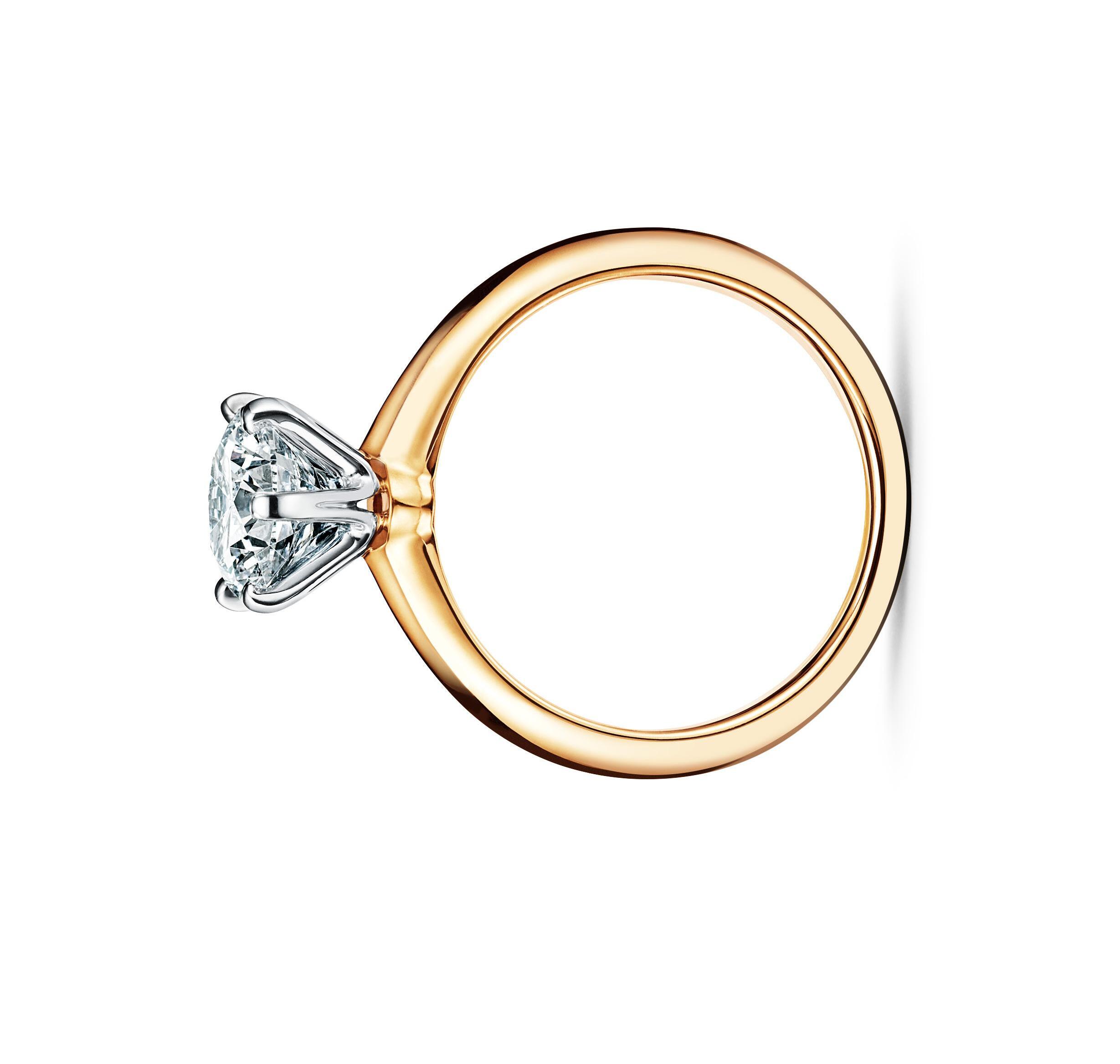
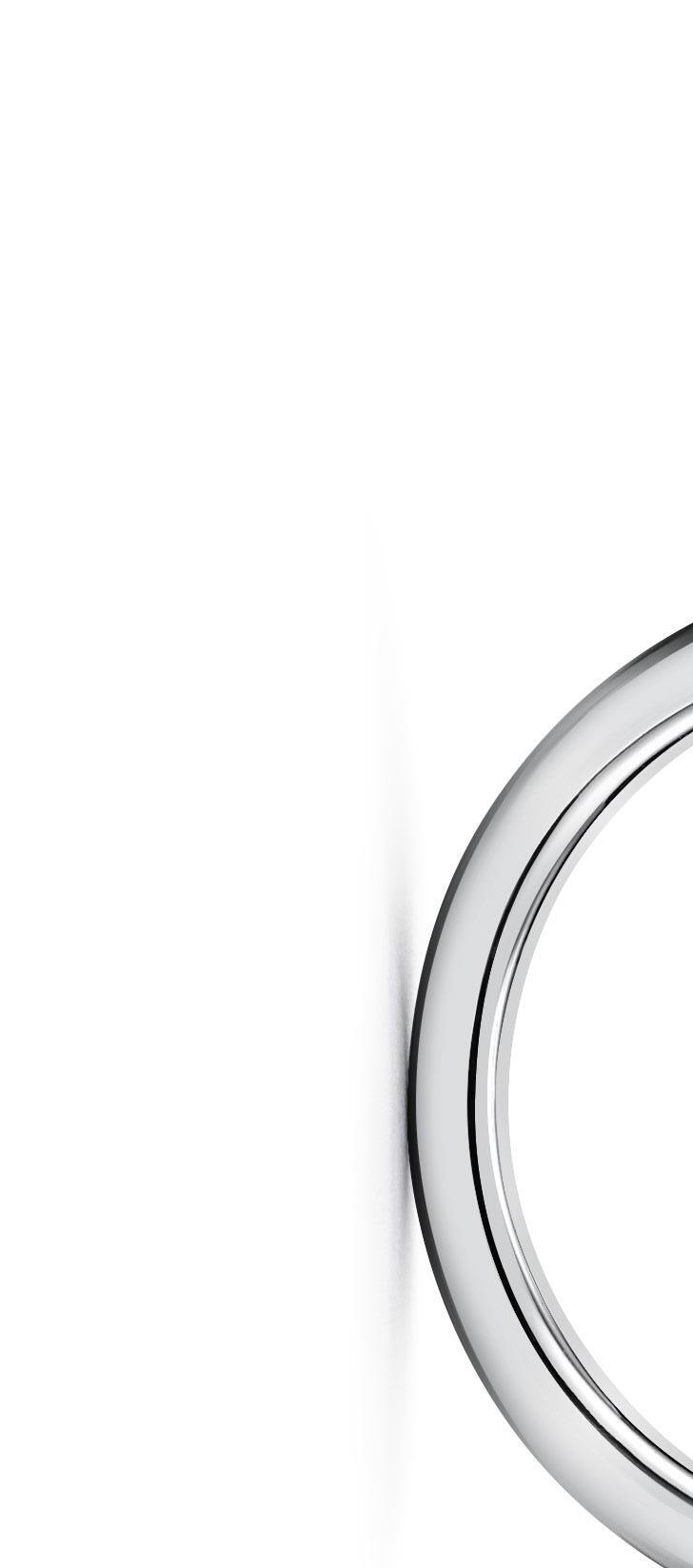
 Rings, Tiffany & Co.
Rings, Tiffany & Co.
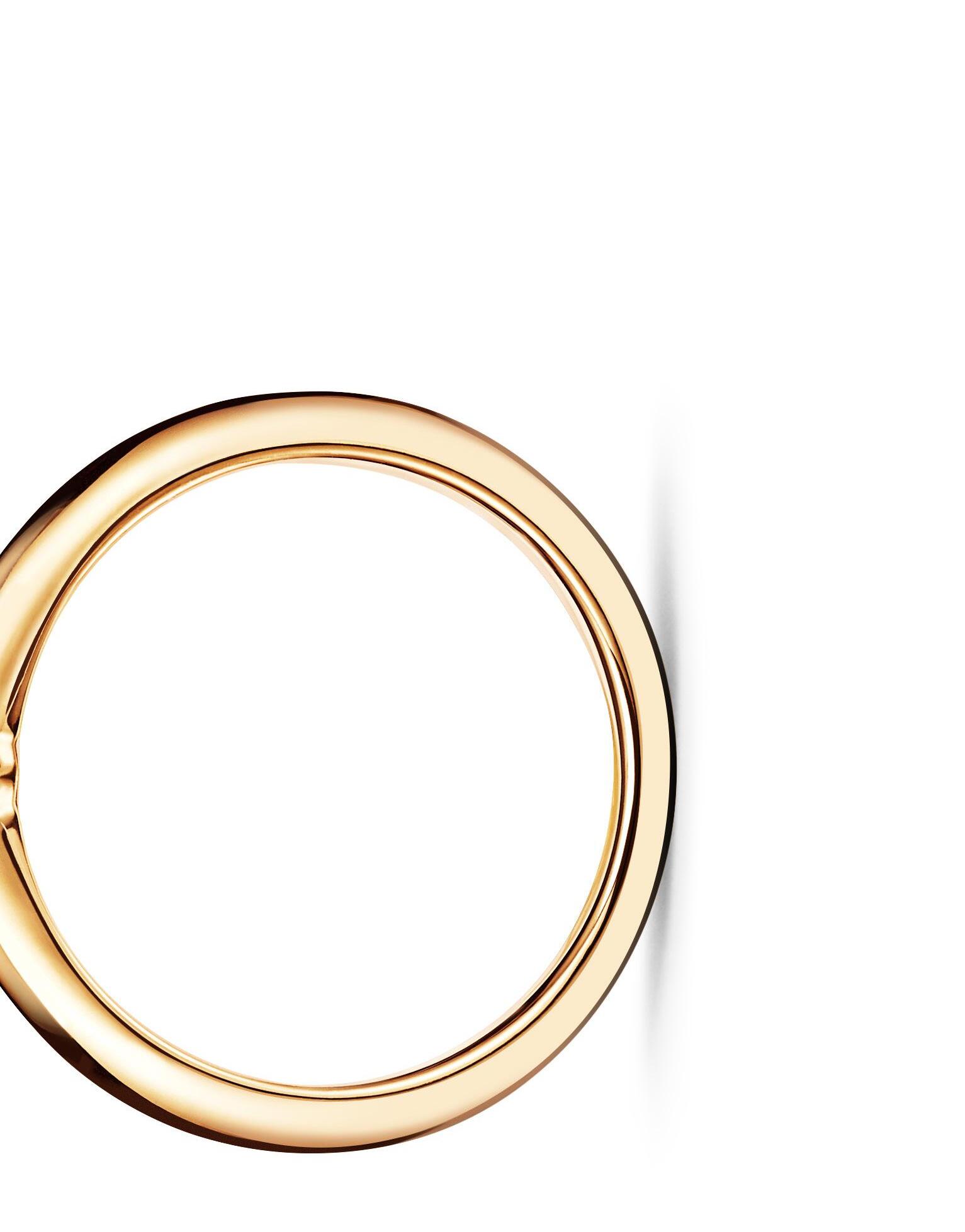

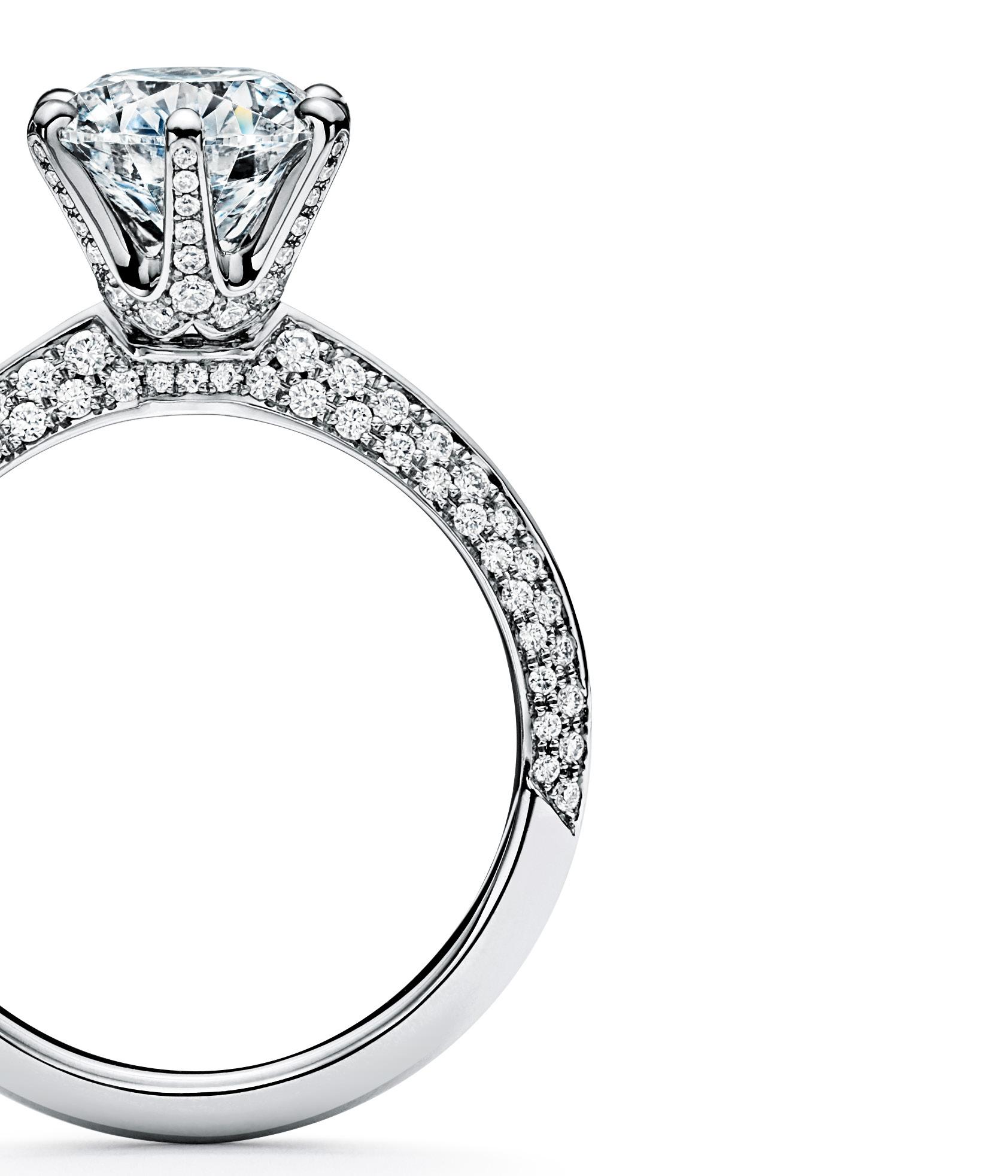
The Wide Range of Historic Diamond Engagement Ring Styles




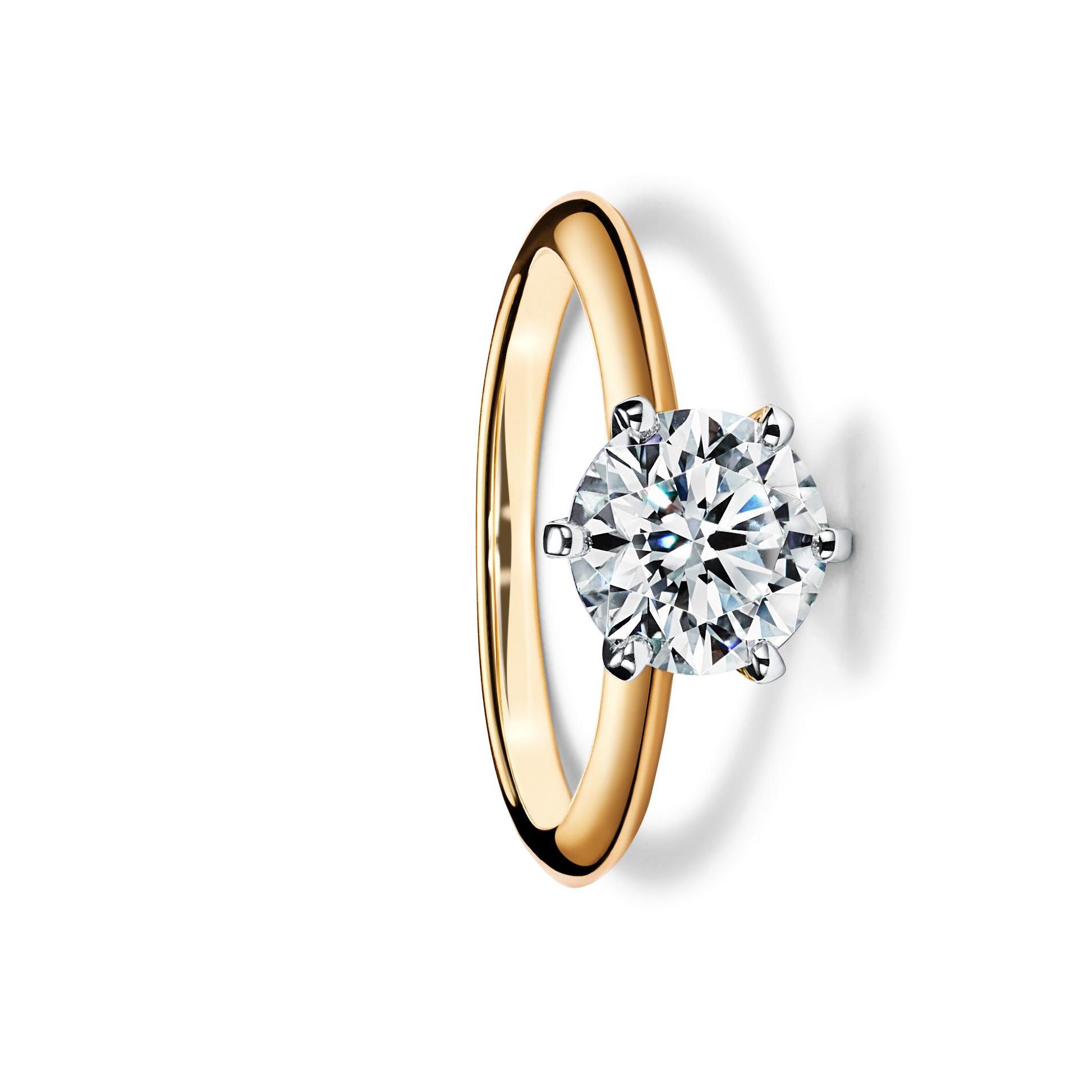
Diamond engagement rings were trendier than you might think from the 15th through the 19th centuries. Rings reflected prevailing jewelry styles as opposed to being made in a classical mode. During the Renaissance, for example, diamond engagement rings often displayed the same kind of decorative enamel found on all kinds of jewelry during the era. They usually centered on a table cut or flat diamond. The look came back as part of the 19th century Renaissance revival and was worn by brides with a passion for the period. In the extravagant courts of 18th century Europe, Queen Charlotte—wife of George III of England who was friends with Marie Antoinette and nicknamed the Queen of Diamonds—doubled down on the fashion for diamond engagement rings. The stylish royal decided to literally outshine everyone and wear a diamond wedding band with her delicate diamond engagement ring. Bigtime solitaires hadn’t taken hold in the category yet. In 1839 when Prince Albert presented a gold and gem-set snake engagement ring to Britain’s young Queen Victoria, it sent a message to the world that the creature was a symbol of everlasting love. Her ring sparked a passion for snake jewelry including gold and

The First Diamond Engagement Ring
Many believe the first diamond engagement ring was given to Mary of Burgundy by the Archduke Maximilian of Austria in 1477. A letter written to Maximilian before he proposed read, “At the betrothal, your Grace must have a ring set with a diamond and also a gold ring.”Like all precious stones at the time there was symbolism behind the gem. Diamonds sparkled with the purity of fidelity or faithfulness and durability. Lapidaries did not have the tools to cut a diamond. Jewelers mounted them in their natural octahedral form, which looks like two pyramids joined at the base. A Niklas Reiser painting of Mary from the Renaissance era showing her wearing a solitaire on her right hand, is often used to illustrate the point of her engagement ring. Though it is not known with absolute certainty if the ring in the painting is her engagement ring, it could have been. During the time engagement rings were often worn on the second or the third finger of the right hand, because people believe that one or both of these fingers had veins connected to the heart.
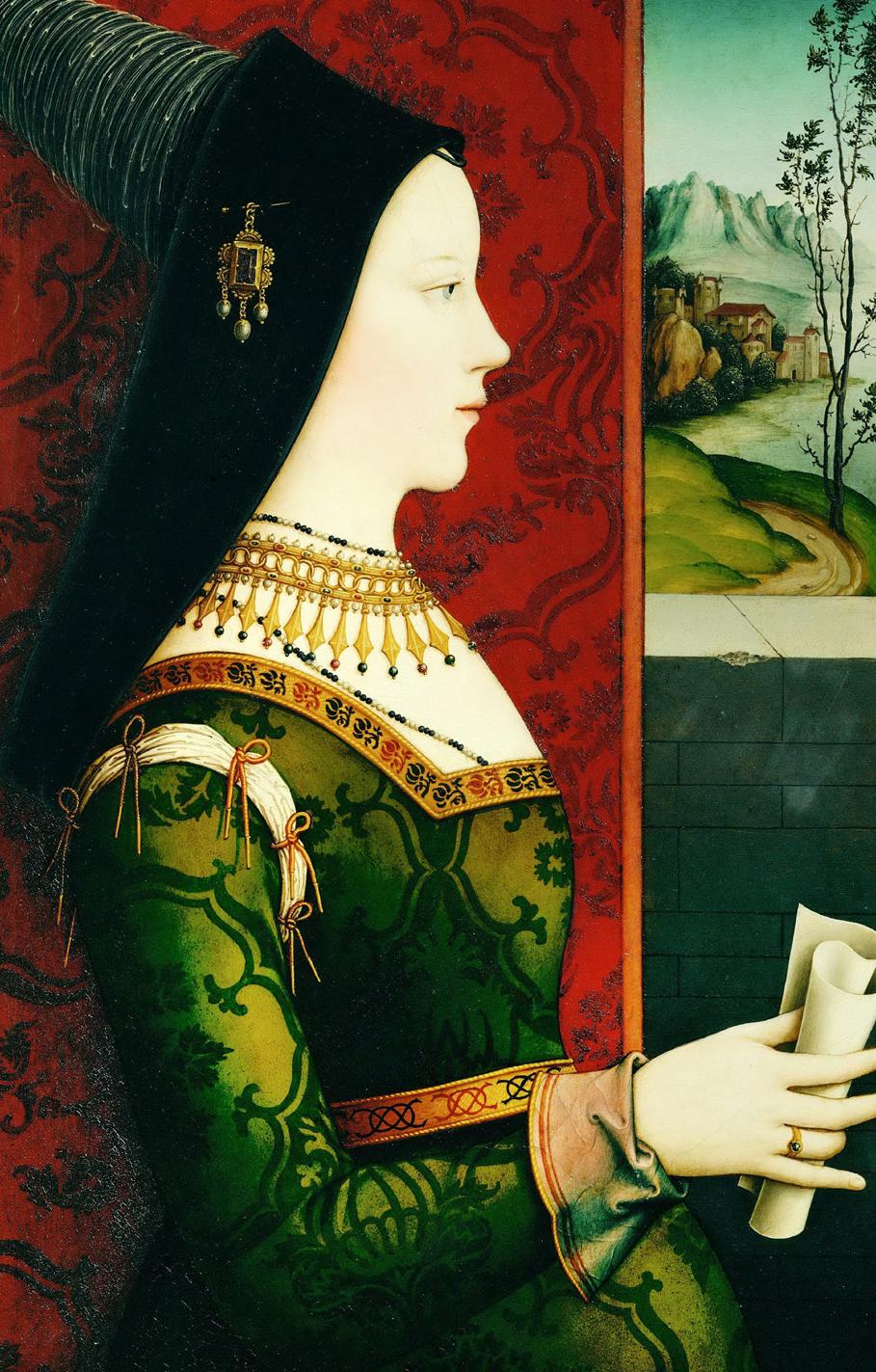
62 | THE EDIT 2023
Thomas Gainsborough Portrait Of Queen Charlotte Of England And Her King Charles Spaniel Painted Around 1781. Photo ©Royal Collection Trust
The Ti any Setting That Changed Everything
any Setting engagement rings with a variety of mountings including rose and yellow gold, platinum and diamonds. Platinum, yellow gold and pavé-set diamond Ti any Setting engagement rings. In 1886, the year the Ti any Setting launched, the Statue of Liberty was open to the public and Coca-Cola appeared on grocery shelves for the first time. Like those other American icons from the era, the any Setting has endured. Founder Charles Lewis Ti any conceived the Setting to glorify a single diamond as a symbol of everlasting love. The design had prongs lifting a diamond above a slender gold band. Light passed between the ring prongs and through the diamond, heightening its brilliance. The deceptively simple style set the stage for the gem to shine as the star and established the new mode for modern engagement rings that dominated the 20th century and continues to be popular to this day. First Lady Eleanor Roosevelt was one of the first high profile women to wear a Ti any Setting engagement ring. She received the jewel centering on a 3.4-carat diamond from Franklin Roosevelt in 1904 and shortly after wrote him a note saying, “You could not have found a ring I would have liked better.” ♦
Fancy
Shape Diamonds Sing in Engagement Rings During the Jazz Age


Innovations in diamond cutting brought fancy diamond shapes to the forefront in engagement rings during the 1920s. The advancement in lapidary techniques gave square shapes, the rectangular emerald cut and boat shaped marquise sharper edges. Lapidaries could also cut long slim sleek facets resulting in brighter gems for engagement rings. One of the most well-known fancy-cut diamond engagement rings of the period belonged to the Hollywood movie star Norma Shearer. In 1927 when the young producer Irving Thalberg, known as “The Boy Wonder of MGM” proposed to Shearer in his o ce, he showed her a tray full of engagement rings and told her to pick one. The actress chose a large marquise shape diamond set on a slender platinum band. After she received the ring, Shearer wore it in all her movies where she played a married woman. ♦
A Diamond Is Forever Becomes Part of the Engagement Ring Lexicon at Mid-Century
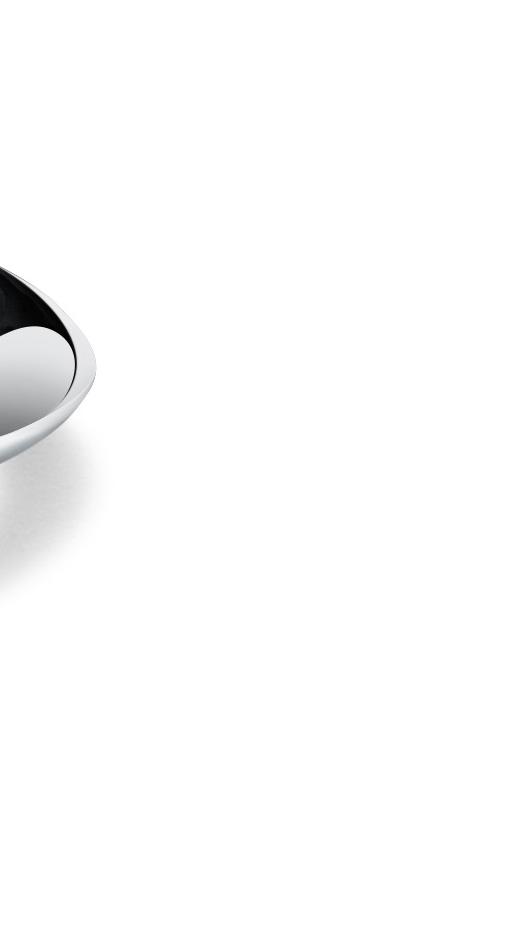
In 1947, a few years before she became Queen, Princess Elizabeth and Prince Philip posed together at Buckingham Palace after they announced their engagement.
There are some who believe diamond engagement rings only came into vogue during the mid-20th century. The theory, which we have clearly proven wrong, is based on the success of the “A Diamond Is Forever” ad campaign conceived by N.W. Ayer copywriter Frances Gerety in 1948. While the line has become legendary and certainly helped encourage couples to choose a diamond at the time, there were other factors that added to the midcentury enthusiasm for the gem. In 1947 a few years before she became Britain’s Queen, Princess Elizabeth announced her engagement to Prince Philip and showed the press and public her engagement ring with a 3-carat round diamond center stone flanked by smaller diamonds set in platinum. The glamour of the fairy tale royal romance and the fascination with every detail of it was another source of inspiration for couples to get diamond engagement rings during the post war marriage boom
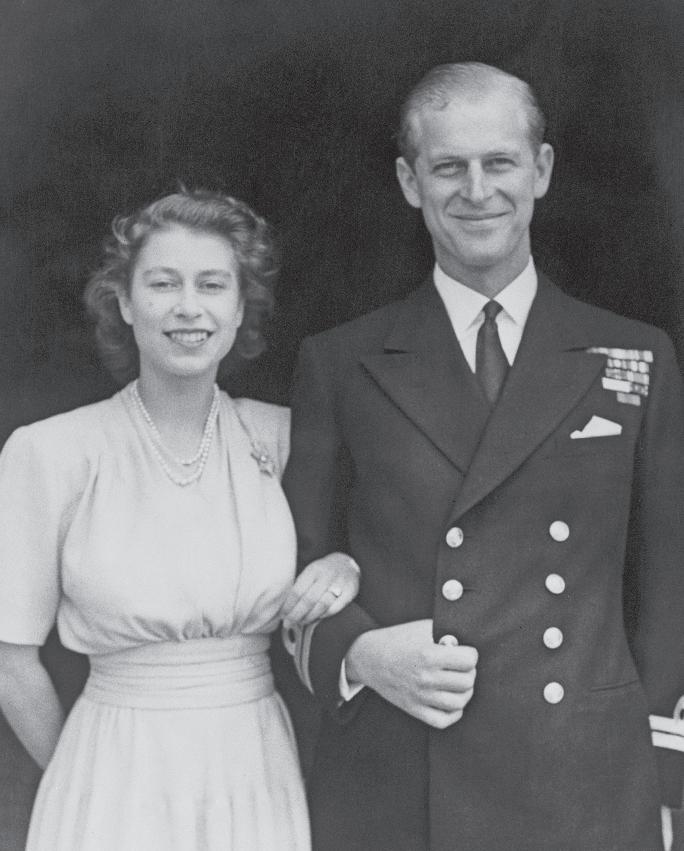
THE EDIT 2023 | 63
♦
Photo by Fox Photos/Hulton Archive/Getty Images
STYLE
Actress Norma Shearer wearing her marquise-cut diamond engagement ring in a publicity still from around 1930.
Mike
with
Taylor who is wearing her 29.4-carat diamond engagement ring in September 1956.
The First Blockbuster Hollywood Engagement Rings

A few years after Marilyn Monroe sang “Diamonds Are A Girl’s Best Friend” in the 1953 classic film Gentlemen Prefer Blondes two iconic movie stars seem to be embodying the statement with their ginormous emerald cut diamond engagement rings that raised the bar and set the standard for Hollywood glamour. Elizabeth Taylor received a 29.4-carat emerald-cut diamond engagement ring from film producer Michael Todd at the end of 1956. When asked about it by the press, Todd joked that “it was not quite 30 but twenty-nine-and-ahalf carats.” Taylor referred to her big diamond as “My ice-skating rink.” Prince Rainier of Monaco gave Kelly a Cartier ring with a 10.48-carat-emerald cut diamond flanked by two baguettes. The jewel received international attention because Kelly was going to be leaving Hollywood to become royalty when she married the prince. Before she left, she wore the ring in her final film High Society (1956). Grace Kelly’s ring is given a Technicolor close-up when her ex-husband in the film, played by Bing Crosby, remarks to her new fiancé, “Some stone George. Did you mine it yourself?” At one point in the production, Kelly rather hilariously polishes the ring on her dress and admires it. ♦
Top to bottom: At the 2003 premiere of ‘Daredevil,’ Ben Affleck waves to the crowd with Jennifer Lopez who is wearing her pink diamond. Seal and Heidi Klum who is wearing her yellow diamond engagement ring at the 2004 World Music Awards in Las Vegas.
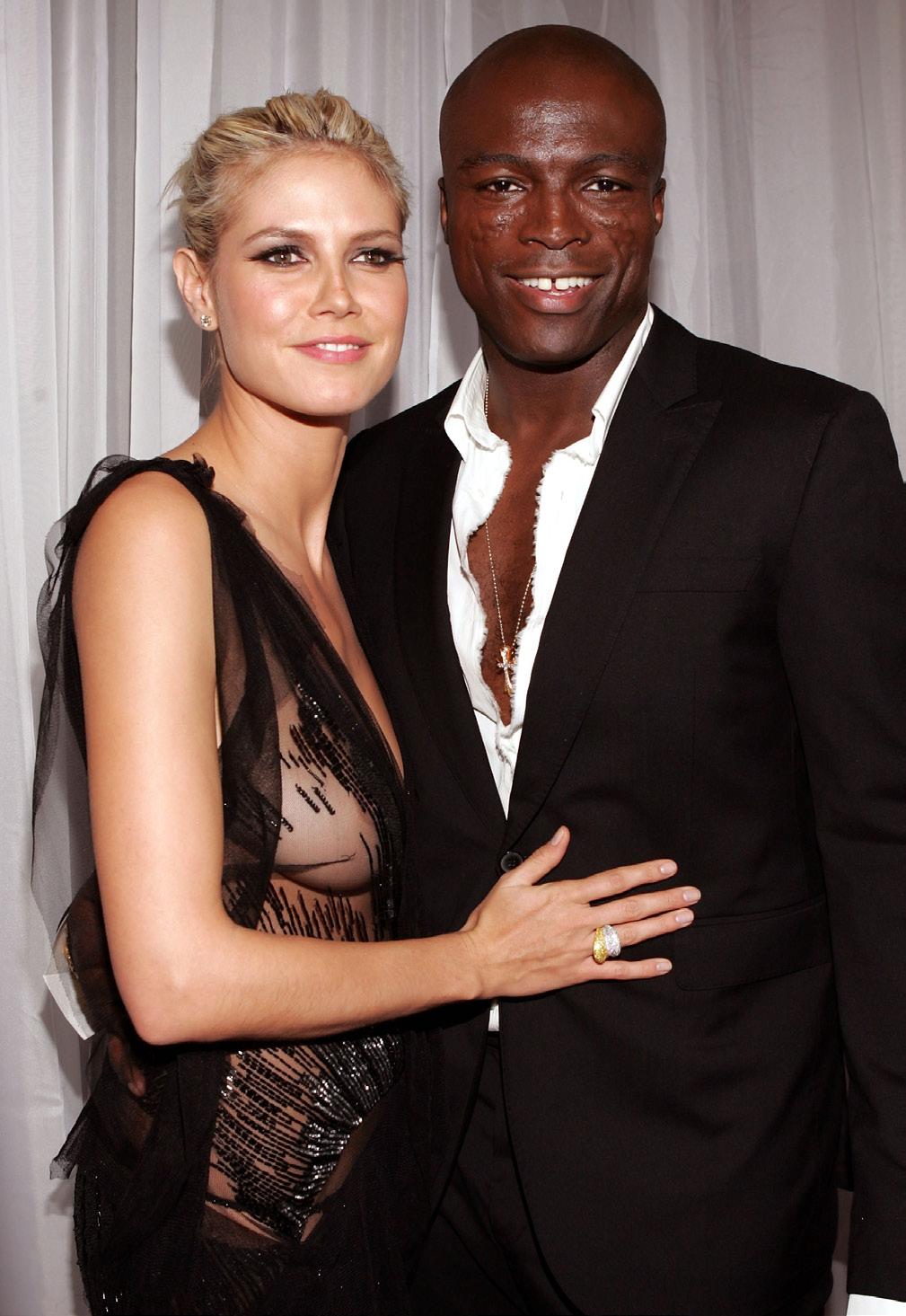
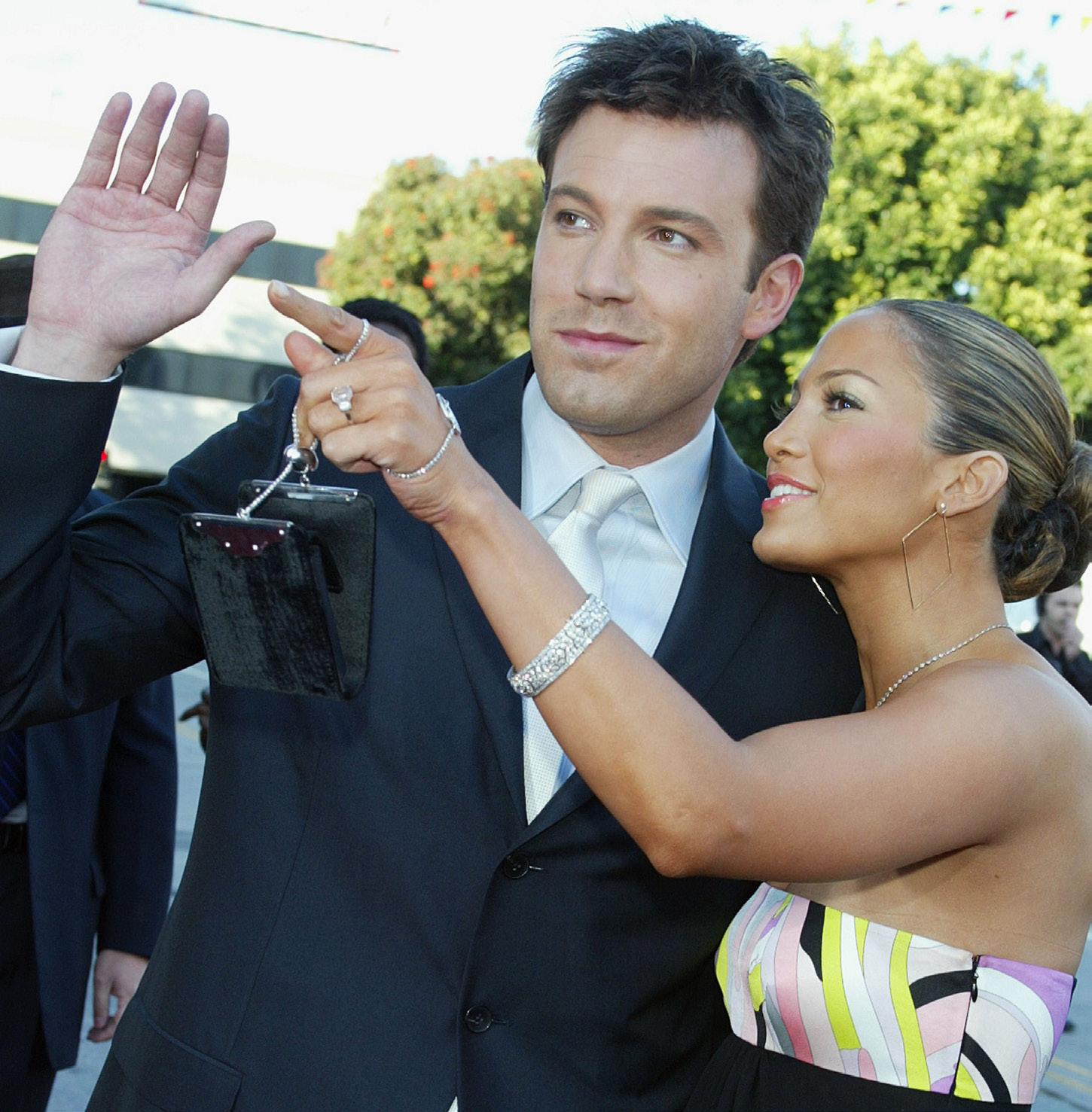
64 | THE EDIT 2023
Todd
Elizabeth
Y2K Sweetness and Light: Yellow and Pink Diamond Engagement Rings
In 2002, shortly after Jennifer Lopez released her “Jenny from the Block” video which has been called a Y2K mood board and features Ben A eck, the actor proposed with a 6.1-carat radiant-cut fancy intense pink diamond with two trapezoid white diamond side stones mounted in platinum and pink gold from Harry Winston. JLo announced the couple’s engagement during an ABC Primetime: Special Edition interview with Diane Sawyer on November 13, 2002. Bennifer famously the called it quits before getting married, but the pink diamond engagement ring still launched a new found love for the fancy-colored diamond. In 2004, Heidi Klum and Seal did for yellow diamonds what Ben and Jen did for pinks. The singer made his proposal to the super model a dramatic event that was extensively covered by the press after the fact. It began with a helicopter ride to an igloo built near a mountain top of a Canadian resort. Once the couple landed, Seal popped the question with a 10-carat oval shaped yellow diamond set on a slender pavé-set yellow diamond band. The jewel was designed by Lorraine Schwartz who became the go-to engagement ring source for so many stars after creating Heidi’s ring including Beyoncé and Jay Z and Kim Kardashian and Ye (aka Kanye West). ♦
Diamond Engagement Rings Are All About Individuality Today
More than ever before in the history of engagement rings, today many brides choose styles that have a sense of individuality in the design. The reason for the change is surely the winds of fashion and women’s awareness from press coverage not to mention internet searches that prove a lot of different choices available. In other words, the ring of your dreams that reflects your personality can be found. For some women, of course this can mean something understated. Jennifer Lawrence wears a gorgeous emerald cut diamond engagement ring that by Hollywood standards is low-key. Individuality in engagement rings can also mean something bold and different. There are few engagement rings quite like the jewel Colin Jost gave Scarlett Johansson. Created by Taf f in designer James de Givenchy, the ring has an approximately 11-carat pear-shape light brown diamond set on a curved brown ceramic band. The ring echoes Johansson’s iconoclastic style and love of jewelry. When Ben Affleck proposed to Jennifer Lopez 20-years after they were initially engaged, he once again chose a fancy-colored diamond. This time the gem was a rare 8.5-carat cushion modi f ied brilliant green diamond. As JLo shared when she announced the engagement, “Green has always been my lucky color and now, for sure, it always will be.” ♦
Neil Lane and Bachelor Nation Raise America’s Diamond Engagement Ring IQ
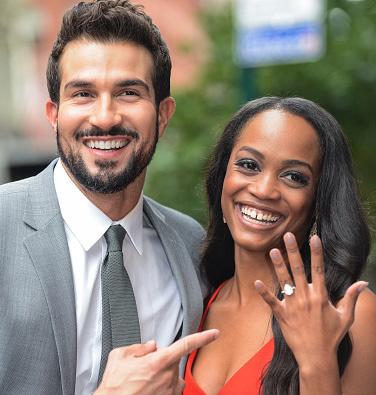
Since 2009 when Neil Lane became the engagement ring expert on The Bachelor, he has not only helped grooms choose the perfect jewel on the show, he has also educated the audience about the f iner points of engagement ring designs. Inspired by Art Deco geometry and Edwardian decorative elements, Lane points out design details in his work. He also reviews the f iner points of a diamond’s quality and special shapes such as the Asscher or cushion.. ♦

THE EDIT 2023 | 65
STYLE
Colin Jost with Scarlett Johansson who is wearing her brown diamond engagement ring among other Taffin jewels at the 26th Annual Screen Actors Guild Awards in 2020.
From The Bachelorette, Bryan Abasolo with Rachel Lindsay who is wearing her Neil Lane engagement ring outside of AOL Studios in 2017. Photo by RayTamarra/GC Images
Written by CHRISTINE WHITNEY
Photographed by SHANIQWA JARVIS
rare GEM Gabrielle union g
66 | THE EDIT 2023
The actress and producer is the visionary we need.
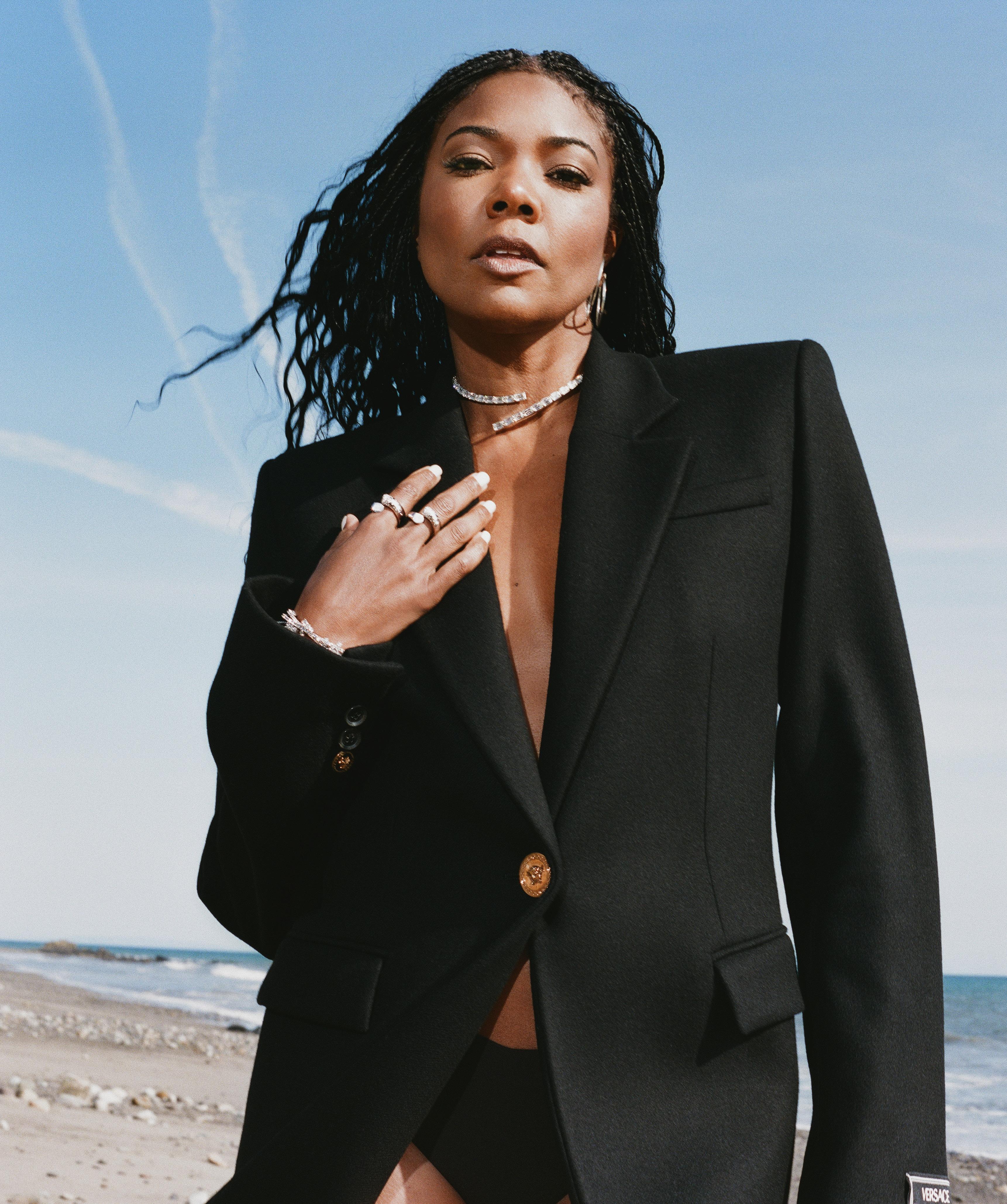 Gabrielle wears Wempe bracelet, Tabayer rings, William Goldberg necklace. Messika hoop, Magda Butrym blazer.
Gabrielle wears Wempe bracelet, Tabayer rings, William Goldberg necklace. Messika hoop, Magda Butrym blazer.
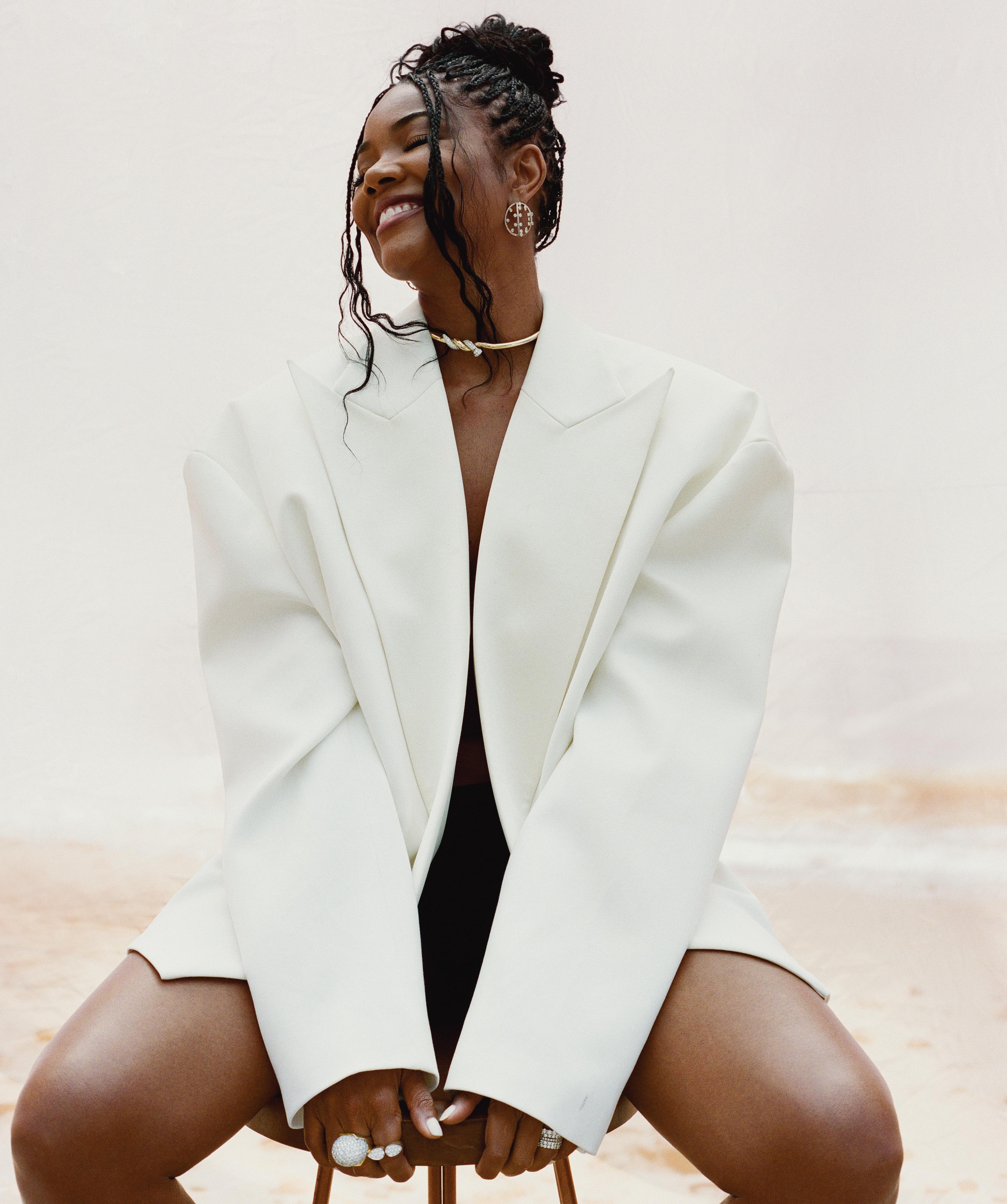
Belperron bracelets, ring and necklace, Ana Khouri earring, Gabrielle's own rings, Loewe top, Norma Kamali skirt. Opposite page: David Webb rings and necklace, Mateo earrings, Gabrielle's own rings, Magda Butrym blazer.

THE EDIT 2023 | 69
When Gabrielle Union got engaged to Miami Heat legend Dwyane Wade in 2013, the power couple’s 8.5 carat engagement ring was the jewel that launched a thousand headlines. “They started writing little op-eds about it and estimating what the cost might be, and I became terrified to wear it in public without a full armed security detail,” Union says. “Then wishing retroactively that I had gotten my nails done, because they clowned my nails when I was like, ‘I said yes.’ My nails look like I have been digging ditches for the last 17 years.”
In addition to having a winning sense of humor, Union is a force of nature, so it’s fitting that when she spoke to Only Natural Diamonds from Miami for her Zoom interview, a tropical thunderstorm was raging outside her window. “I kind of love it,” she says. At 50, the actress and producer’s robust career spans three decades—her early credits include basically every seminal ‘90s sitcom (Family Matters, Moesha, Sister, Sister and The Steve Harvey Show, to name just a few) as well as iconic teen blockbusters like 10 Things I Hate About You and She’s All That. She gave us main character energy in the ahead-of-itstime Y2K cheerleading epic Bring It On, wherein she catapulted to fame as the Compton Clovers’ cheer captain Isis. (Worth re-watching, and thank us later.)
Bad Boys II, The Birth of a Nation and Truth Be Told are just a few of the career-defining works in her 88-credit IMDB dossier. Next up: My Journey to 50, an incisive two-part docu-series chronicling her recent travels through Africa with her family and friends, which airs June 15th on BET+; and The Perfect Find, a star-studded romantic comedy adapted from the Tia Williams novel, which debuts on Netflix June 23rd.
While at this point Union requires no introduction, if you’re lucky enough to get one, you’ll be glad you did. She is, in a word, brilliant. Below, the actress, producer and mom brings the real talk to everything from red-carpet diamonds to raising strong daughters to the need for a serious sea change in Hollywood.
Only Natural Diamonds: v
Gabrielle Union: I love the photographer videographer team. I had randomly met them at a party a few days before, and so that was kind of awesome. Shooting on the beach in Malibu is always fun. Those pictures are always so, dare I say, iconic. It's not often that you get to be black on the beach, being fly and draped in diamonds. It was also near one of my rock heroes; Pat Benatar does not live far, is what I will say. Every time I'm over there, I'm like, "Oh my God, I'm close to greatness."
OND: Were there any particular diamonds that were scene-stealers?
GU: All of them. But the one that stood out most we were calling the Hope Diamond. I'm sure there's a real name for it—this massive Hope-looking diamond that I got to wear for the last shot of the night. We were in a gorgeous infinity pool that looks like it's dropping into the ocean. It's just sick. I'm in this gown-ish dress—it's sort of flowing in the pool— and this massive infinity stone. It was so big and brilliant. It should probably be in a museum, it's so majestic.
OND: What are some of your most vivid diamond memories?
GU: Once upon a time, I was married to a di erent person and I remember when he proposed, it felt like, oh my gosh, this [diamond] is so huge. Oh my God, do I even deserve this? Holy shit. Oh my God, somebody loves me this much. And then later I realized that I ended up paying for my ring myself when I had to take over his debt. By the time I got engaged to my now-husband, and he proposed (it was a full family proposal), I was just staring at it. The first thought that popped into my head was, “I wonder if I'm going to have to pay for this because maybe I need a smaller diamond.” I was just like, “wow.”
OND: Any favorite diamond memories from the red carpet?
GU: For the Image Awards in March, [security for] the designer I was wearing, they were like, "Going to need those back, ma'am. When are you due at home?”I was like, "Oh, we just came to eat." They came all the way downtown, into the Soho House. And the man, literally, because I couldn't get it o , takes the jewels o of my neck during dinner. Which I don't know if you remember the original Dark Crystal, the Skeksis when they get stripped and end up just being these old…people…That's what I felt like in the middle of Soho House when
70 | THE EDIT 2023
W
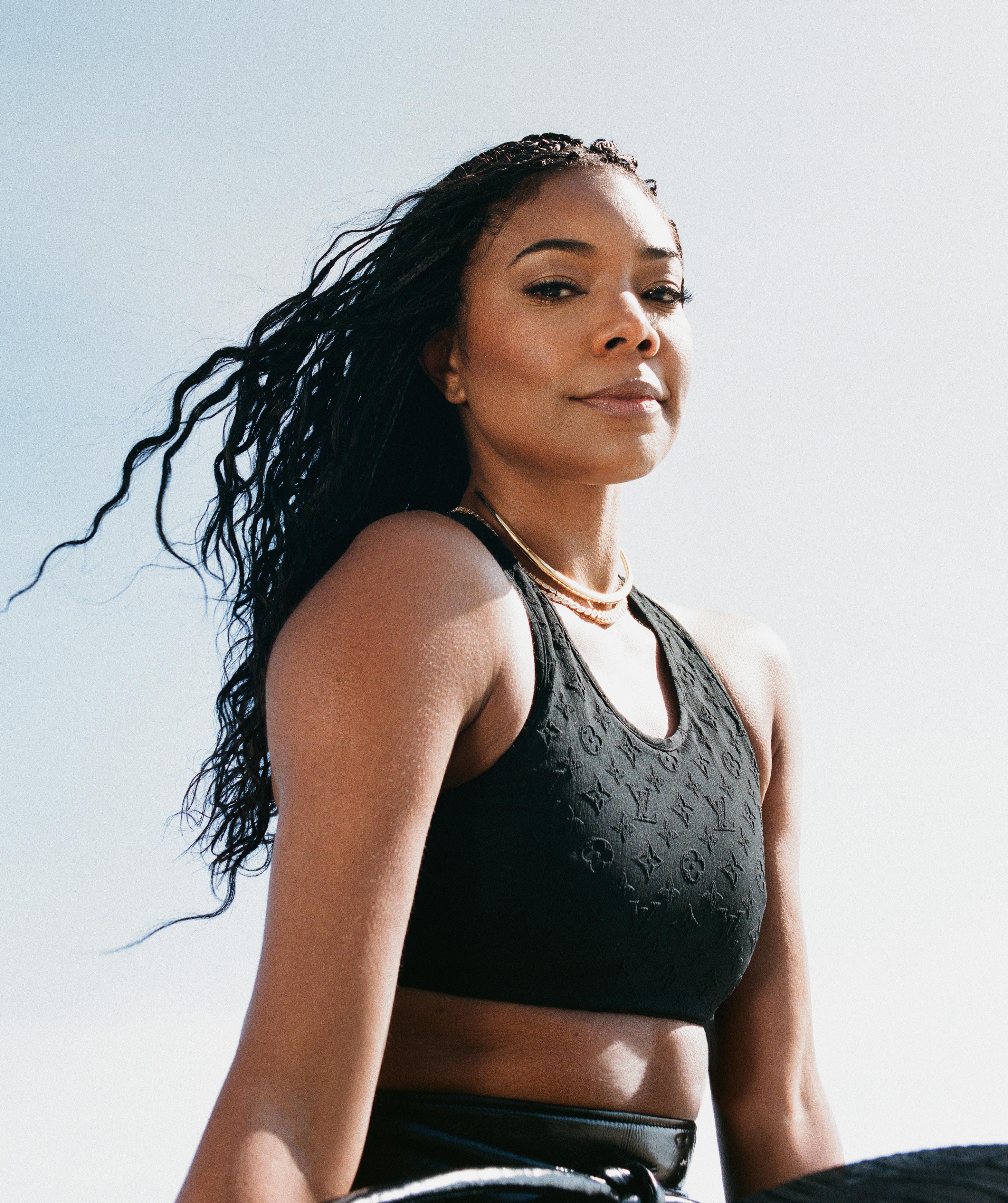 Skeie's Jewelers necklace (top), Anita Ko necklaces, Louis Vuitton top.
Skeie's Jewelers necklace (top), Anita Ko necklaces, Louis Vuitton top.
origin story.” It starts with me coming out of this river with new, almost innate knowledge… All I know is that I have more knowledge about the enormity and the depth of the horrors of every part of the slave trade… That whole first episode is just emotional.
OND: You also have a film coming out on Netflix, The Perfect Find [adapted from the novel by Tia Williams]. Tell us everything.
GU: It's rare to go from an idea to a novel to option to adaptation to selling to casting to shooting, and then getting distribution and marketing dollars. It seems like it's easy because there's so much content that is put out. But if people understood how long it took, how many tears are shed, how many arguments, how much rage (passion fuels these projects, even the silly ones), I think people would have a di erent appreciation for every stage and every person that contributes to the making of these little tiny miracles that we call Hollywood productions. But it's good. And it's the older woman, younger man, and I hadn't really seen us be able to luxuriate in that space really since How Stella Got Her Groove Back, which was 20-plus years ago. I wanted to revisit that in a less vacation way.
What do women of a certain age dare dream of for ourselves without being considered ridiculous or past our prime? That one stung… Just to show that we don't disappear, that we're not magically invisible when we hit 40. That we are sexual beings and that we are options. We have them and we are them, and all of what that means.
OND: What were the highlights of working on the film?
GU: The first high was when Netflix bought it. Getting Numa Perrier [to direct], which was a coup, and getting everyone on board for a new-ish black woman director was, again, no easy feat. Especially when it's not a bag of Doritos. If our budget was a bag of Doritos, they would've been like, "Have at it. Bring all the new people you want." But when you have at least a little bit of money to play with, the gatekeepers come out in full force. And you have two people to choose from who are booked out for the next a hundred years. So it was big that everyone was in alignment about why Numa is so special and why it can only be her to direct this. So those were huge. Getting Gina Torres. Actually all my friends, because they're all freaking working! Some of my favorite people on the planet: Gina Torres, Aisha Hinds, La La [Anthony]—they all have shows that for the most part go around the calendar year. So being able to clear their schedules to be able to do this was huge.
OND: Were there any lows?
GU: The harder parts were being the more experienced nuts and bolts producer on set, and having to star at the same time.
I have to make sure I’m present and locked in with the character, but also—shit, gotta put that fire out. If I have to stay on top of payroll at the same time and I’m staying on top of my lines, I’m ok with that. My special skill is that I don't know if I'll ever fully embrace the bourgeois. I am proletariat down to the socks. I am a worker bee—my alignment and loyalty is to workers. When you come into Hollywood that way, whether you're number one on the call sheet or 22nd, you know that if any one of these people calls out sick on this call sheet, something awful is happening. Everyone is incredibly important… It's definitely a challenge. And it doesn't always ingratiate you with some of the bourgeois of a production. But that's who I am; that's who I've been. I can never look at my plate overflowing and be like, "Well, my check came out; sorry the PAs are pooling their money for a potluck to eat today." No. I will never be okay with that. So if my ear is to the street and I hear rumblings, I know where the issues are, and I need to address those in real time.
OND: How did you juggle starring and producing, or having your focus pulled in di erent directions?
GU: I guess it's just what I've been doing my whole career. I don't know if that's just what it is to be black in Hollywood or a black woman in Hollywood. You sign up for one job and you end up with 17. They get so used to you doing somebody else's job or covering for somebody, I've always had to be focused on a thousand things. Whether that's happening on set, or in my life, or as the financial breadwinner for a long time for my extended family. I support several households. I've just never had the luxury of just doing one thing or concentrating on one thing. I've had one job where I was like, "Oh, wait, I only have one job. Oh, this is awesome."
I just had that last year on Truth Be Told. Octavia [Butler] and I are close and she runs a ship the way I run a ship. I was like, "You got it? Okay." I'm like, "I'm here." But she had it and I was able to just focus on my work. I like to think—patting myself on the back—it was the best performance I've had in my career. I had the time to use every tool in my toolbox. And granted, was I doing double sessions of therapy? Absolutely (thank god for Zoom therapy). But I was able to unlock some things that I've never been able to unlock.
OND: What would you like to see change in Hollywood?
GU: I mean, everything—buckle in. Starting is pay. I don't know personally of any creative of color in any part of this business, whether that's a PA, or a top director that is paid, and respected, and has carte blanche in this company in relation to their white peers. I've never seen it. Ever. Even when somebody looks like, oh, they're really getting paid. It's not
72 | THE EDIT 2023
“We’re not magically invisible when we hit 40”
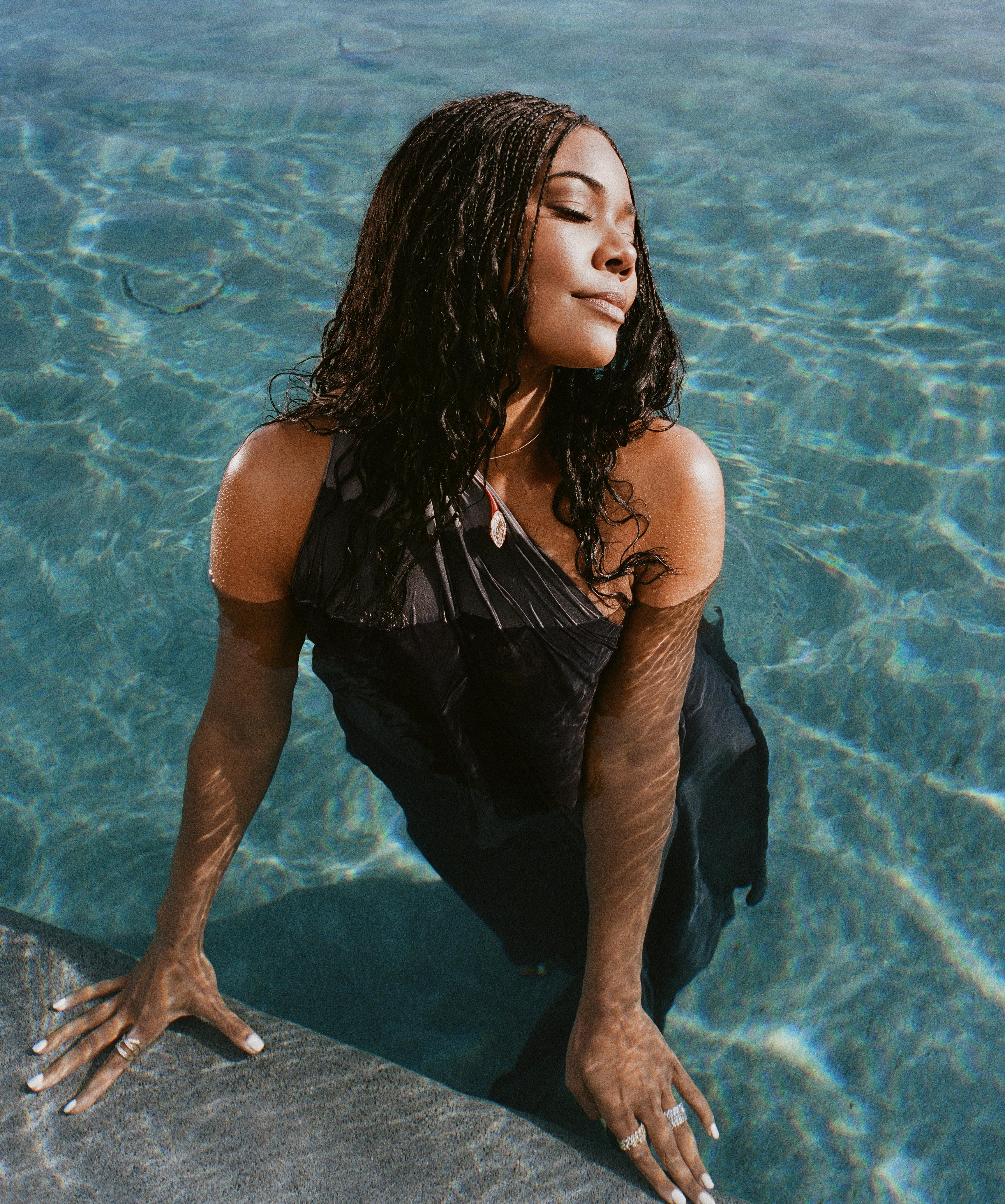 From left to right: Anita Ko ring, Taffin necklace, Sydney Evan ring, Gabrielle's own rings, vintage Donna Karan Collection dress.
From left to right: Anita Ko ring, Taffin necklace, Sydney Evan ring, Gabrielle's own rings, vintage Donna Karan Collection dress.
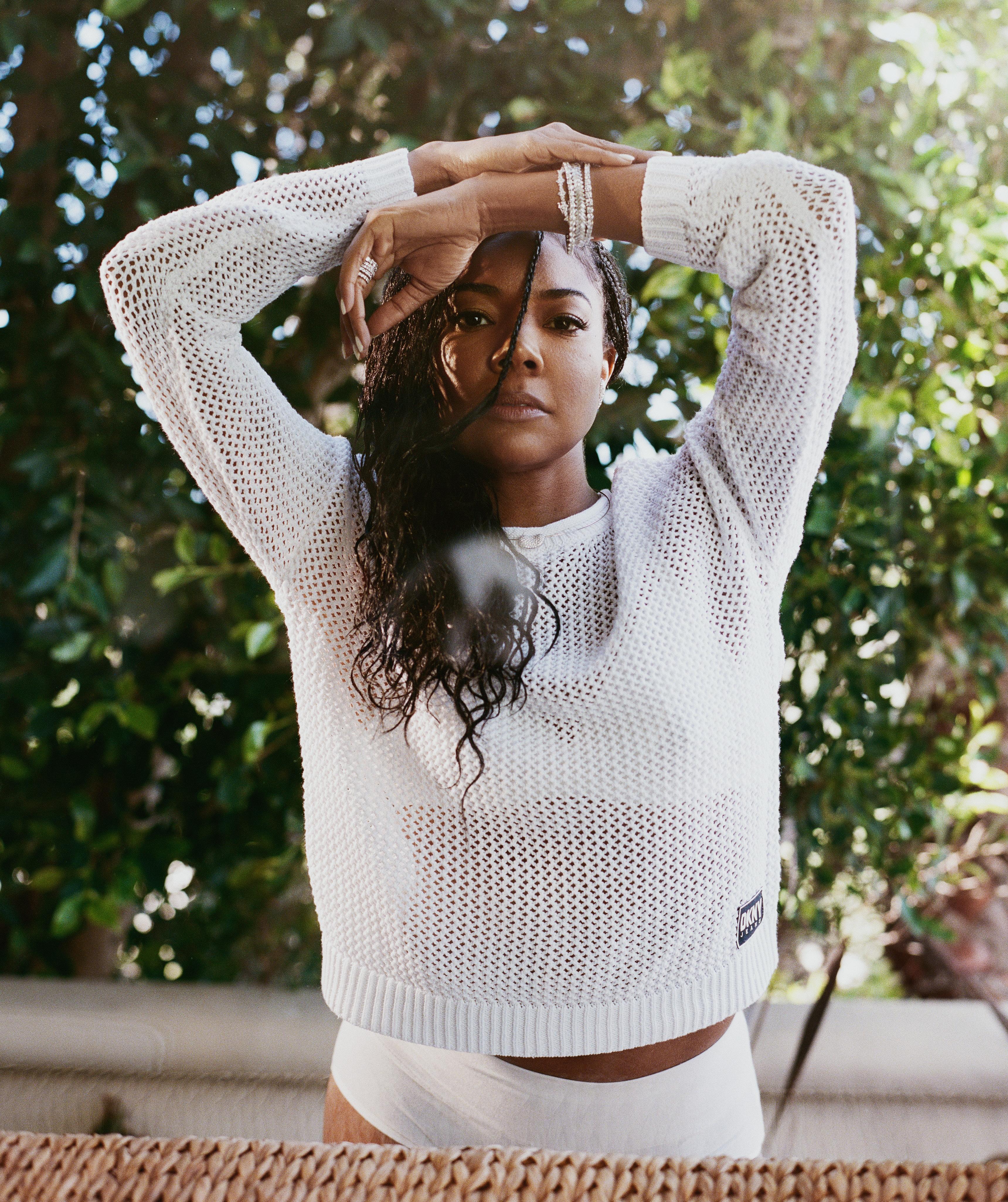 From left to right Gabrielle's own rings, Tiffany & Co necklace, Anita Ko bracelets, Jacquie Aiche bracelet, Ana Khouri ear cuff, DKNY sweater, Skims bralette and briefs.Opposite page: David Webb rings and necklace, Mateo earrings.
From left to right Gabrielle's own rings, Tiffany & Co necklace, Anita Ko bracelets, Jacquie Aiche bracelet, Ana Khouri ear cuff, DKNY sweater, Skims bralette and briefs.Opposite page: David Webb rings and necklace, Mateo earrings.

THE EDIT 2023 | 75
he stripped me of my jewels. But it was also very funny. I was like, “Do people think they got repossessed?” But we were all laughing.
OND: That’s a bold move of them…
GU: I'm guessing with that kind of vibe, it was very expensive. It had to be something pretty significant for them to show up at the restaurant. Because there's been other days where they will wait for you to get home. We went from the Spirit Awards to the airport because we were flying to Paris. They're not playing around.
OND: Are there any natural diamond pieces that you wear regularly?
GU: Well, I had a wedding band. It was a circle of diamonds. And what I didn't know is that my husband had bought a backup just in case. I think I lost it, and I'm scouring. Our assistant was like, "You know he has an extra one. Just wear that until you find it." So I get the extra one, I'm wearing that. No one has caught on. I take it o to wash my face at night, and I guess I left it on the counter. The next day it's missing. So I'm panicking, because now I think I'm down two wedding rings. So I go to the jeweler that he bought them from, and I order two more.
When they came in, of course they called my husband. And there's a point where he brings me a stack of four diamond rings— all identical. He had taken them to teach me a lesson about putting my jewelry up, and securing it and whatnot. So now I wear five of these rings—somebody else had given me one, so I put that in the middle. I wear five rings that are not meant to be stacked, but they are. That's the only jewelry I wear every day.
OND: My four year old daughter once tricked me into thinking she had eaten my wedding ring.
GU: Oh my God. What is that? Kaavia is not obsessed with rings per se, but very obsessed with marriage and weddings. When she was a baby, we had one of our wedding photos in her room. I didn't think she was tall enough to see it. When we switched it to an animal theme, we were taking it out and all we hear is [her screaming] bloody murder. And we run back in there and she's like, "Where is the picture?" And basically, "Where are you guys?"
We're like, "The wedding photo?". She knew it was missing.OND: It’s so great watching what the kids gravitate towards. There's this indelible quality that's just them.
GU: I think they come out that way. I was thinking I was going to have a little mini Candace Parker. And yeah, she is Naomi Campbell. She is very clear about what she wants to wear, how she wants to move through the world, how she wants her hair to be and everything has to have glitter, sparkles, unicorns,
rainbows…
OND: You have a number of upcoming projects. Tell us about My Journey to 50.
GU: It's a two episode docu-series. Our journey with my family and friends, through four di erent countries in Africa to celebrate my 50th. When I go to any part of Africa, it changes my life. Because the more you learn about yourself, and where you truly come from, and where your people come from, and you connect with the land, it changes you. It just does every single time. And because so many of us in the diaspora have been cut o from our homeland, and our histories, and our language, and our culture and our people, connecting in any way to the continent is huge for so many of us and very emotional. It allows us to expand our worldview. So I wanted to take as many people along on that journey with me as possible.
I had a feeling that especially in bringing so many of my family members who've never been to any part of Africa and some of my friends along who have also never had this experience, I knew that it would be something that should be shared. Not catching clips on TikTok, but being able to put the trip in context and provide more information and resources around it. Anytime I can talk to anybody about that, and connecting your personal history to those travels, I'm going to do it all day and twice on Sundays. It's just my jam. It's a passion. So I'm glad that BET+ was on board. Hopefully everyone can see, and want to go for themselves, and want to do their own research.
OND: What was the most powerful moment of the experience for you?
GU: It's the moment in the river, we're at the Assin Manso River, where they would take the slaves after marching them hundreds, and hundreds, and hundreds of miles, bare feet, chained together. They would take them to this river, almost like a last bath, and that's what they actually call it, the Last Bath. Where they bathe them, they try to fatten them up, they lather them with oils and butters to try to create the appearance of good health. To then sell to the highest bidder, who then shipped them o to various ports unknown. And we were able to walk into that river and connect with spirit is probably the easiest way I could put that.
I can describe my own experience as not anything rooted in this world. And you could very clearly feel and hear our ancestors and all of it, all the di erent emotions. And everyone had a very di erent, very emotional reaction, visceral reaction to walking to the water, getting in the water, coming out of the water. And you see all of that in this docu-series. But I left that water changed and I felt like, “This is my superhero
76 | THE EDIT 2023
“There’s a lot of ways to get to the finish line.”
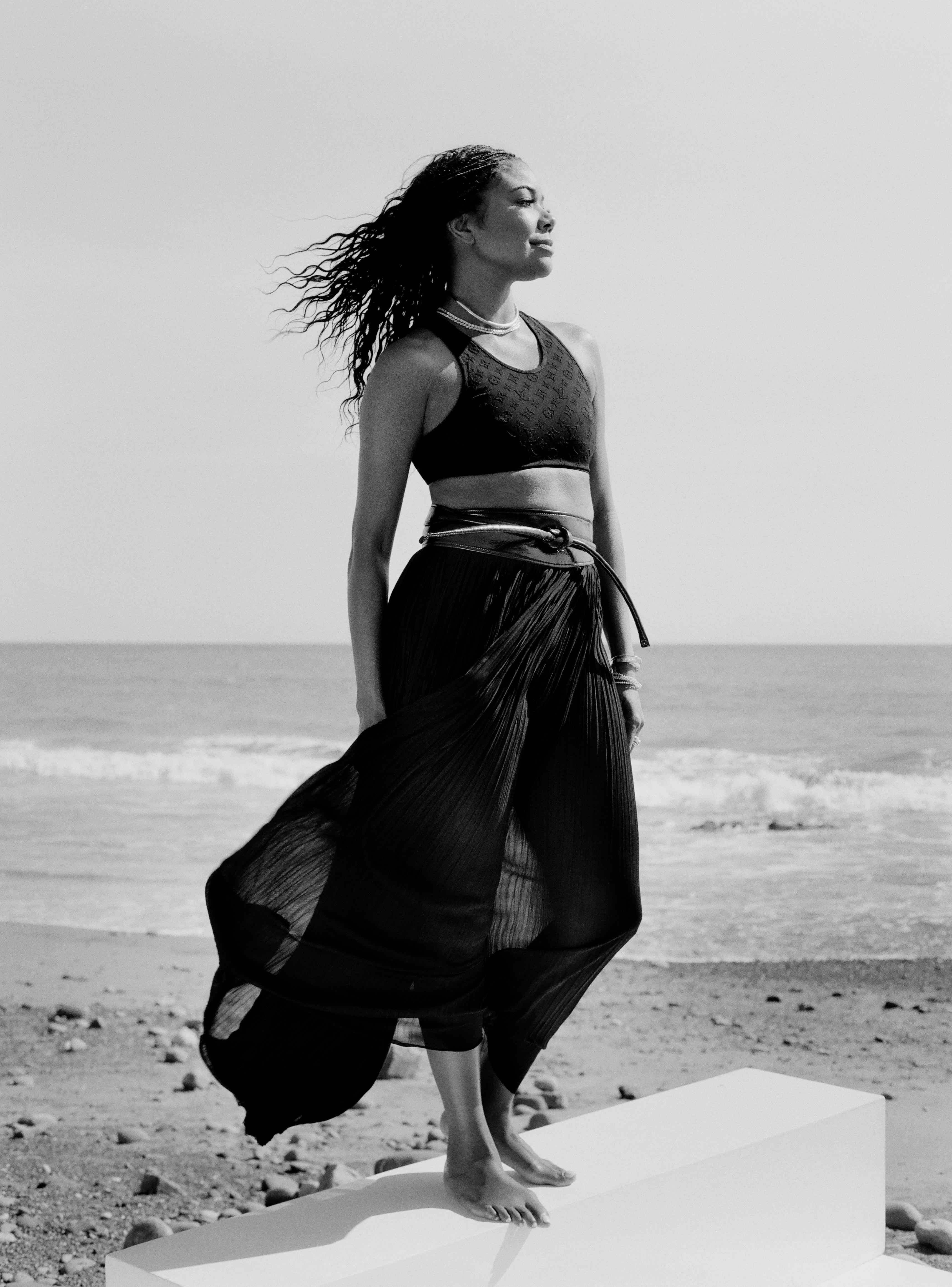 Skeie's Jewelers necklace, Anita Ko necklaces, Anita Ko bracelet, Skeie's Jewelers bracelet, Eriness bracelet, Louis Vuitton top and skirt.
Skeie's Jewelers necklace, Anita Ko necklaces, Anita Ko bracelet, Skeie's Jewelers bracelet, Eriness bracelet, Louis Vuitton top and skirt.
even close. I would love to see there be more alignment with who audiences really want to see, and who gets opportunities. Versus the people who are company folks, company men, as they used to say. But I'd like to make that gender-neutral.
Budgets, marketing budgets. Equity. Just more equity. Di erent kinds of people in charge of green lighting, running studios, head of marketing divisions across every studio network. Obviously, writers: pay them. Coming up with new financial models that match technology. And to keep that fluid as we keep the door open for changing ways of presenting content—the pay structures, the power structure, all of the things that come from that need to also be constantly changing. Allowing writers to produce their own episodes. Doesn't sound like a biggie. It is like pulling teeth.
Pay equity, opportunity equity, a real shakeup of who's in charge and who's running things… For people to truly see real diversity and inclusion as the asset that it is. If you want global dollars, then in front of and behind the camera needs to be reflective of those global dollars. Otherwise, you're going to miss it. There's whole studios where they refuse to adjust their marketing because they know it all. It's algorithm, but it's like “you know AI is racist. So if you're still wondering why you haven't been able to launch not one project of color into being super culturally relevant, maybe look within.”
You have to address, what if the algorithm is broken? It was inputted by humans. Humans are imperfect. All of our biases and judgments go into the work. Just being open to another way of doing things… There's a lot of ways to get to the finish line. Let's embrace some of the other ones.

OND: What are some proverbial gems you hope to pass along to your daughters?
GU: I want them to be free. I want them to be free to be painfully average if they want. I want them to be free to be whoever it is they want to be. And to speak truth to power, to use their full voice, whatever that sounds like, without having to constantly be managing their tone and inflection, and being aware that their presence is consistently policed and demonized. I want to know who they could be without that. And so we try to create as much of a space, environment, world—for our girls and everybody else's—to live free. I used to say, "Oh, I want her to have a horse." But there's so much that money cannot buy that is impacted by how we deal with race and anti-blackness in this country.
My hope for Kaavia and Zaya is that they're free of that—free of the insidious racism that permeates every element of their daily lives. I want to know what it is to be free of that. If I have money, fame, influence, power and I don't experience that, my hope can only be for the next generation. ♦
78 | THE EDIT 2023
Tabayer rings, William Goldberg necklace, Versace coat. Photographer, Shaniqwa Jarvis; Stylist, Thomas Christos Kikis; Hair, Larry Sims; Makeup, Fiona Stiles; Manicurist, Thuy Nguyen; Bookings Editor, Glynis Costin; Creative Production, Petty Cash Production; Photo Assistants, Keith Kleiner, Peter Baker, Irene Tang; Set Design, Winston Studios; Fashion Assistant, Sydney Engelhart.
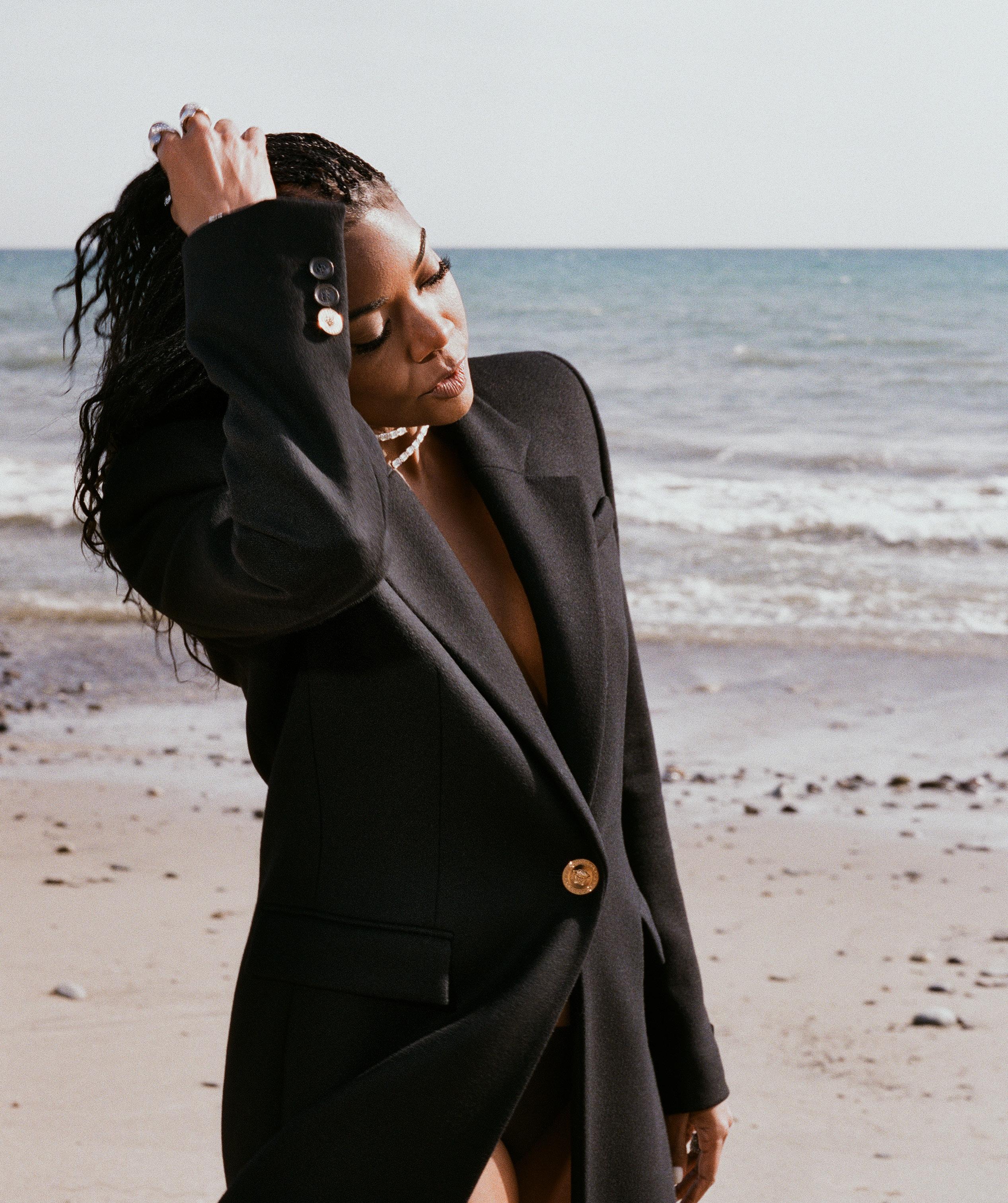
akimbo
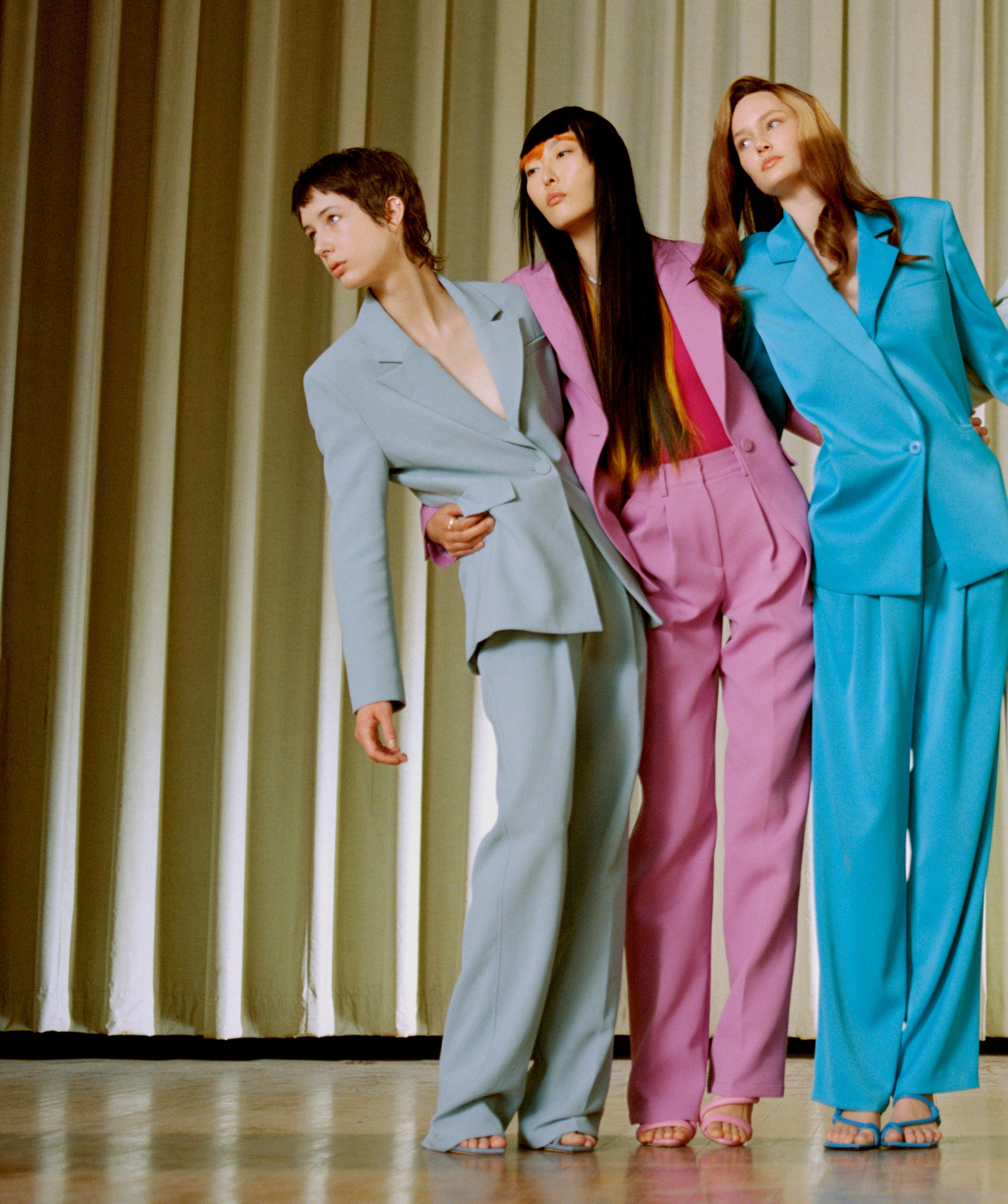 From left to right: Katie wears Stephanie Gottlieb earrings, Aknvas suit from Nordstrom, Jimmy Choo shoes. Hey Yeon wears Lorraine West ring, Arielle Ratner necklace, Aknvas suit from Nordstrom, Jean Paul Gaultier tank top from Albright Fashion Library, Alexandre Birman shoes.
Astrid wears The Clear Cut ring, Alice & Olivia suit from Nordstrom, Reike Nen shoes. Daniil wears Retrouvai necklace, KatKim ring, Officine Generale suit, Alexander McQueen shoes. Coco wears Arielle Ratner ring, Christopher John Rogers suit from Albright Fashion Library, Reike Nen shoes. Sonia wears Lorraine West ring, Kwiat necklace, Michael Kors suit.
From left to right: Katie wears Stephanie Gottlieb earrings, Aknvas suit from Nordstrom, Jimmy Choo shoes. Hey Yeon wears Lorraine West ring, Arielle Ratner necklace, Aknvas suit from Nordstrom, Jean Paul Gaultier tank top from Albright Fashion Library, Alexandre Birman shoes.
Astrid wears The Clear Cut ring, Alice & Olivia suit from Nordstrom, Reike Nen shoes. Daniil wears Retrouvai necklace, KatKim ring, Officine Generale suit, Alexander McQueen shoes. Coco wears Arielle Ratner ring, Christopher John Rogers suit from Albright Fashion Library, Reike Nen shoes. Sonia wears Lorraine West ring, Kwiat necklace, Michael Kors suit.
Nothing could be more fresh than being a little offbeat in an akimbo diamond ring
Photographed by MARK LIM

À
go-go
 From left to right: Sonia wears Stephanie Gottlieb ring, Anita Ko ring, Oliver Blandi ring, Area dress. Opposite page: Katie wears Oliver Blandi ring. Astrid wears Natasha Schweitzer ring, Lorraine West ring, Jade Trau bracelet. Hey Yeon wears Kwiat ring. Catsuits by Richard Quinn from Albright Fashion Library.
From left to right: Sonia wears Stephanie Gottlieb ring, Anita Ko ring, Oliver Blandi ring, Area dress. Opposite page: Katie wears Oliver Blandi ring. Astrid wears Natasha Schweitzer ring, Lorraine West ring, Jade Trau bracelet. Hey Yeon wears Kwiat ring. Catsuits by Richard Quinn from Albright Fashion Library.

 From left to right: Sonia wears Sorellina bracelet, William Goldberg ring, Mother of All dress. Coco wears Greenwich St. Jewelers ring, Stephanie Gottlieb ring, SVNR top and skirt. Daniil wears Sylva & Cie ring, Bite Studios top, Sally LaPointe pants. Katie wears William Goldberg ring, Araks dress. Astrid wears Jenna Blake ring, Stephanie Gottlieb bracelet, Mother of All dress. Hey Yeon wears Jade Trau ring, Reza ring, Forte Forte dress.
From left to right: Sonia wears Sorellina bracelet, William Goldberg ring, Mother of All dress. Coco wears Greenwich St. Jewelers ring, Stephanie Gottlieb ring, SVNR top and skirt. Daniil wears Sylva & Cie ring, Bite Studios top, Sally LaPointe pants. Katie wears William Goldberg ring, Araks dress. Astrid wears Jenna Blake ring, Stephanie Gottlieb bracelet, Mother of All dress. Hey Yeon wears Jade Trau ring, Reza ring, Forte Forte dress.

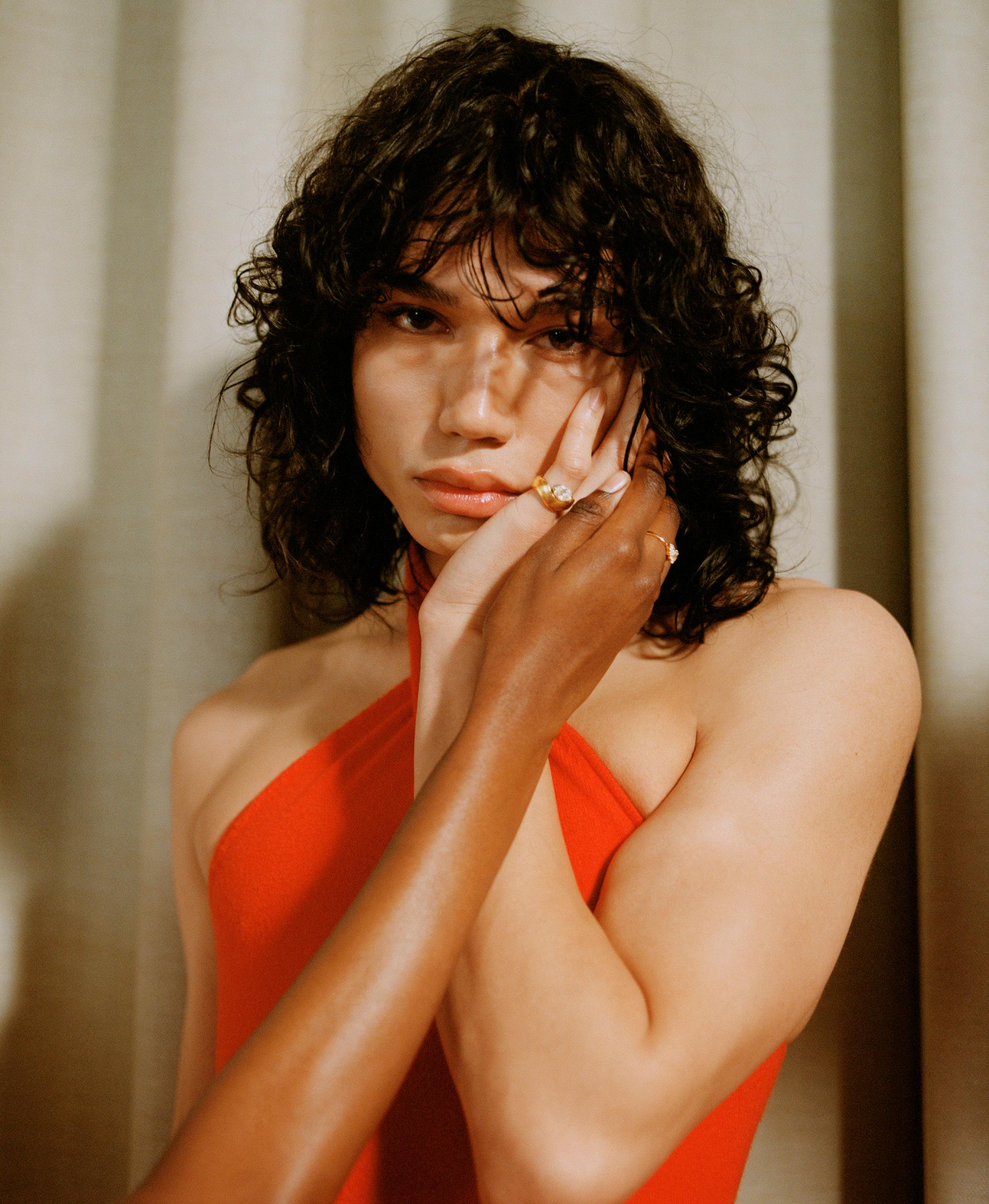
86 | THE EDIT 2023
 From left to right: Sonia wears Clear Cut ring, Clear Cut necklaces worn as belt, Acne Studios top and skirt from Nordstrom, Katy Perry shoes. Coco wears Belperron ring, Michael Kors bodysuit and pants. Daniil wears Ana Khouri ring, Ferragamo top, pants and shoes. Opposite page: Coco wears Belperron ring. Sonia wears Clear Cut ring.
From left to right: Sonia wears Clear Cut ring, Clear Cut necklaces worn as belt, Acne Studios top and skirt from Nordstrom, Katy Perry shoes. Coco wears Belperron ring, Michael Kors bodysuit and pants. Daniil wears Ana Khouri ring, Ferragamo top, pants and shoes. Opposite page: Coco wears Belperron ring. Sonia wears Clear Cut ring.
 From left to right: Astrid wears Jenna Blake ring, Stephanie Gottlieb bracelet, Mother of All dress. Hey Yeon wears Jade Trau ring, Reza ring, Forte Forte dress.
Katie wears William Goldberg ring, Araks dress.
Opposite page: Lorraine West ring, Clear Cut ring, Arielle Ratner ring, Lorraine West ring, KatKim ring.
From left to right: Astrid wears Jenna Blake ring, Stephanie Gottlieb bracelet, Mother of All dress. Hey Yeon wears Jade Trau ring, Reza ring, Forte Forte dress.
Katie wears William Goldberg ring, Araks dress.
Opposite page: Lorraine West ring, Clear Cut ring, Arielle Ratner ring, Lorraine West ring, KatKim ring.
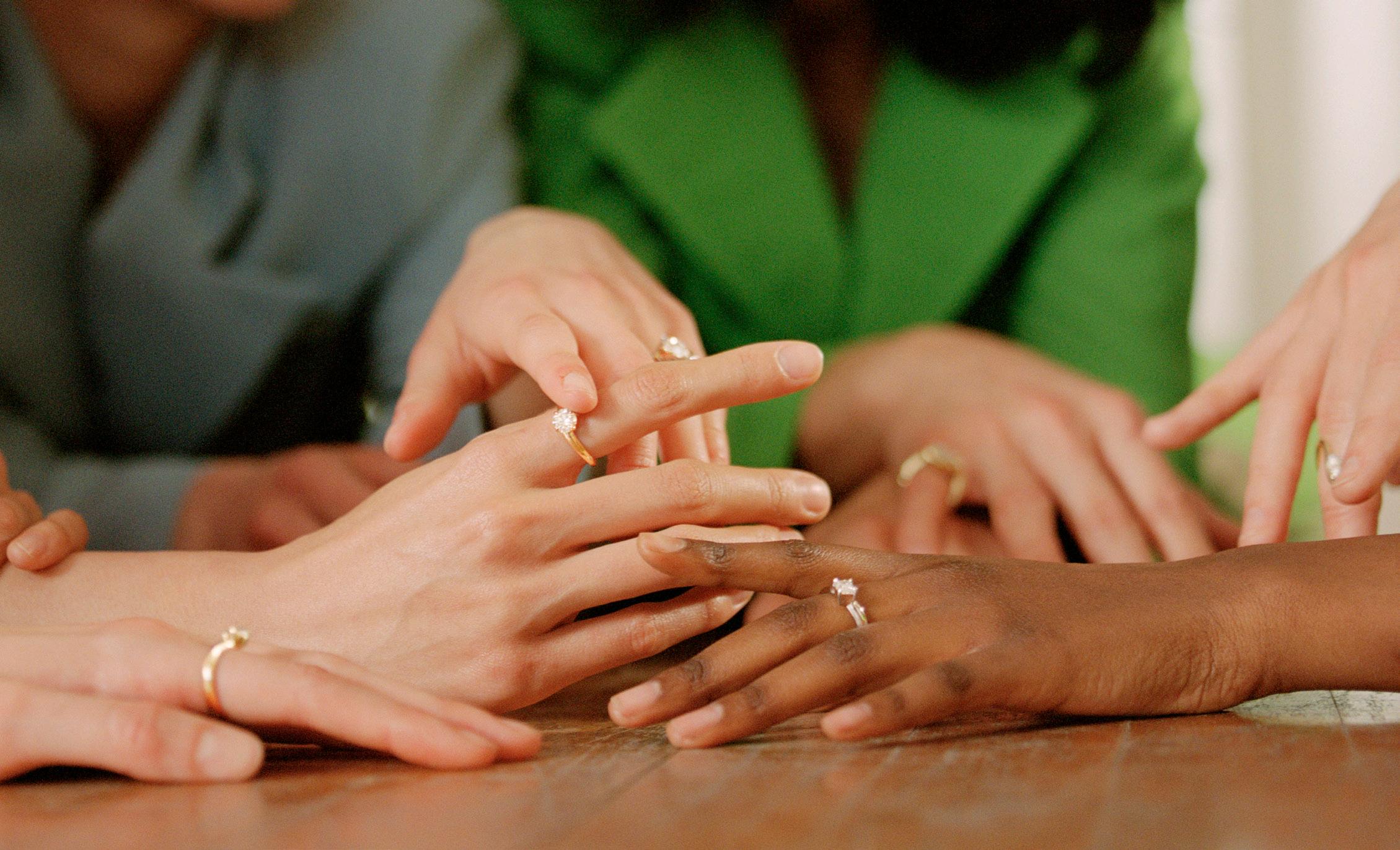

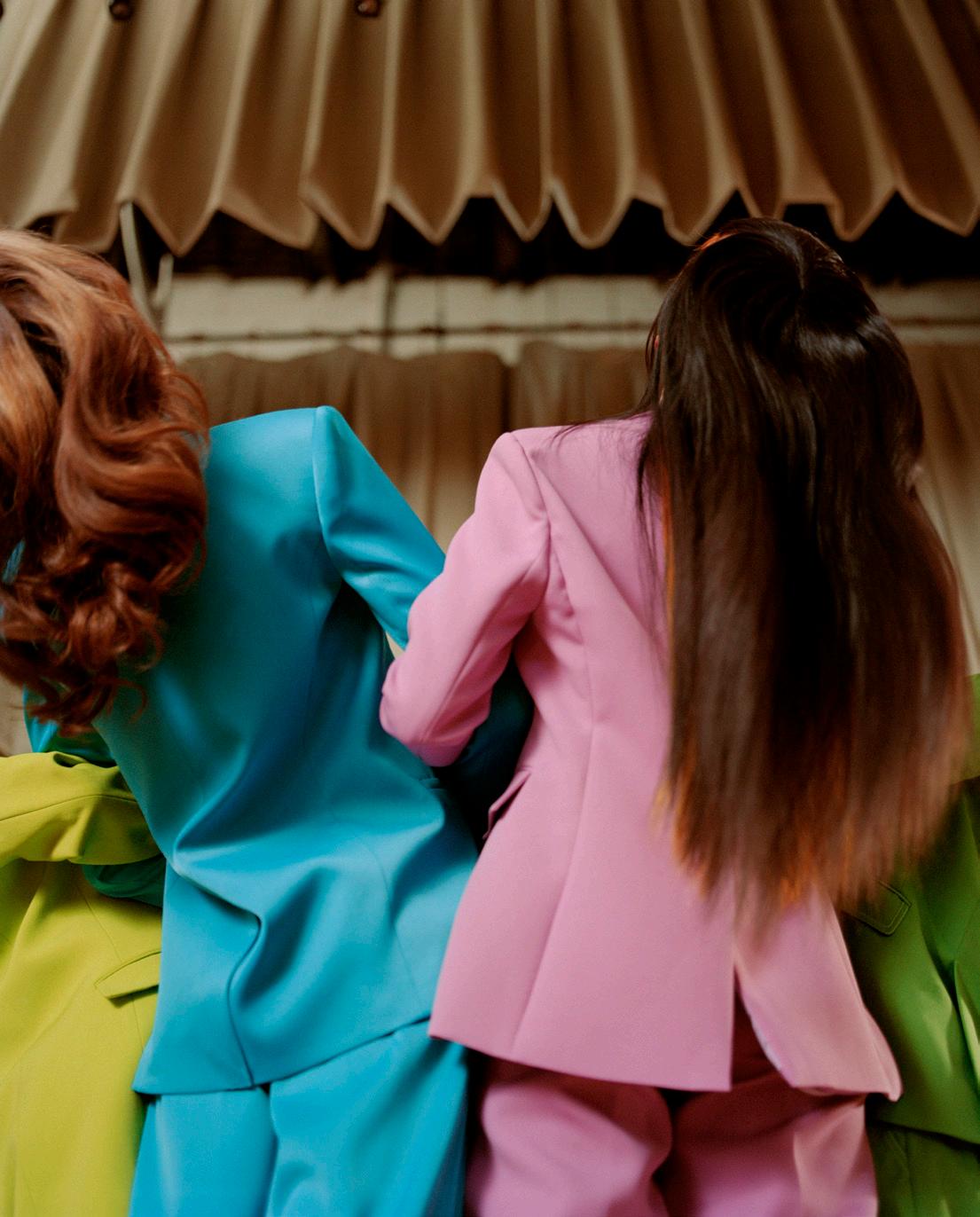
THE EDIT 2023 | 89
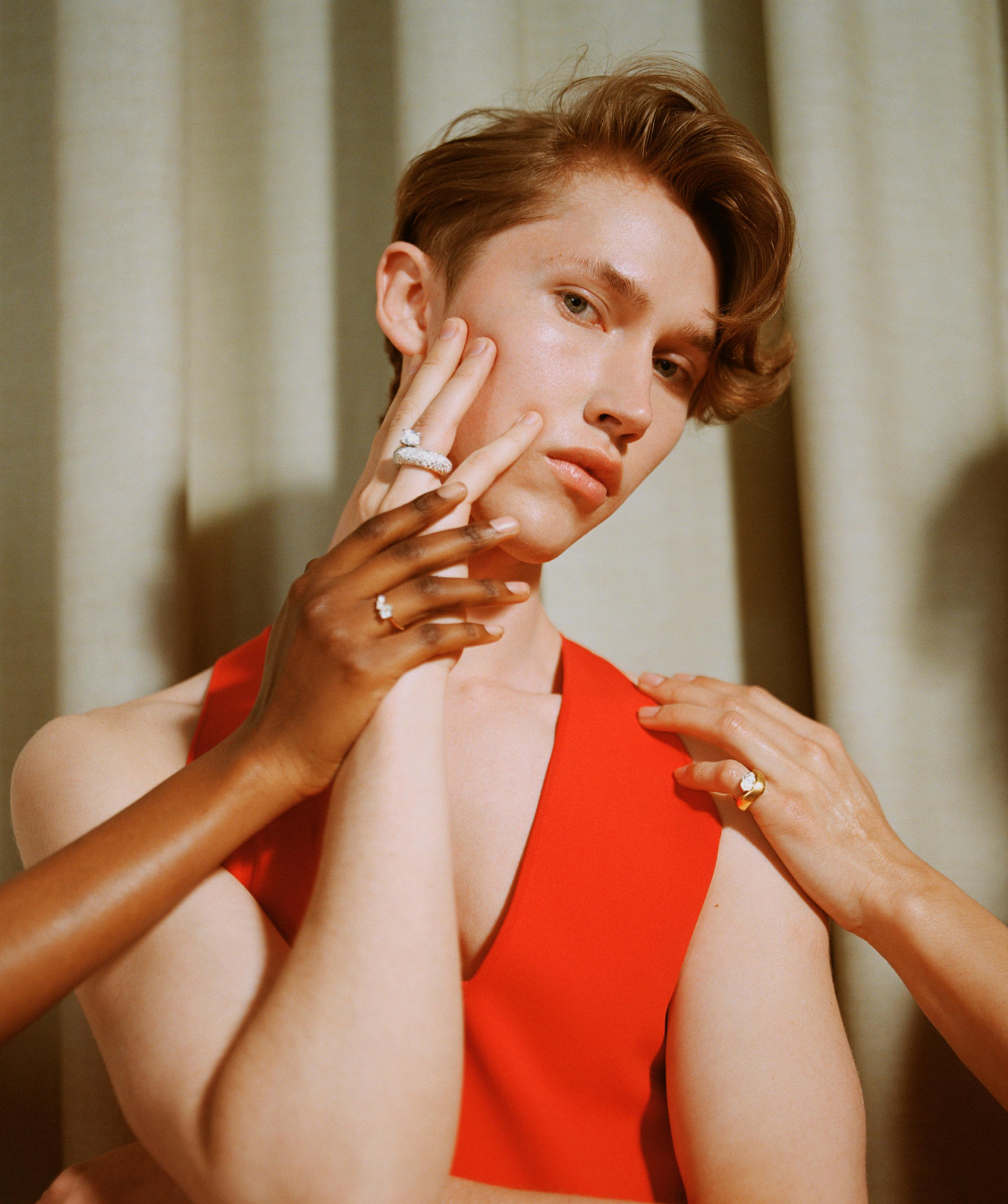 From left to right: Sonia wears Clear Cut ring. Daniil wears Ana Khouri ring. Coco wears Belperron ring. Opposite page: Hey Yeon wears Elizabeth Octavia ring, Arielle Ratner ring, Sorellina necklace, Interior top and skirt. Astrid wears Ana Khouri ring, Kwiat bracelet, Ferragamo dress.
From left to right: Sonia wears Clear Cut ring. Daniil wears Ana Khouri ring. Coco wears Belperron ring. Opposite page: Hey Yeon wears Elizabeth Octavia ring, Arielle Ratner ring, Sorellina necklace, Interior top and skirt. Astrid wears Ana Khouri ring, Kwiat bracelet, Ferragamo dress.
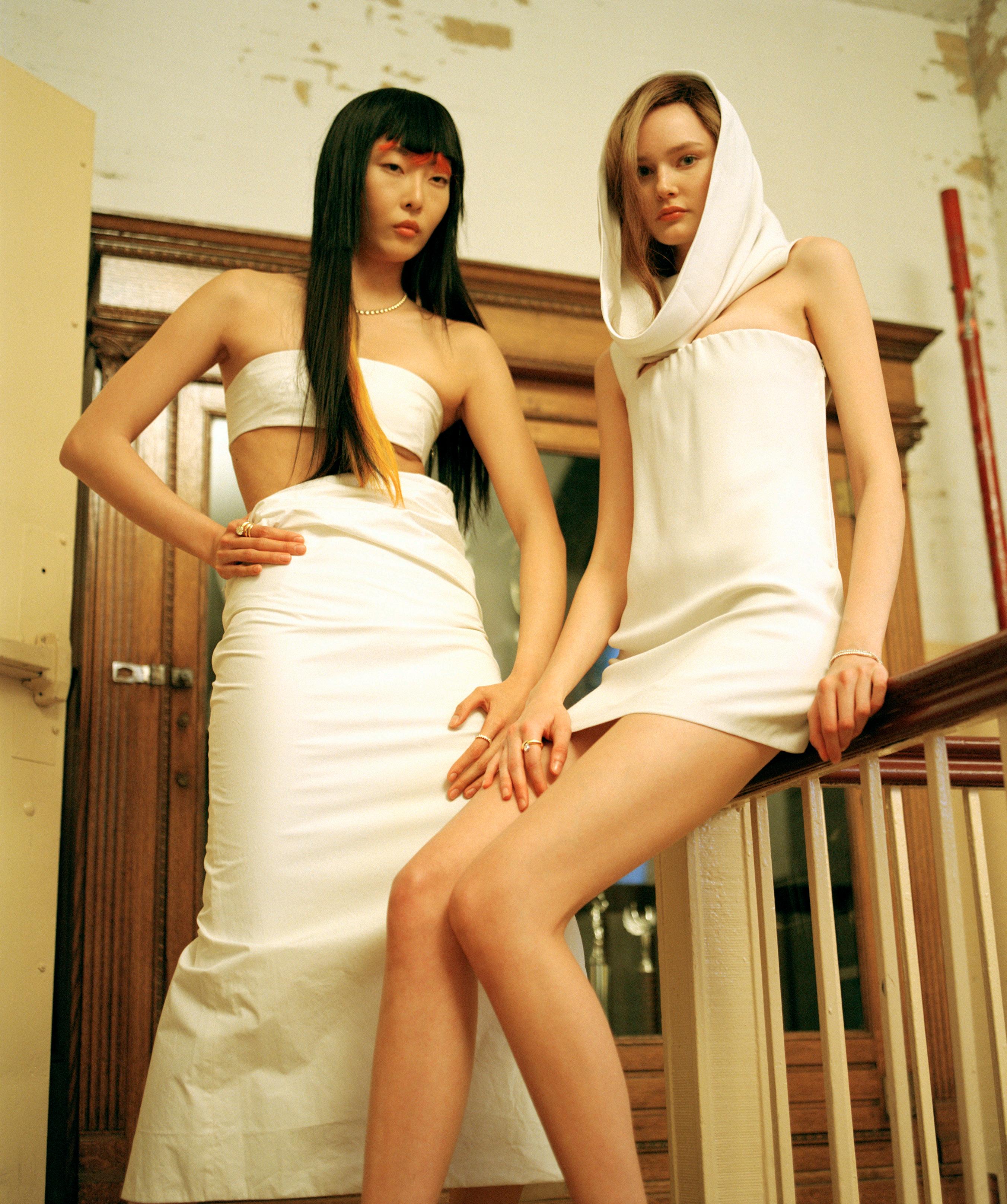
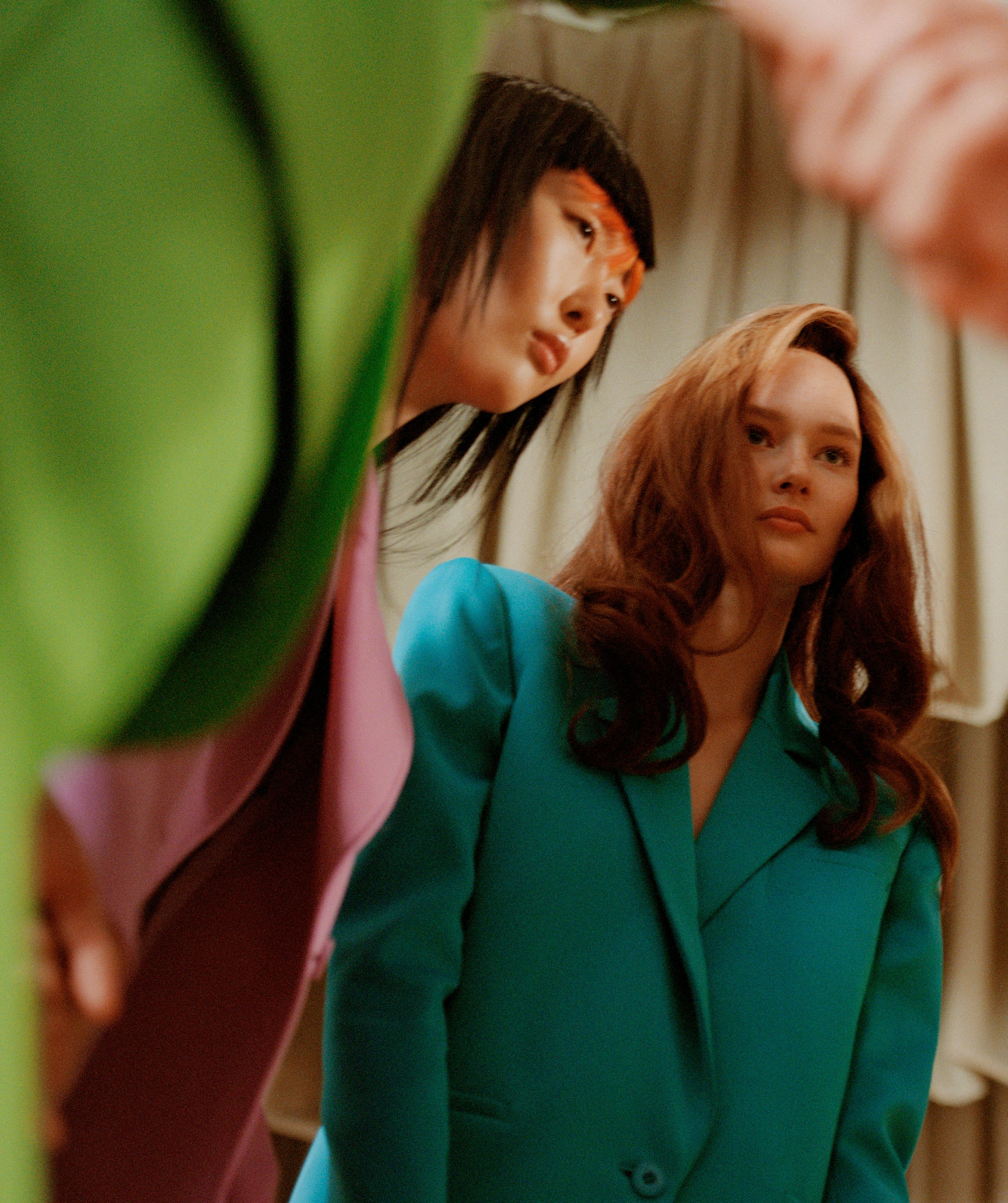 Sonia wears Kwiat necklace. Photographer, Mark Lim; Creative Director, Lizzy Oppenheimer; Stylist, Herin Choi; Hair, Edward Lampley; Makeup, Allie Smith; Manicurist, Mamie Onishi; Models, Astrid, Coco, Daniil, Hey Yeon Yoo, Katie Johnson, Sonia; Creative Production, Petty Cash Production; Photo Assistants, Hector de Jesus, Adam Kim, Mike Pardo; Digital Tech, Yu Hsing Lin; Fashion Assistants, Jasmine Fontaina, Sevn Rodriguez.
Sonia wears Kwiat necklace. Photographer, Mark Lim; Creative Director, Lizzy Oppenheimer; Stylist, Herin Choi; Hair, Edward Lampley; Makeup, Allie Smith; Manicurist, Mamie Onishi; Models, Astrid, Coco, Daniil, Hey Yeon Yoo, Katie Johnson, Sonia; Creative Production, Petty Cash Production; Photo Assistants, Hector de Jesus, Adam Kim, Mike Pardo; Digital Tech, Yu Hsing Lin; Fashion Assistants, Jasmine Fontaina, Sevn Rodriguez.

Kiernan Shipka shows diamond essentials are anything but basic
Written by SARAH CRISTOBAL
Photographed by ALEXANDER SALADRIGAS
94 | THE EDIT 2023
SHE’S SO
 From left to right: Eva Fehren ring, Norman Silverman necklace, EF Collection earrings, Sylva & Cie ring, Briony Raymond bracelet, vintage Thierry Mugler top, Stella McCartney skirt.
From left to right: Eva Fehren ring, Norman Silverman necklace, EF Collection earrings, Sylva & Cie ring, Briony Raymond bracelet, vintage Thierry Mugler top, Stella McCartney skirt.
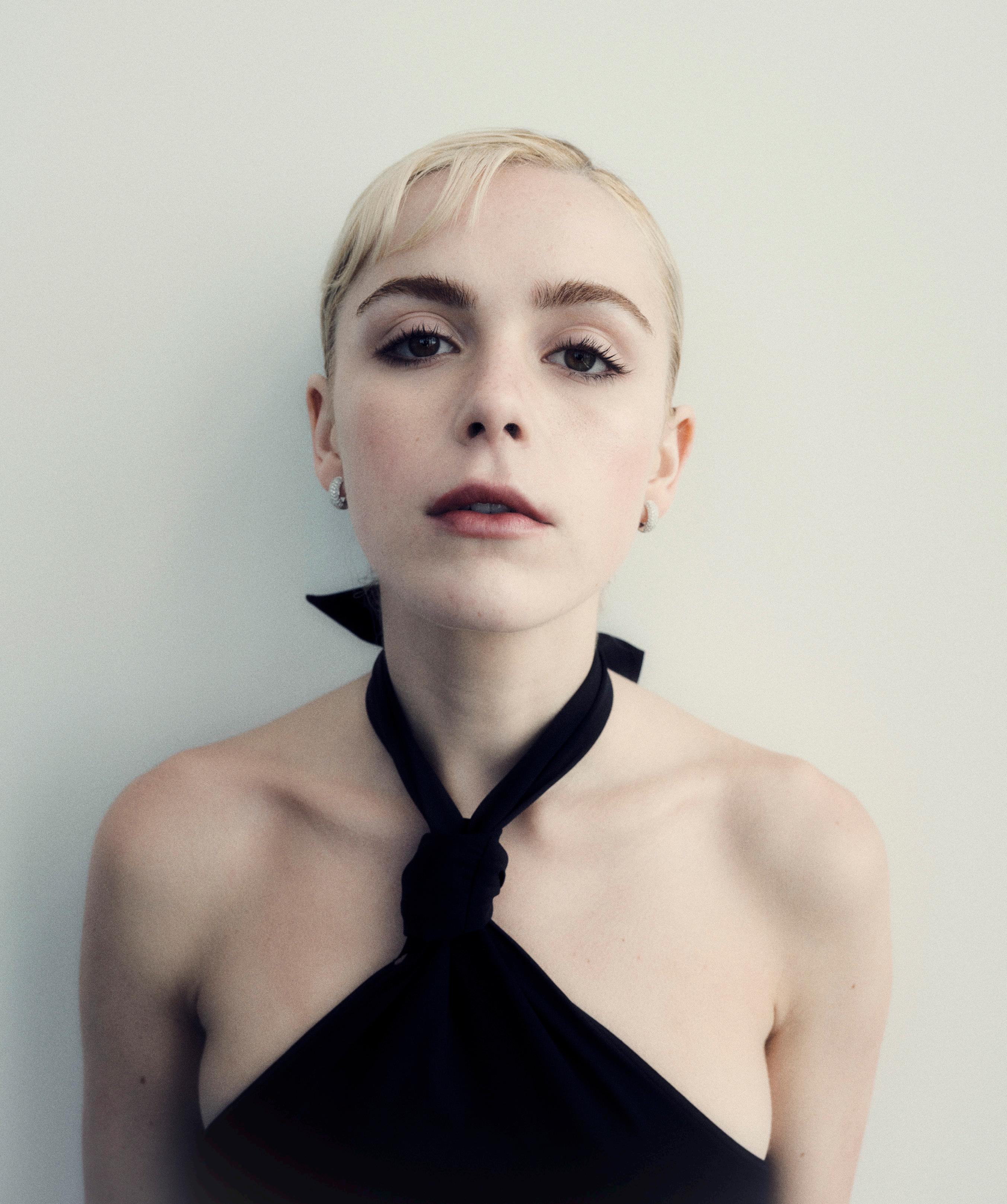

THE EDIT 2023 | 97
From left to right: EF collection earrings, Norman Silverman necklace. Opposite page: Lux Bond and Green earrings, Louis Vuitton bodysuit.
like capturing a moment,” says actress Kiernan Shipka of her relationship to photography. “I like taking photos of things that I want to remember.” Glamorous out f its loom large on the star’s well-traf f icked Instagram feed and showcase her innate ability to have fun with fashion. In recent posts—from the New York premiere of her latest show, HBO’s White House Plumbers, and her “Disco Barbie” themed birthday party—she’s favored spangly Oscar de la Renta minidresses. Choice accessories have included natural diamond pieces from either her personal collection or baubles from Irene Neuwirth. At 23, Shipka has a certain ownership of her style that a lot of other talents her age don’t have. But then again, when you’ve been gracing red carpets since the age of seven, you certainly pick up a trick or two. You’re already an industry vet even though you’re in your early twenties.
It’s funny, right? I remember taking photos with January Jones at the f irst Mad Men premiere [in 2007]. When we were together, it felt like the camera flashes tripled. She had to guide me, “You start on the left, and then you go to the right.” And honestly, every single time I get on a red carpet, I think about that. It’s like, “Oh my God, that was so wild to be doing that at such a young age.” But I got accustomed to it and then life happens and it can feel weird again, and then it feels good again.
What would you wear for those early red-carpet appearances?
When I was really young, I would wear Oscar de la Renta Kids to events. Now being able to wear Oscar Oscar is really nice. Grown up Oscar! Was it overwhelming to attend fashion shows during your teenage years, with all of the attention that would bring?
I didn’t overthink things then, and I wasn’t super online. There wasn’t an added feeling of pressure. For the most part, I look back on those fashion moments really fondly, because I wasn’t deathly worried about how they were going to turn out. That was when I was 10 years into [my career] though, which is so weird.
You mentioned that you like looking at fashion references before a big event, so you know the vibe and what you’re getting into.
Oh yeah. I mean, when it comes to red carpets and all that kind of stu I’ve got to have a plan. If there’s one thing about me, I love a plan. I love a list. I love an answer. All that. And do you love diamonds, Kiernan? Don’t hold out on us.
I have a necklace with a diamond pendant that my mother gave me and I love it. I wear it quite often. This [Only Natural Diamonds] shoot was incredible, there was so much beautiful jewelry. And I feel lucky that I can be loaned beautiful pieces for red carpets and things. I am constantly praying to
98 | THE EDIT 2023
“I
 Eva Fehren earrings, vintage Versace top.
Eva Fehren earrings, vintage Versace top.
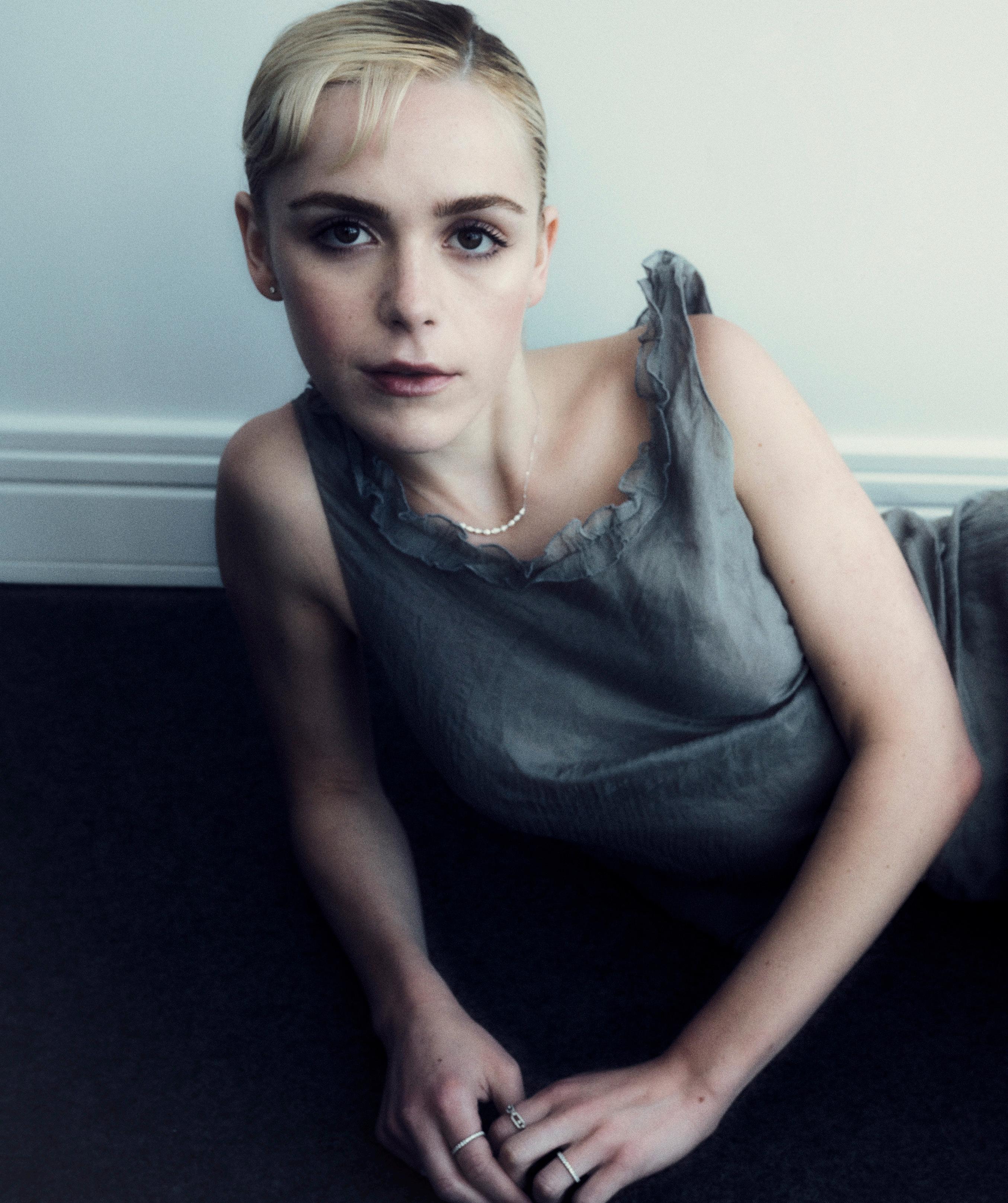
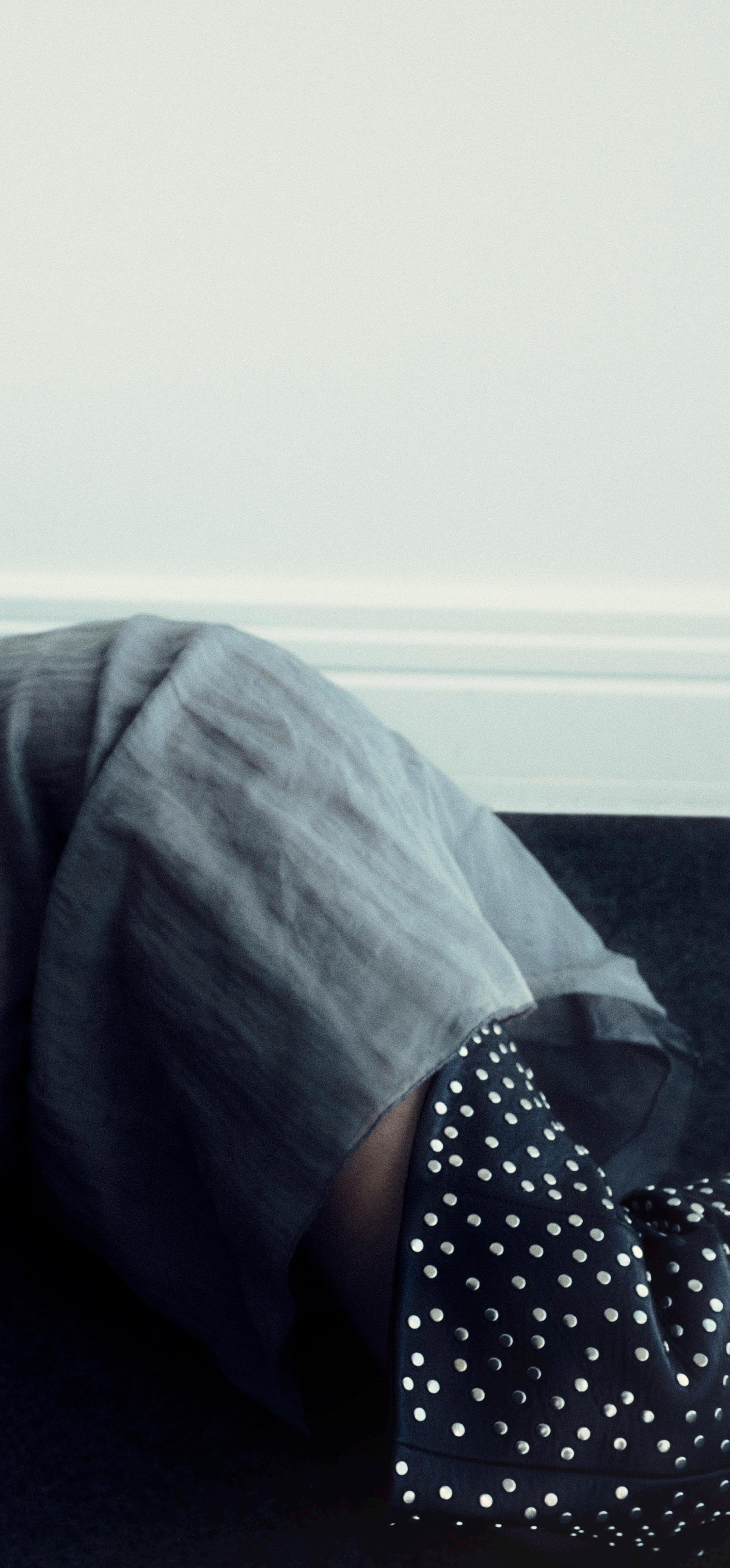
THE EDIT 2023 | 101
From left to right: Lauren Addison ring, Messika earrings, Lux Bond and Green necklace, Lauren Addsion ring, Messika ring, vintage Prada top and skirt, vintage boots.
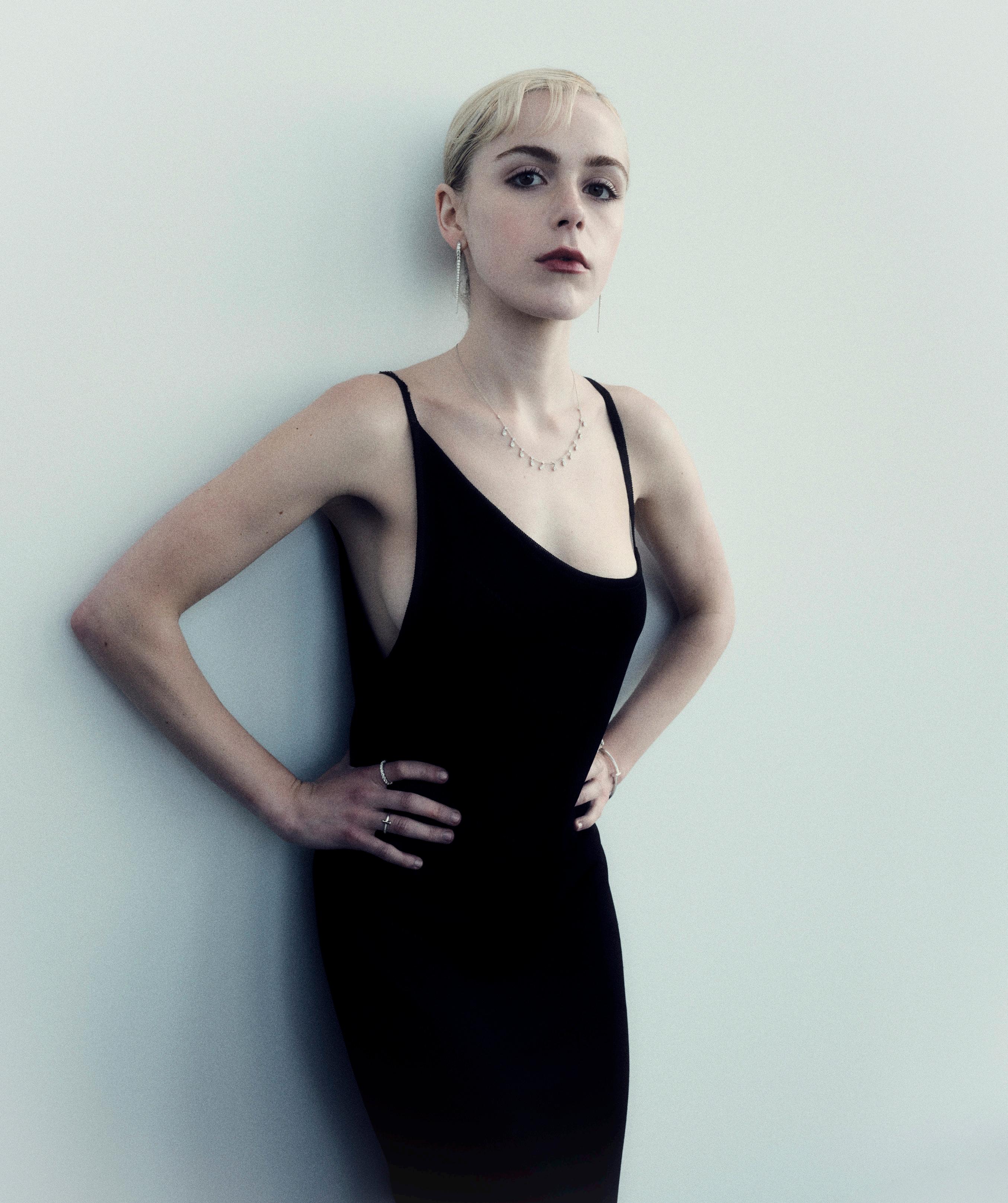
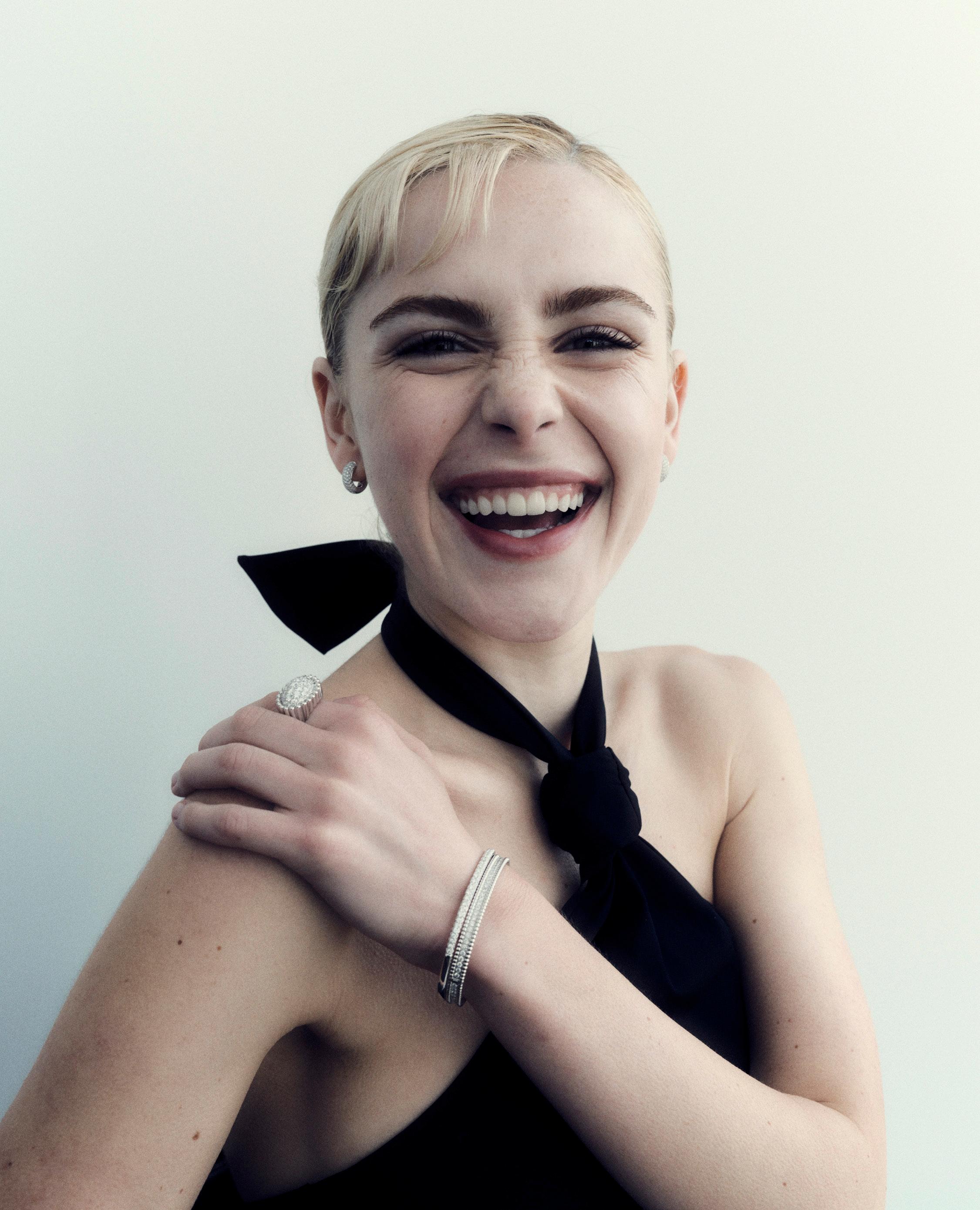
THE EDIT 2023 | 103
From left to right: Lux Bond and Green earrings, Van Cleef & Arpels ring, Lauren Addison bracelet, Van Cleef & Arpels bracelet. Opposite page: Tiffany & Co ring, Melissa Kaye ring (pointer), Melissa Kaye earrings, Greenwich St. Jewelers necklace, Tiffany & Co bracelet, Mckenzie Liataud ring, vintage Chloe dress.
God that whatever I’ve been loaned doesn’t fall o my ear, or my wrist.
Do you like to buy fine jewelry or do you aspire to have certain pieces in your collection?
I’m a FoundRae girl. I love, love, love FoundRae. Those necklaces [that I have purchased] mean a lot to me. There’s something quite beautiful about owning a signi f icant item and having it symbolize something in one’s life. It’s a reminder of who you are in some kind of way. I think that those types of pieces can be really special. And that’s the type of jewelry that is fun to pass down from generation to generation.
I think about a FoundRae ring that I have, and it’s like, “Oh, that would be so cool to give to my kid one day.”
And actually one of the few things I took from the Mad Men set was a necklace. It was Sally’s necklace that she wore for quite a bit of the show. That’s probably the most sentimental piece of jewelry that I own. It’s a little heart necklace that has Sally’s initials on it. Don [Draper, Jon Hamm’s character] got it for her. I love things that have meaning, and that you can keep, cherish, and pass along. Your new show is White House Plumbers about the Watergate scandal and you get to wear a lot of 1970s
vintage attire.
I love a vintage moment. I like to buy vintage that doesn’t necessarily feel or look super identi f iably vintage. But yeah with regards to White House Plumbers, my character [Kevan Hunt] has a golden child vibe, which was very interesting for me, because obviously that breaks, and there’s a real sort of arc in the way that she sees her father [played by Woody Harrelson]. To play someone who has it all together and is doing all the “right things” with her life, and then to have it crumble in the way that it did was very compelling to me. And also, just working with Woody was so so exciting. Occasionally you work on a show that everyone’s excited to make and is f illed with wonderful people that you can maybe, hopefully, call family after, and that is this show for me, for sure
I read that you are big on making playlists.
I do love a playlist. I like songs that remind me of certain times. I think it’s amazing, much like a jewel, or a relic of some sort.
Well done, circling back to natural diamonds, aka the jewel of music. Exactly! That’s what I was just about to say! [Laughs] ♦
104 | THE EDIT 2023
“one of the few things I took from the Mad Men set was a necklace. It was Sally's necklace that she wore for quite a bit of the show. That’s probably the most sentimental piece of jewelry that I own.”
From left to right: Melissa Kaye ring, Lauren Addison earring, Sylva & Cie necklace, Melissa Kaye earring, Grace Lee ring, vintage Gucci top, Helmut Lang pants. Photographer, Alexander Saladrigas; Stylist, Marissa Baklayan; Creative Director, Lizzy Oppenheimer; Hair, Edward Lampley; Makeup, Allie Smith; Manicurist, Mami Onishi; Bookings Editor, Glynis Costin; Creative Production, Petty Cash Production; Photo Assistants, Karen Gross, Colin Eliot; Digital Tech, Eliot Oppenheimer; Fashion Assistant, Kaia Carioli.
Shot on location at Sutton Tower, NYC
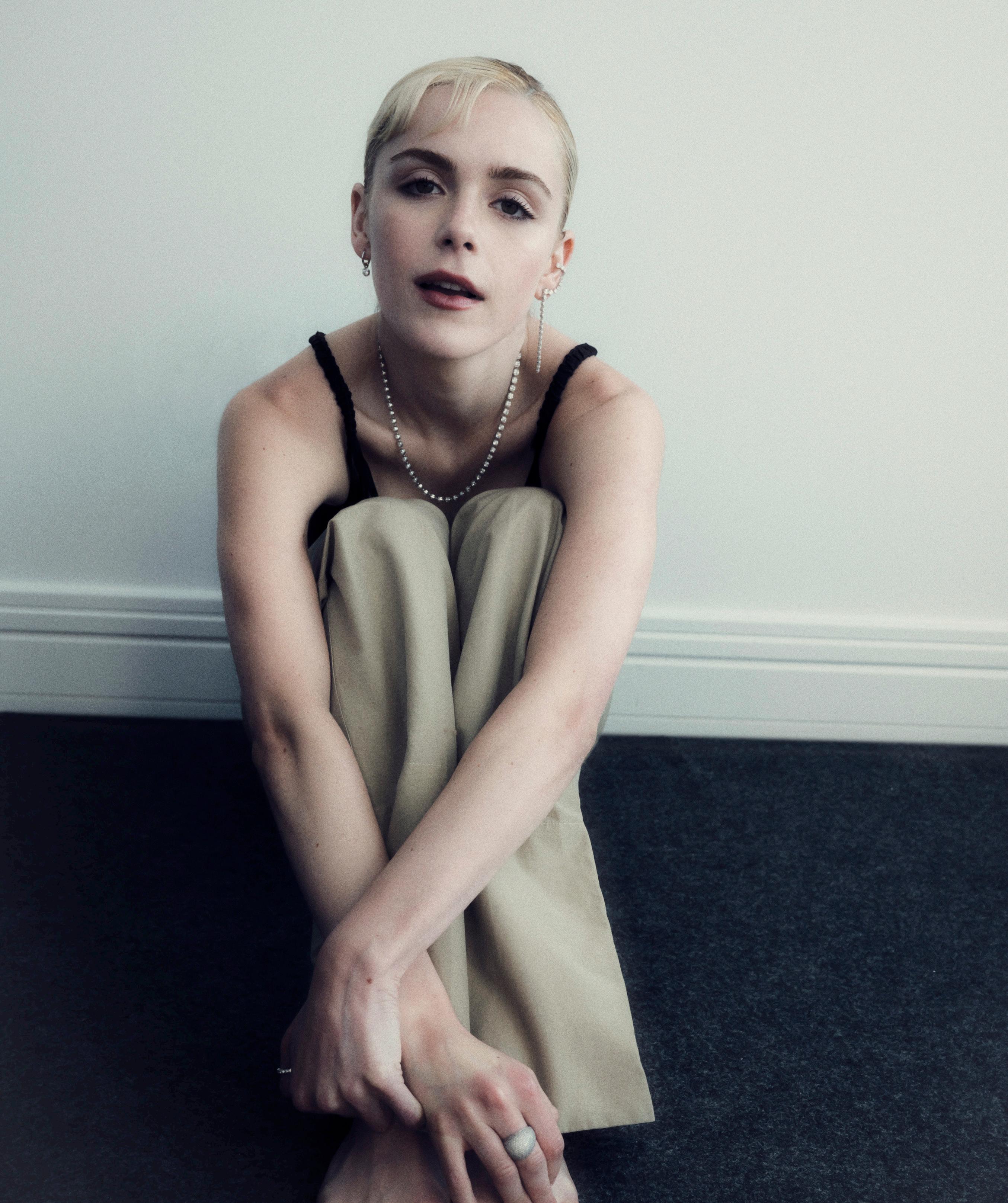
These
106 | THE EDIT 2023
are the BANGLES that you never never take off.
SKIN O O O O
Photographed by JENNIFER LIVINGSTON SECOND
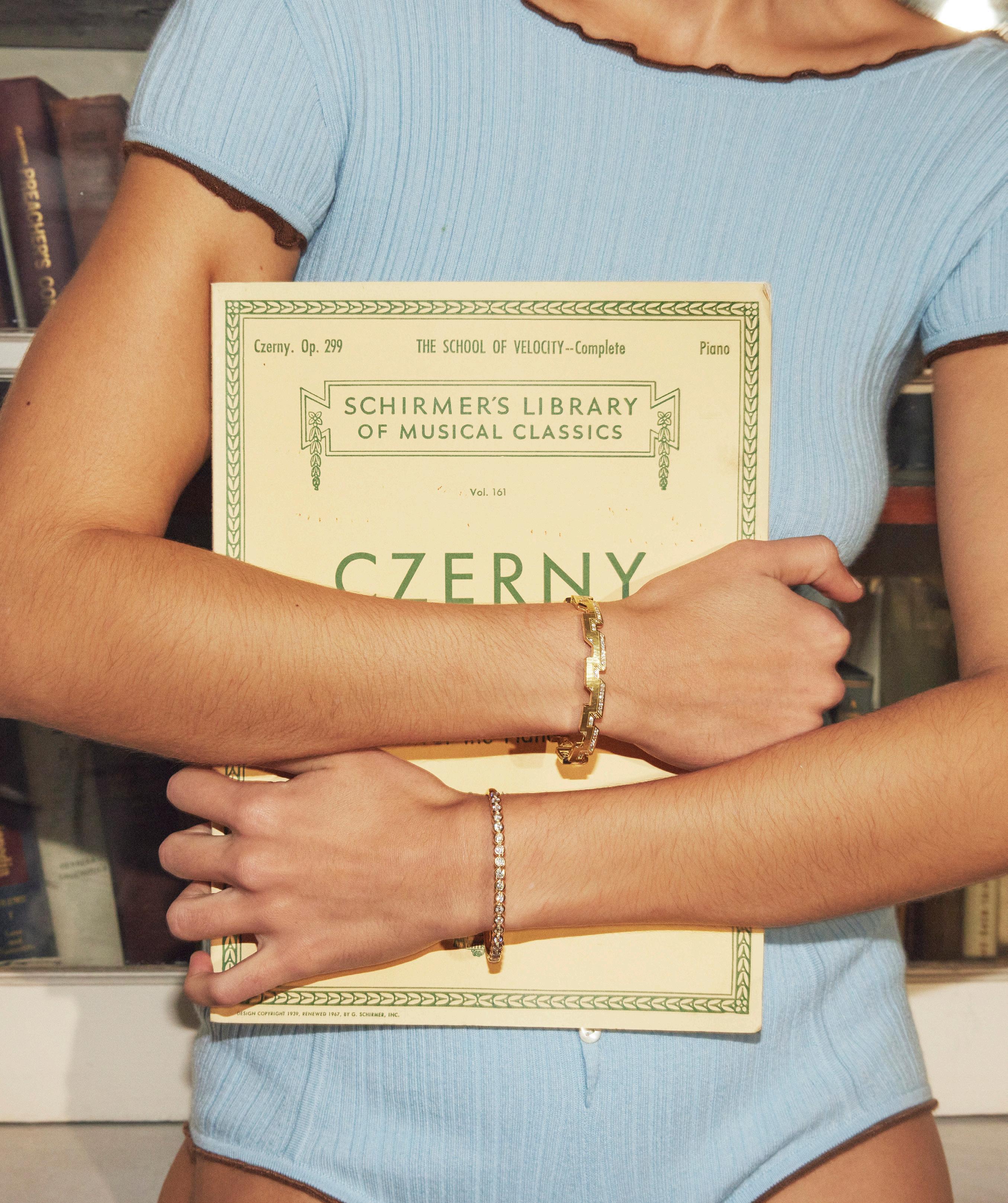 Fromt left to right: Briony Raymond bangle, Vendorafa bangle, Guest in Residence top and briefs.
Fromt left to right: Briony Raymond bangle, Vendorafa bangle, Guest in Residence top and briefs.

108 | THE EDIT 2023
From left to right: Gismondi bangle, Ippolita bangles, Philosophy di Lorenzo Serafini dress, Falke tights. Opposite page: David Yurman bangle, Melissa Kaye bangle, Victor Glemaud dress, CDLP top and briefs.
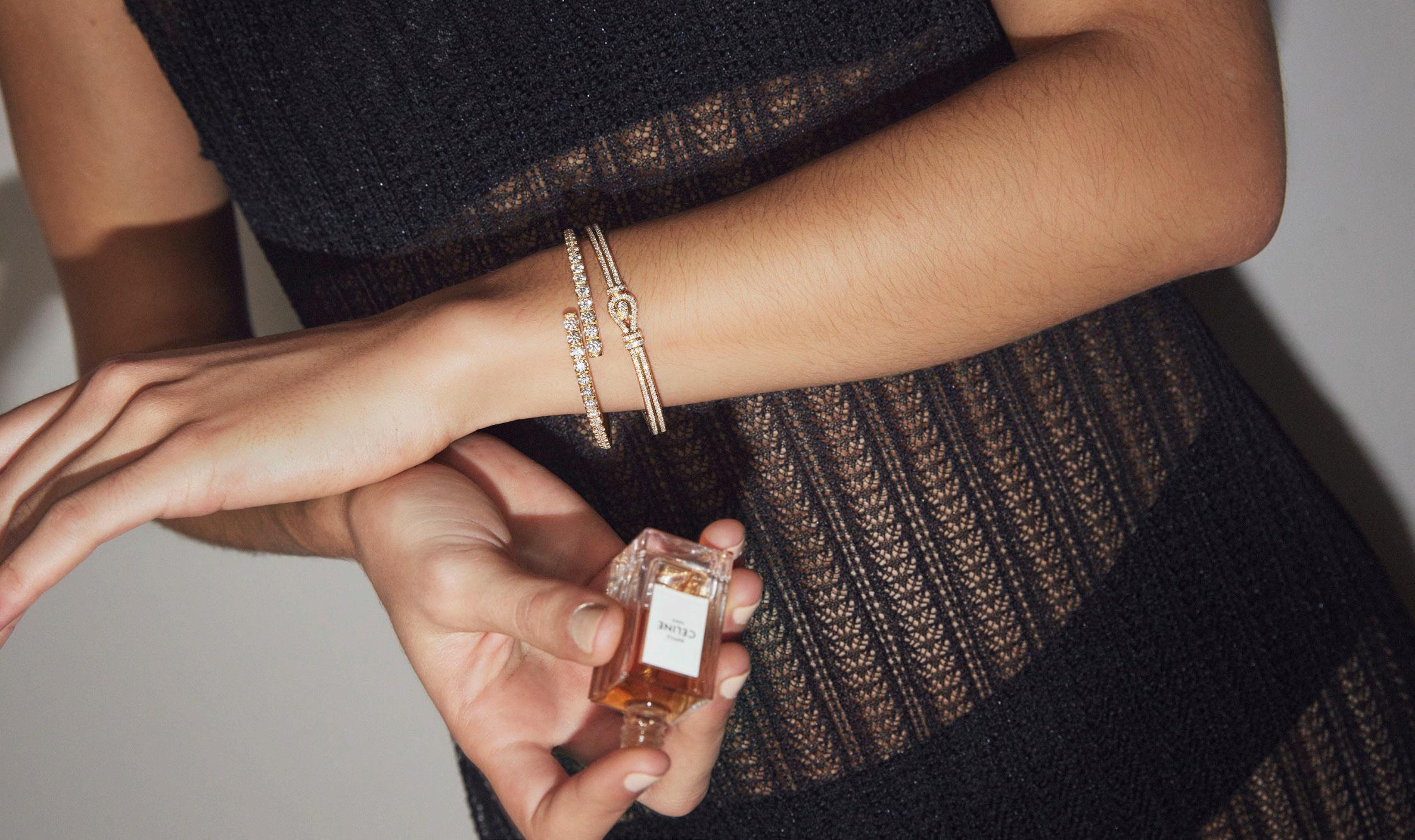

THE EDIT 2023 | 109


110 | THE EDIT 2023
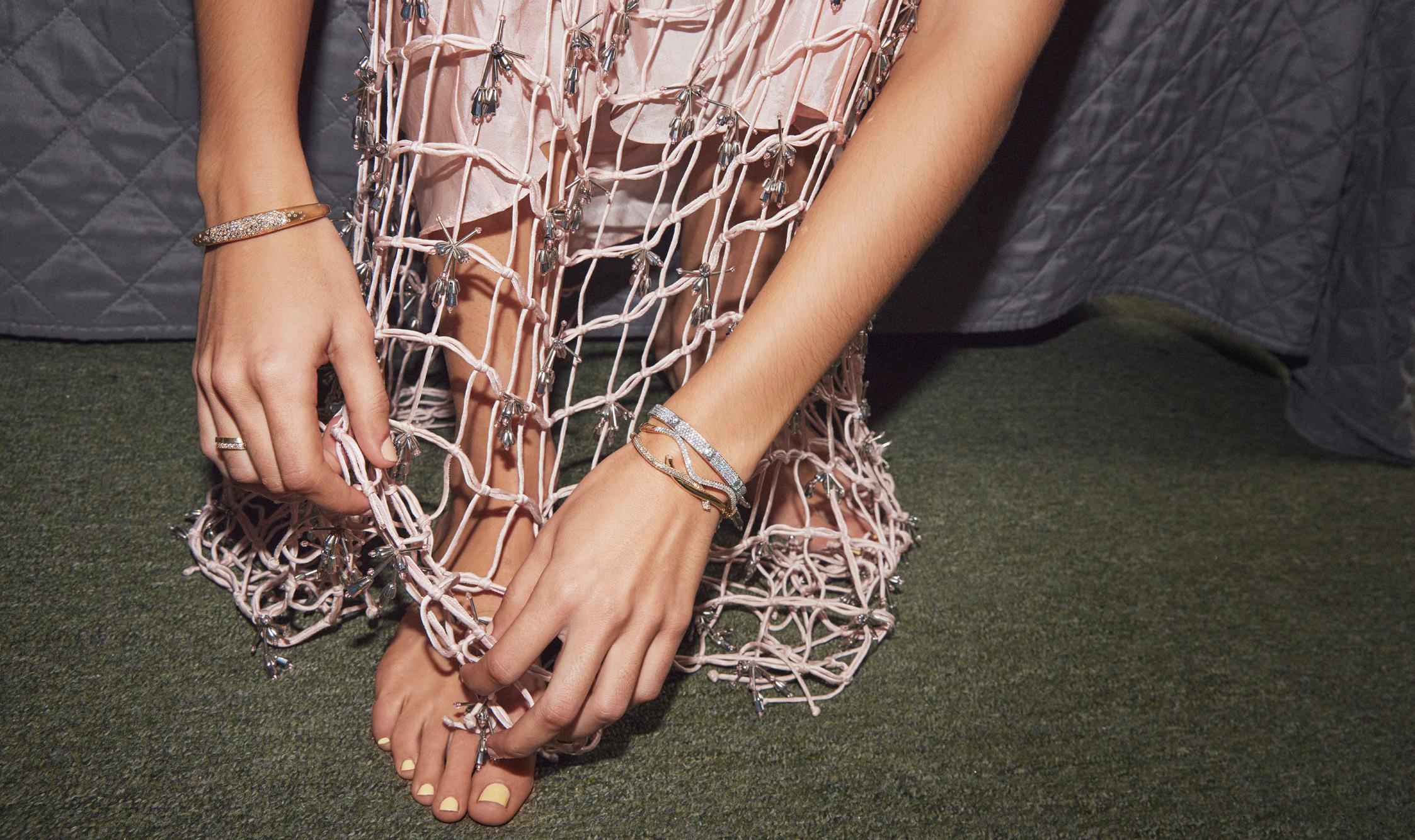

THE EDIT 2023 | 111
From left to right: Casey Perez ring, Nada Ghazal bangle, Anita Ko bangle, Mateo bangle, Boochier bangle, Lanvin dress.

112 | THE EDIT 2023

THE EDIT 2023 | 113
From left to right Cartier bangle, Eriness ring, 6397 shirt, Araks briefs, Wolford tights.
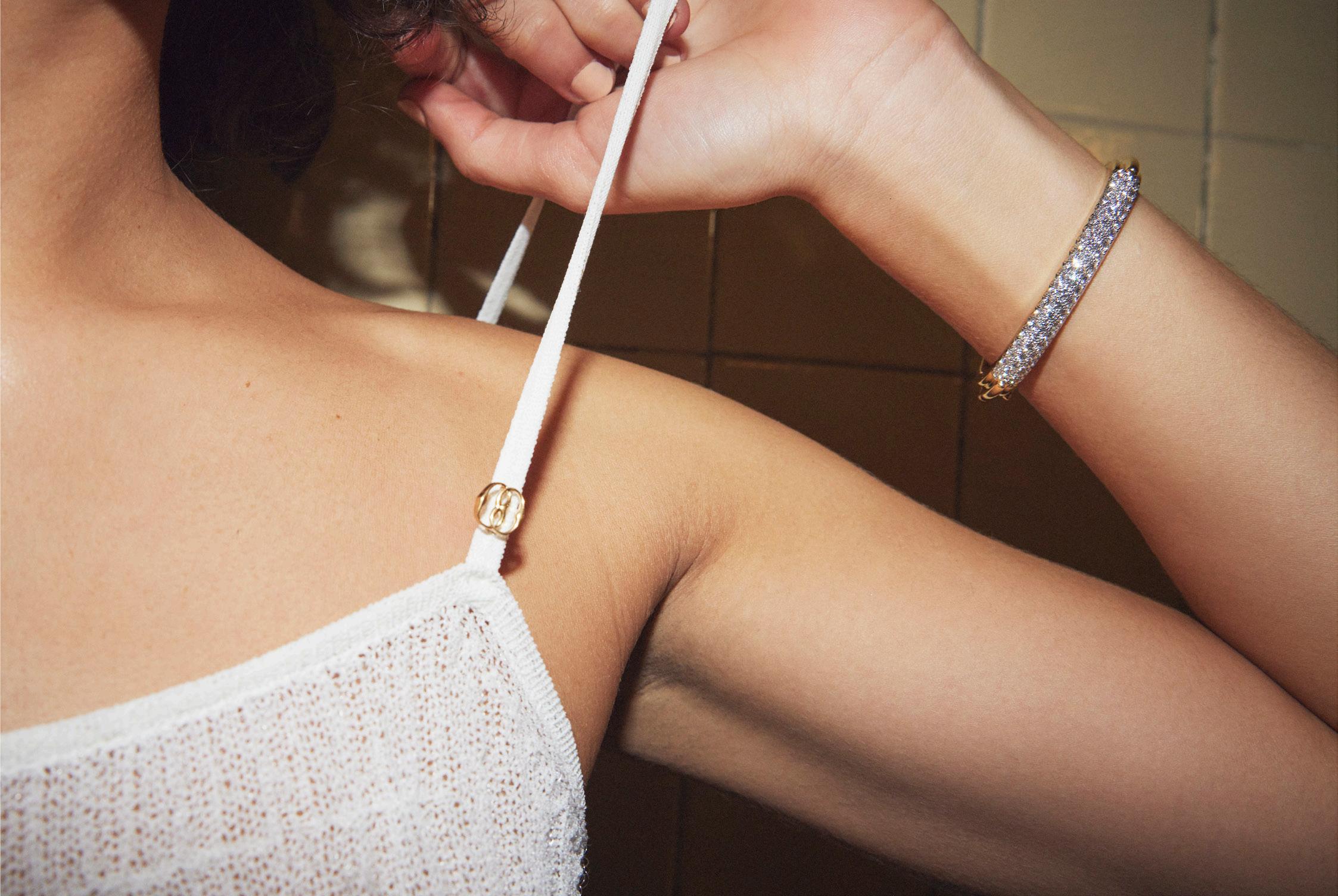
114 | THE EDIT 2023
David Webb bangle, Bally top. Opposite page from left to right: Dinh Van bangle, Jemma Wynne bangle, Retrouvai bangle, Akris dress, Embroidered artwork by Lisa Naftolin.
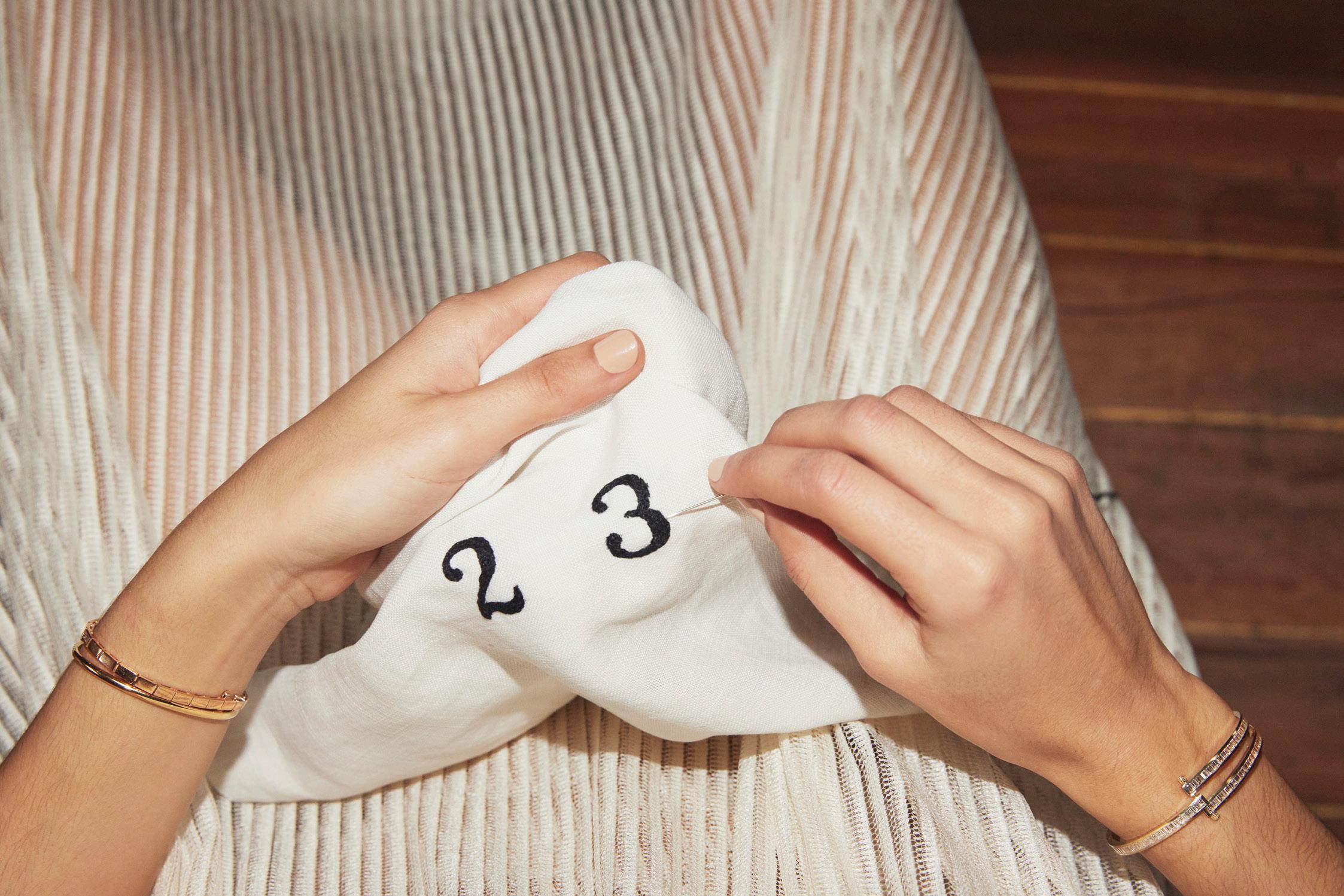
THE EDIT 2023 | 115
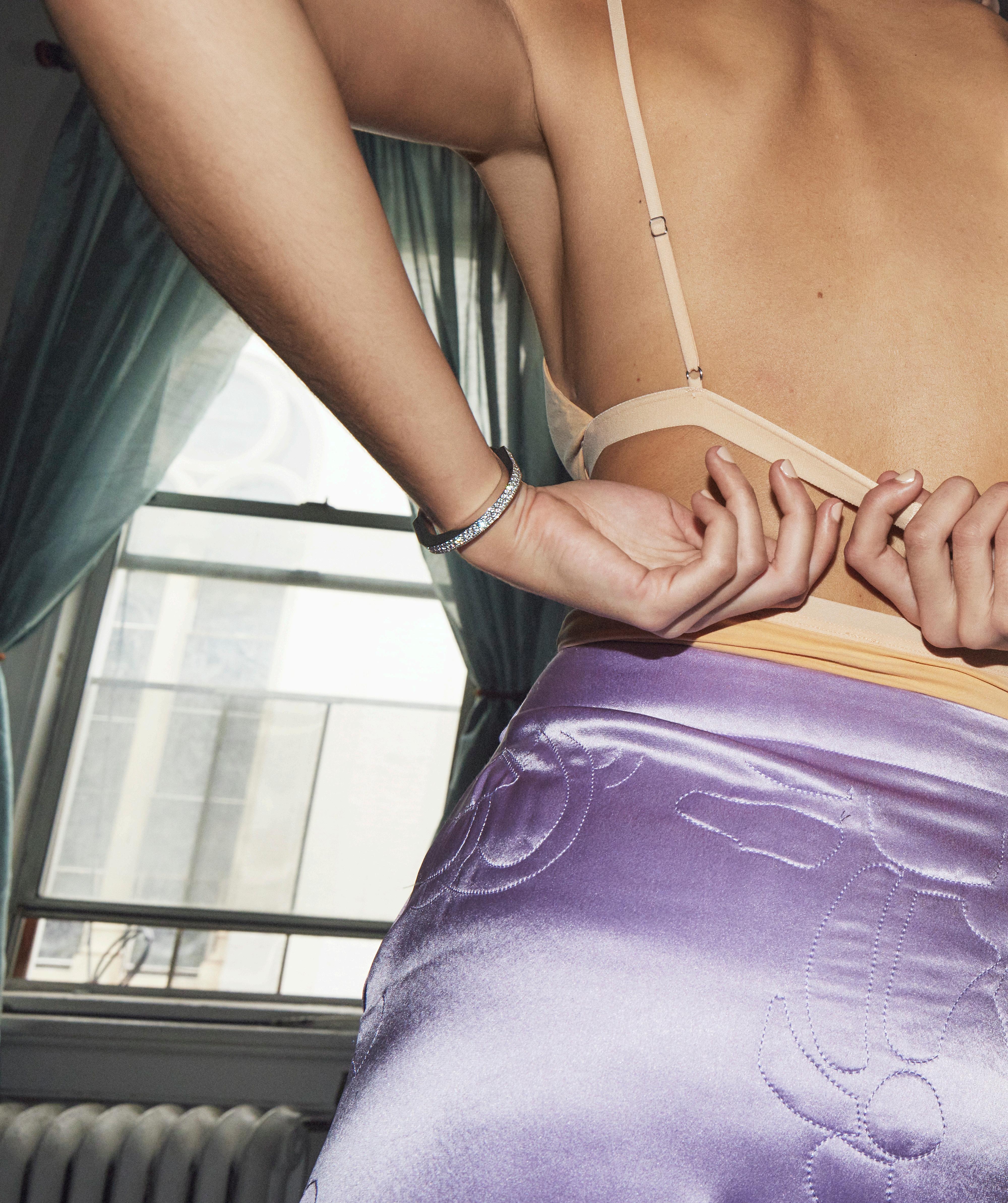
116 | THE EDIT 2023
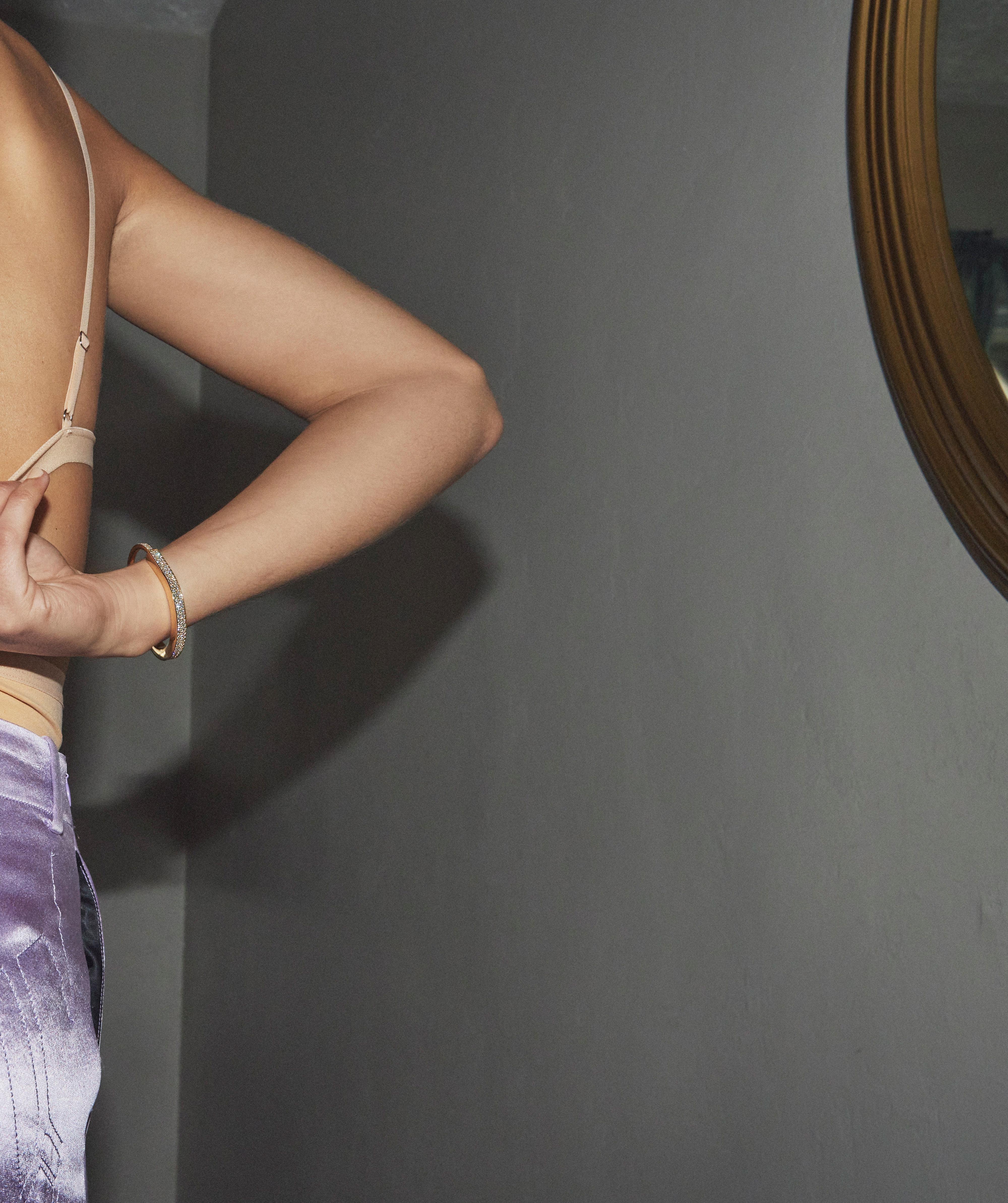 Tiffany & Co bangles, Baserange bralette and briefs, Social-Work skirt.
Tiffany & Co bangles, Baserange bralette and briefs, Social-Work skirt.

118 | THE EDIT 2023
Tiffany & Co bangles, Michael Kors shirt.
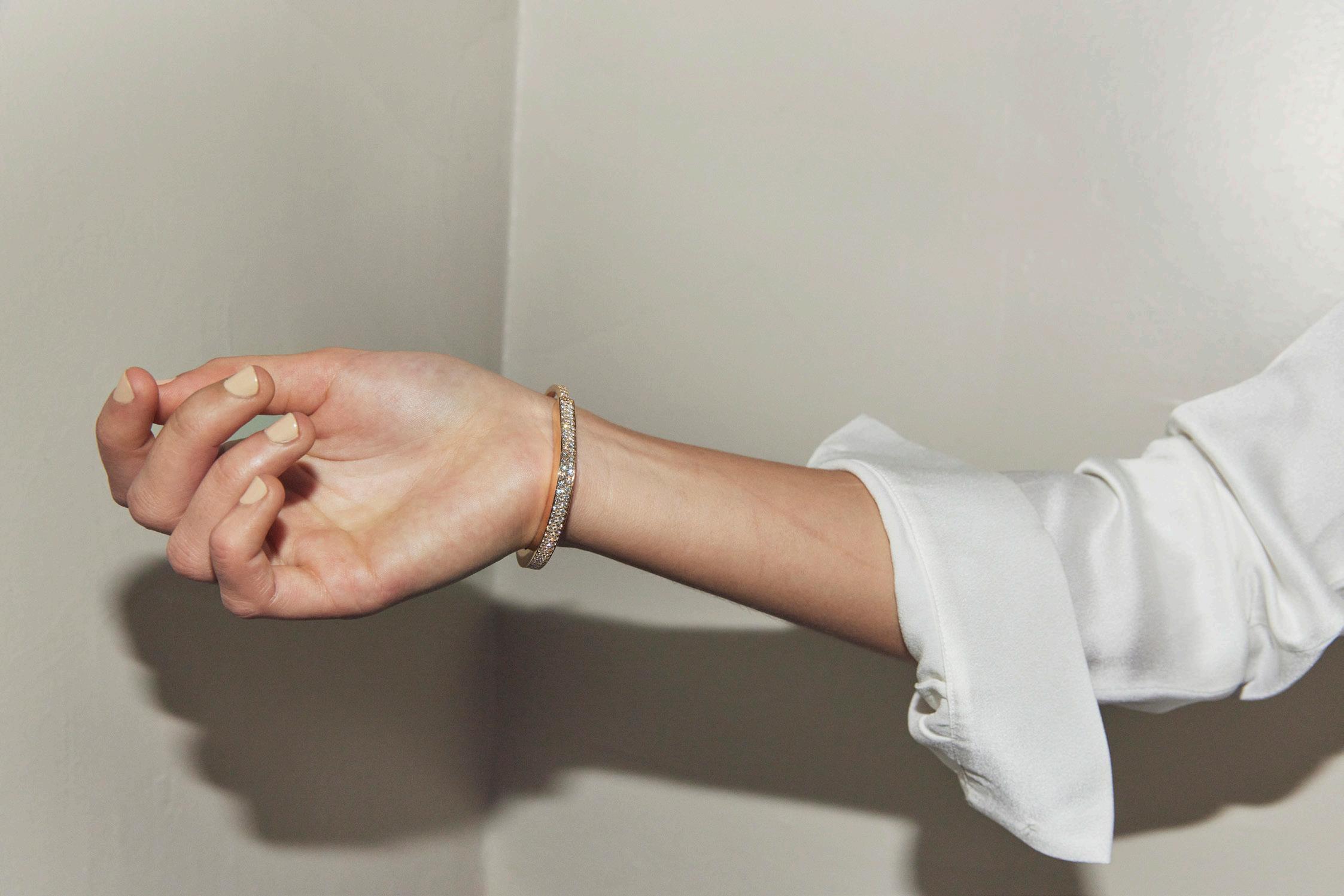
THE EDIT 2023 | 119

120 | THE EDIT 2023
Top: Nikos Koulis bangle, Boucheron bangle and earring. Bottom: Dilamani bangle. Diotima dress.
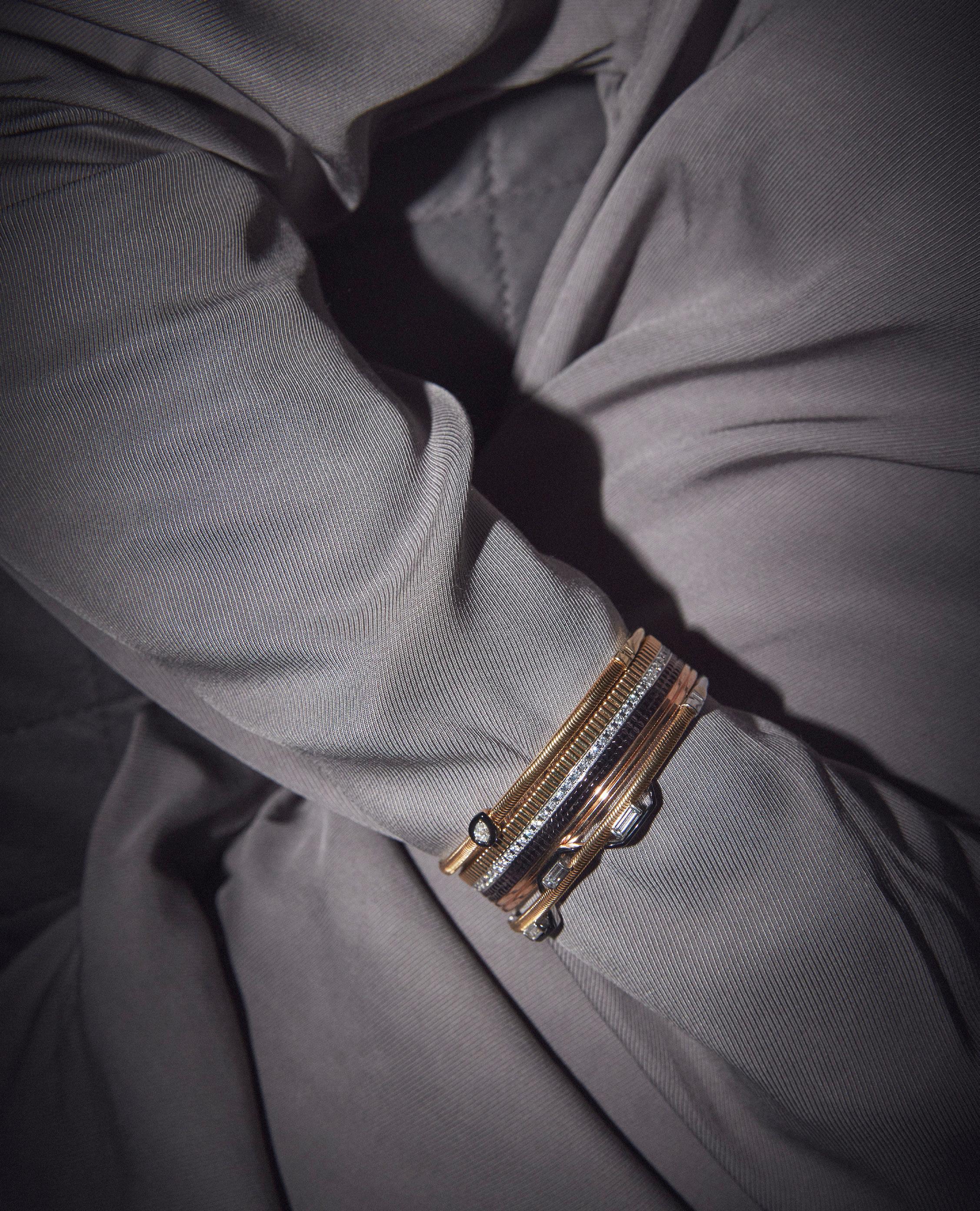
THE EDIT 2023 | 121

122 | THE EDIT 2023

THE EDIT 2023 | 123
From left to right: For Future Fortune bangles, Buccellati rings, Diotima dress and jacket, Baserange bralette and briefs.
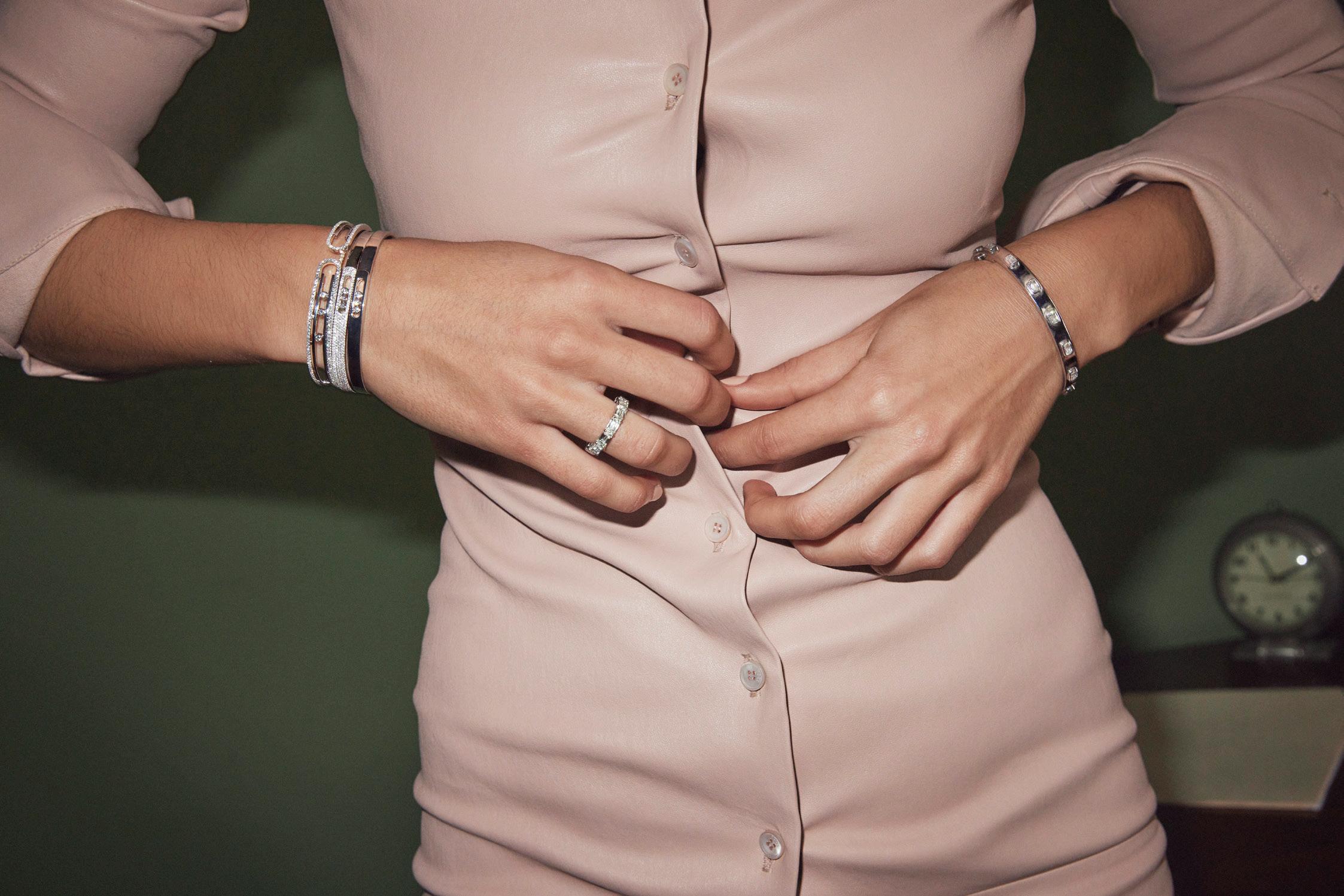
124 | THE EDIT 2023
From left to right: Messika bangles, William Goldberg ring, William Goldberg bangle, Tod's dress, Comme Si socks, Roger Vivier shoes. Photographer, Jennifer Livingston; Creative Director, Lizzy Oppenheimer; Stylist, Haidee Findlay-Levin; Hair, Junya Nakashima; Makeup, Charlotte Day; Manicurist, Mamie Onishi; Model, Zoe Pena; Creative Production, Petty Cash Production; Photo Assistants, Hans Olson, Eric Tanaka; Digital Tech, Chris Rice; Fashion Assistant, Jasmine Fontaina.


THE EDIT 2023 | 125

126 | THE EDIT 2023
From left to right: William Goldberg necklace and bracelet, James Free Jewelers bracelet, vintage Jean Paul Gaultier top, A.W.A.K.E. Mode skirt.
A bygone era inspires a fever dream of disco, decadence, and diamonds
Photographed by ALEXANDER SALADRIGAS
O DIAMOND DAYDREAM
THE EDIT 2023 | 127
S

 From left to right: Bucherer ring, Vhernier earring, FoundRae ring, James Free Jewelers bracelet, Sidney Garber necklace worn as belt, Chanel dress. Opposite page: Anita Ko earring, Bulgari bracelet, William Goldberg necklace, vintage Jean Paul Gaultier top.
From left to right: Bucherer ring, Vhernier earring, FoundRae ring, James Free Jewelers bracelet, Sidney Garber necklace worn as belt, Chanel dress. Opposite page: Anita Ko earring, Bulgari bracelet, William Goldberg necklace, vintage Jean Paul Gaultier top.
 From left to right: Jemma Wynne bracelet, Omega watch, Jenna Blake ring, vintage YSL top, Louis Vuitton skirt. Opposite page: Louis Vuitton skirt, Ugo Paulon shoes.
From left to right: Jemma Wynne bracelet, Omega watch, Jenna Blake ring, vintage YSL top, Louis Vuitton skirt. Opposite page: Louis Vuitton skirt, Ugo Paulon shoes.


 From left to right: FoundRae ring, James Free Jewelers bracelets, Vhernier earring, Bucherer ring. Opposite page: Sidney Garber necklace as belt, Chanel dress.
From left to right: FoundRae ring, James Free Jewelers bracelets, Vhernier earring, Bucherer ring. Opposite page: Sidney Garber necklace as belt, Chanel dress.
 From left to right: James Free Jewelers bracelet, Almasika ring, Reza earrings, Kloto ring, vintage Miu Miu jacket. Opposite page: Macadam ring, Pomellato bracelet, Chanel earrings, necklace and ring, Macadam ring, Ann Demeulemeester top and tights, Chanel shoes.
From left to right: James Free Jewelers bracelet, Almasika ring, Reza earrings, Kloto ring, vintage Miu Miu jacket. Opposite page: Macadam ring, Pomellato bracelet, Chanel earrings, necklace and ring, Macadam ring, Ann Demeulemeester top and tights, Chanel shoes.
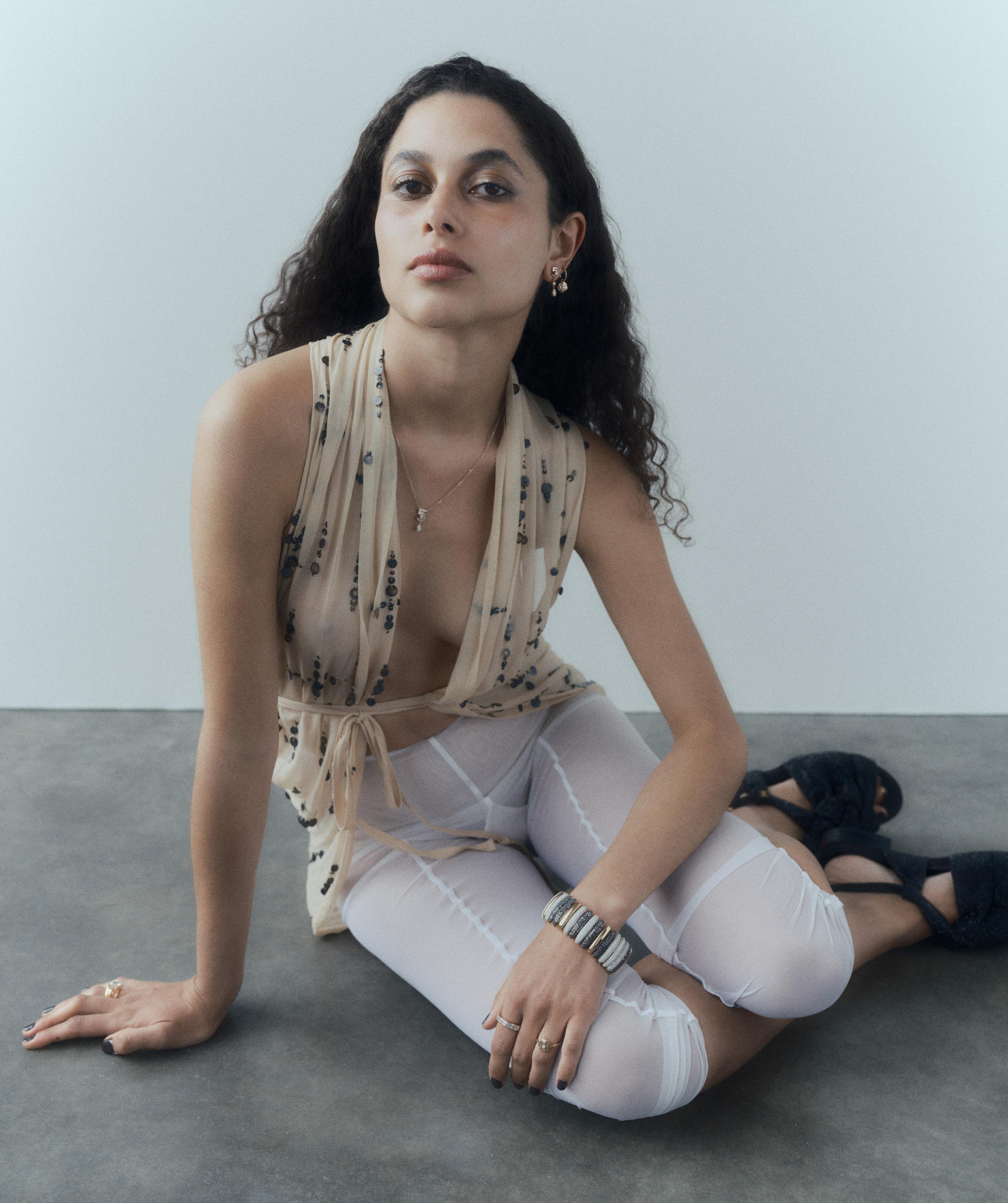
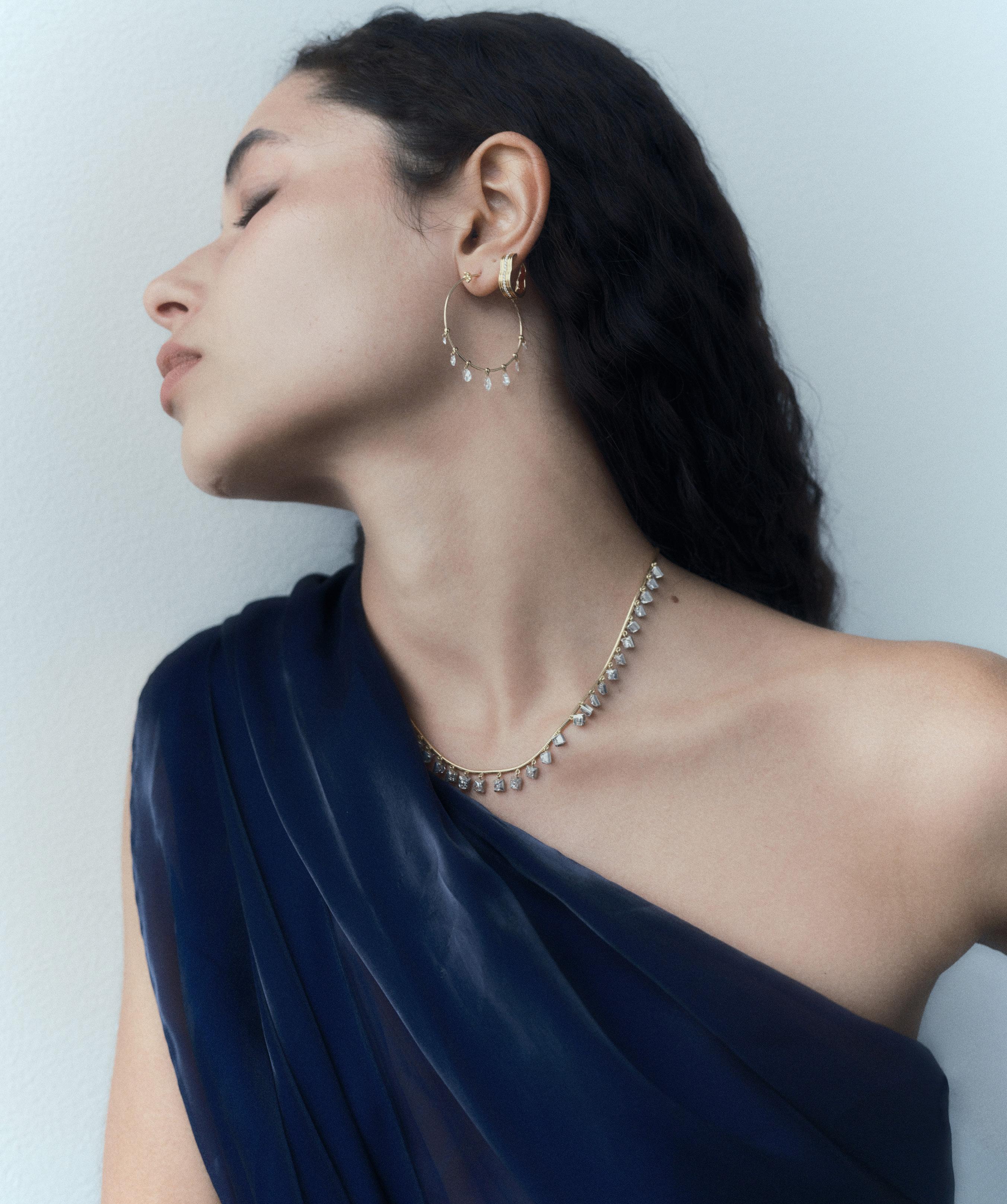 From left to right: Paul Morelli hoop, Almasika earring, Jenna Blake necklace, Ferragamo dress. Opposite page: Verdura bracelet worn in hair. Photographer, Alexander Saladrigas; Creative Director, Lizzy Oppenheimer; Stylist, Marissa Baklayan; Hair by Shinya Nakagawa at BRIDGE using R+Co; Make up, Maud Laceppe; Manicurist, Yukie Miyakawa; Model, Alici; Creative Production, Petty Cash Production; Photo Assistants, Ben Kasun, Colin Eliot; Digital Tech, Eliot Oppenheimer; Fashion Assistant, Carol Li.
From left to right: Paul Morelli hoop, Almasika earring, Jenna Blake necklace, Ferragamo dress. Opposite page: Verdura bracelet worn in hair. Photographer, Alexander Saladrigas; Creative Director, Lizzy Oppenheimer; Stylist, Marissa Baklayan; Hair by Shinya Nakagawa at BRIDGE using R+Co; Make up, Maud Laceppe; Manicurist, Yukie Miyakawa; Model, Alici; Creative Production, Petty Cash Production; Photo Assistants, Ben Kasun, Colin Eliot; Digital Tech, Eliot Oppenheimer; Fashion Assistant, Carol Li.

FEAT OF ENGINEERING FANCY
The French jeweler who designs for those who want something like nothing else.
Written by SAM BROEKEMA
Photographed by ANDREW WERNER
138 | THE EDIT 2023

James de Givenchy in his New York City salon.

T
10.15 carat heart-shaped portrait cut diamond, mother of pearl, ceramic and 18K rose gold pendant on a rubber cord.
The word no can be a great motivator. A trained dancer, James de Givenchy, moved from Paris to New York to pursue a life on the stage, but an injury prevented him from pursuing his first passion. Born into a family steeped in creativity, his uncle is the famed fashion designer Hubert de Givenchy who famously dressed Audrey Hepburn at her most soignée. The pursuit of beauty and an artistic life led the young ex-pat to the rarified world of international auction houses— first Christie’s and then Sotheby’s. It was here that he embarked upon an intense education in the world of jewelry. After launching his own collection in 1996, he has met with rare success and acclaim; the jewelry designer for those who prefer that if you know, then you know. This sterling reputation notwithstanding, he still sometimes hears the word no when testing the boundaries of how rare jewels can be mounted. That’s when he knows, again, that he is onto something and has discovered another missed opportunity.
ONLY NATURAL DIAMONDS: What started you as a creator and as a designer?
JAMES DE GIVENCHY: Growing up, my uncle [Hubert de Givenchy] was a huge influence on me. I remember looking at every collection launched and taking [the critics] extremely personally.
I left for America to be a dancer, [but] when that did not work out, due to a knee injury, I briefly considered going into choreography. My father had told me “you can do any art you want, but you’re going to have to make a living with it because I’m not taking care of you.” And rightly so. You have to be independent.
Ultimately I chose to go to FIT to study graphic design, which at that time sounded like a good idea, until I graduated and every graphic design company was merging. It was 1986.. I found myself on a bench with my FIT portfolio alongside creative directors that were looking for the same job.
My first full time job in New York was as a developer at Photostats in the dark room during the summer. Not a fun thing to do. Soon after, I was moved upstairs and I finally had a table to draw on. My first project was designing diaper fasteners... And that is when I realized I wanted something bigger.
One thing led to another. I worked at the Givenchy store in New York City. At one point, my brother, who was an architect in Paris, asked me to do some work in New York. I enjoyed it, until he asked me to come back to Paris and I said, “I’m not ready”.
So, I started looking for a job... Christie’s was o ering po-
sitions, and I worked at the front counter for about six or seven months before the head of the jewelry department, Francois Curiel, asked me to come upstairs because of my accent. He said they needed someone with a French accent to answer the telephone.
I was doing my first viewing at Christie’s and my uncle came in. He was the most amazing man. He knew about everything. When he saw the large diamond at the end of the sale, he paused for a moment, and said, let me show you something. He went back to the first case, “show me the brooch” he said. It was the autumn leaf from Verdura.
He went on to say, when you look at the big diamonds, They are beautiful. But, This brooch shows what jewelry is about. It’s about putting it all together. It was this idea that triggered something in me.
Christie’s o ered me training. Honestly, there is no [better] place to train than an auction house for anyone who wants to become a jeweler. You’ll understand what it takes to make a piece. Because if you just focus on the contemporary, you will never discover the greatest times of jewelry making, like the ‘20s in France, for example. And you will see the technique and what is necessary to manufacture.
That is where I really fell in love with the industry and the challenge of creating and making jewelry, with stone and without. I went on to do [courses at GIA, the Gemological Institute of America], I spent six years at Christie’s. Then I was hired by Verdura.
Eventually, I wanted to start my own business but, when I left Verdura with nothing and I thought, what am I going to do? A client then called out of the blue. She said, James, I have a drawing from Verdura, which I don’t care for. You always helped me at Christie’s and I’d love to see, now that you make jewelry, if you can do a drawing.
So, I made my first drawing and she loved it. That was the first piece I actually made as a special client piece. It was ’96. By 2000, I opened Ta n above the Givenchy store on Madison. It’s Carolina Herrera now. And I’ve just been trying to make new things every year, every day from that point on.
OND: It seems like many of your stories start with a stone. What prompts a new piece of jewelry? An idea or a stone or stones?
JDG: I often think it’s a stone. I always think of the [jewelry] safe as the kitchen fridge. When I go to a show, I’ll buy things that I don’t really know what to do with, and then it’s like opening the fridge before cooking something wonderful. I’ll pull things and I’ll play with them and move the stone around and then I’ll pair it with other stones. Sometimes, after a while, I either commit and I know the direction or it goes back in the safe—or the fridge—for some time.
OND: How do you balance creating one-of-a-kind pieces while maintaining something that is instantly recognizable?
JDG: It doesn’t really cross my mind. Making new pieces is probably the hardest thing, I’m not looking to make new things specifically, I’m trying not to repeat myself. If I see myself getting lazy and falling into a direction that would be the easy one, I abandon it and I try something new. Sometimes it takes a while and an idea has to be played with.
This phrase, ‘thinking out of the box,’ is really important. It helps
THE EDIT 2023 | 141
T
you freshen up the way you look at something. You might think something cannot be done or it shouldn’t be done —there is no such thing.
It looks like Ta n simply because I had proportions in my mind and my soul. I do not try. Occasionally, I’ll be surprised by a piece that doesn’t look like Ta n.
OND: What do you think is the most important thing for you to be as a mentor? What is your responsibility or your opportunity?
JDG: It [is] wonderful to listen and to see what young people have in mind when it comes to their future and the future of jewelry. I realize that actually we need more schools if we want to save the business. I think Europe has wonderful schools for that, but you can’t learn jewelry making unless you work at a bench.
OND: But back to the fridge. What are the qualities that you look for in a diamond to decide if you want to use it?
JDG: Truly the first thing I see is the cut. I rarely look at color or clarity initially. It could be a small stone or a big stone but it really has to be pleasing to my sensibility and bring something. For me, a diamond that’s not clear or the right color for certain people could be the most beautiful stone in the world. It’s unique and it comes down to the way you set it.
OND: What draws you to certain colored stones over others?
JdG: It’s not so much the color, it’s the hue. You can mix any colors if the hue is right. Certain stones will give you something back and they could be so di erent and be a perfect marriage. It could be a citrine and a pink diamond if it works. And there is no reason why you should say, well that’s a cheap stone and that’s not. It’s irrelevant because it’s the beauty that they make together.
OND: And this is how you know that it’s Ta n. I think that is the through line. Are there any other pieces that you want to talk about?
JdG: I could talk about every one of them, but there was one beautiful pear-shaped ring. This is where I’ve been really interested in working now. With these shapes and these colors. I’m extremely attracted to this.
OND: This is very Miami.
JDG: It is but in away for me-
OND: It’s Deco.
JDG: Yes, it’s Deco, but it has this modern, timeless thing. I love to mix the metal with the ceramic. Sometimes it’s in the middle, which is very di cult by the way because they are not the same hardness and will not polish the same way. Those are really tricky to make and make well because when you have those bands, any mistake you see on the thickness shows but then you are dealing, like my jewelers like to tell me, with a diamond that is not cut properly. So, it’s always the diamond’s fault. It’s always what you start with for me, these are some of the more fun pieces that I’m playing with at the moment, and you’ll see more of this. It’s not for everyone but I find I am very much into this right now.
OND: How long was this diamond in the fridge?
JDG: Diamonds don’t last in the fridge. It’s so funny. It’s like a steak.
But you want to say, no, these are the kind of things that don’t
last but you never know. But I’m happy to keep it forever.
OND: I don’t think you’ll be keeping this forever.
JDG: You might have a piece for two years, three years and people come in and they go ‘That’s so pretty, why didn’t it go?’ And it’s like that because it hasn’t found its home. I think the [piece] has to find its owner. And it will. It’s not gonna sit here forever. And if it does, you know, my daughter will have it. But it just hasn’t found someone who is worthy of it, let’s put it this way.
OND: Who understands it?
JDG: Who understands it? Who is willing to just commit.
OND: Can we talk a little bit more about the di culty of setting in leather?
JDG: We had to really think of how. The setting itself is in the metal. The di cult thing was how do you hold it so that it’s really secure and you don’t have to worry. All I wanted to see was a diamond but ultimately you had to do something to hold it so we had to do the prongs. I wanted small prongs but then you realize that you have to do something that’s big enough to hold this in a sandwich and hard enough that it doesn’t move. It’s building the box underneath the diamond and then this finish that’s like a commercial watch but protects the diamond from getting dirty and from scratching.
This is really something that I’m very excited about. As simple as it is, truly, I see men and women wearing this.
OND: Exactly. It’s not any one age or gender. I think you can be 90 years old on the Upper East Side and feel so cool or you can be 20.
JDG: And the excitement. Again, it’s not about making a hundred million of them but each one is going to be exciting because each one is going to be about the stone. So, I’m looking forward to seeing what a single stone looks like on this. It could be rubber as well if you want to be a bit S&M. You can have a few stones. You could have a collection of diamonds on the bracelet.
OND: Is that next? Is that coming out of the fridge?
JDG: It’s going to come out of the fridge. Yeah. We have some big guys coming out of the fridge for this.
OND: Can we talk about the portrait cut heart on the leather cord?
JDG: So, this, the diamond here, is really interesting. That’s a stone that came from Christie’s at auction. It’s a beautiful antique Mughal cut diamond. It’s a portrait cut and after buying it, one of my dealers came in and he was bidding on it too. And I said, you know, it’s great, there’s a little nick and I’m wondering if I could polish it. He said, “Do not touch it! These stones were polished by hand. It’s 200 years old, maybe more, and you can see the softness of the polish on the stone.” They were using wood to polish the facets. It would take up to six weeks, I think, for one facet.
After looking at the stone, you can start seeing the softness of a polish, which is a high polish but not a very flat surface. So, if you were to polish today, the whole thing would be extremely flat and you would lose the beauty of this diamond. Even after all these years, you never stop learning. What I wanted to do then, because it was Mughal, I [inscribed] love in Arabic and it’s on mother of pearl, which is put behind. I put it on rubber. Obviously, it could be worn on anything else. ♦
142 | THE EDIT 2023
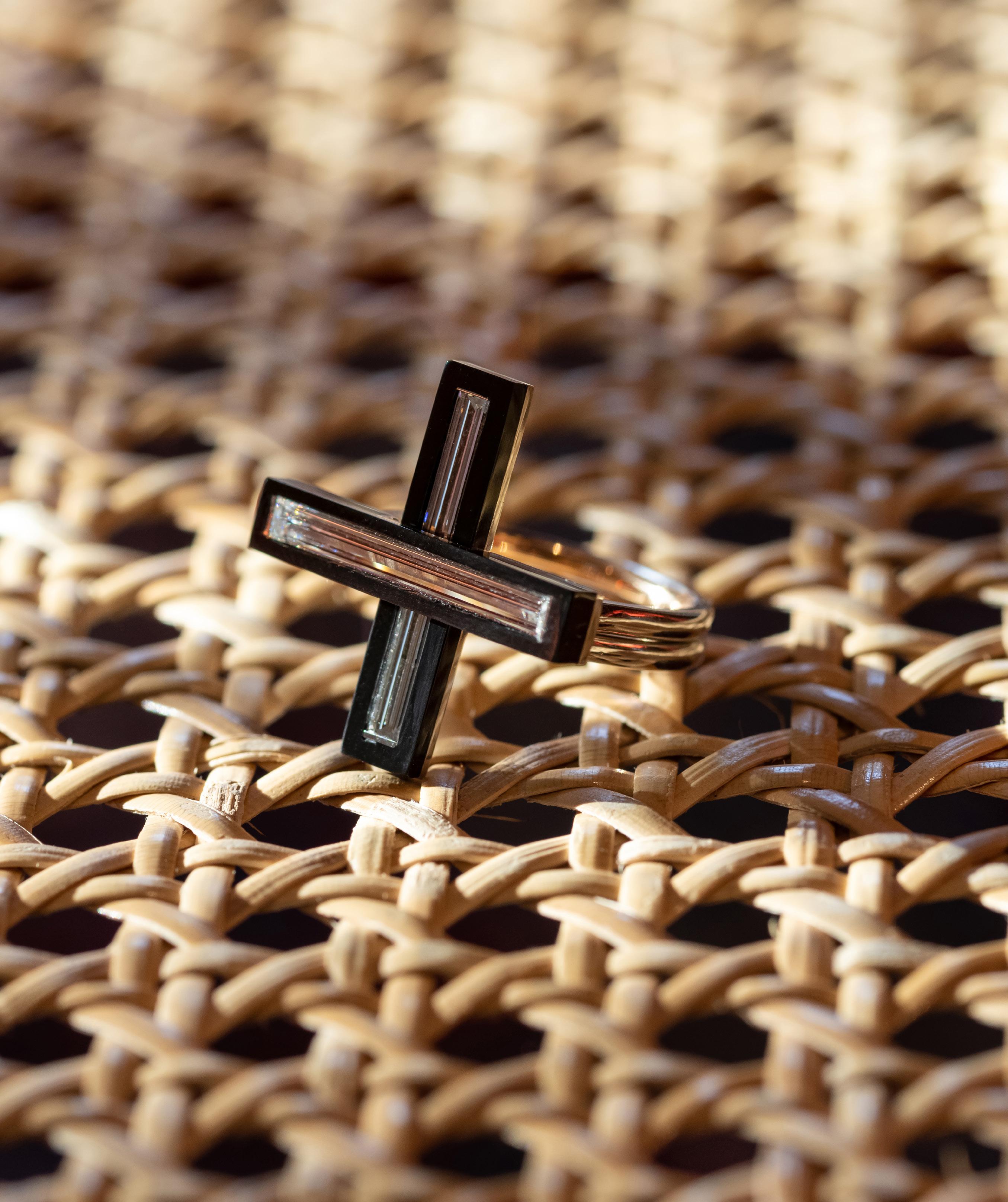 Pair of one carat baguette cut diamonds, D, IF, set in a pair of ceramic, platinum and 18K gold rings.
Pair of one carat baguette cut diamonds, D, IF, set in a pair of ceramic, platinum and 18K gold rings.

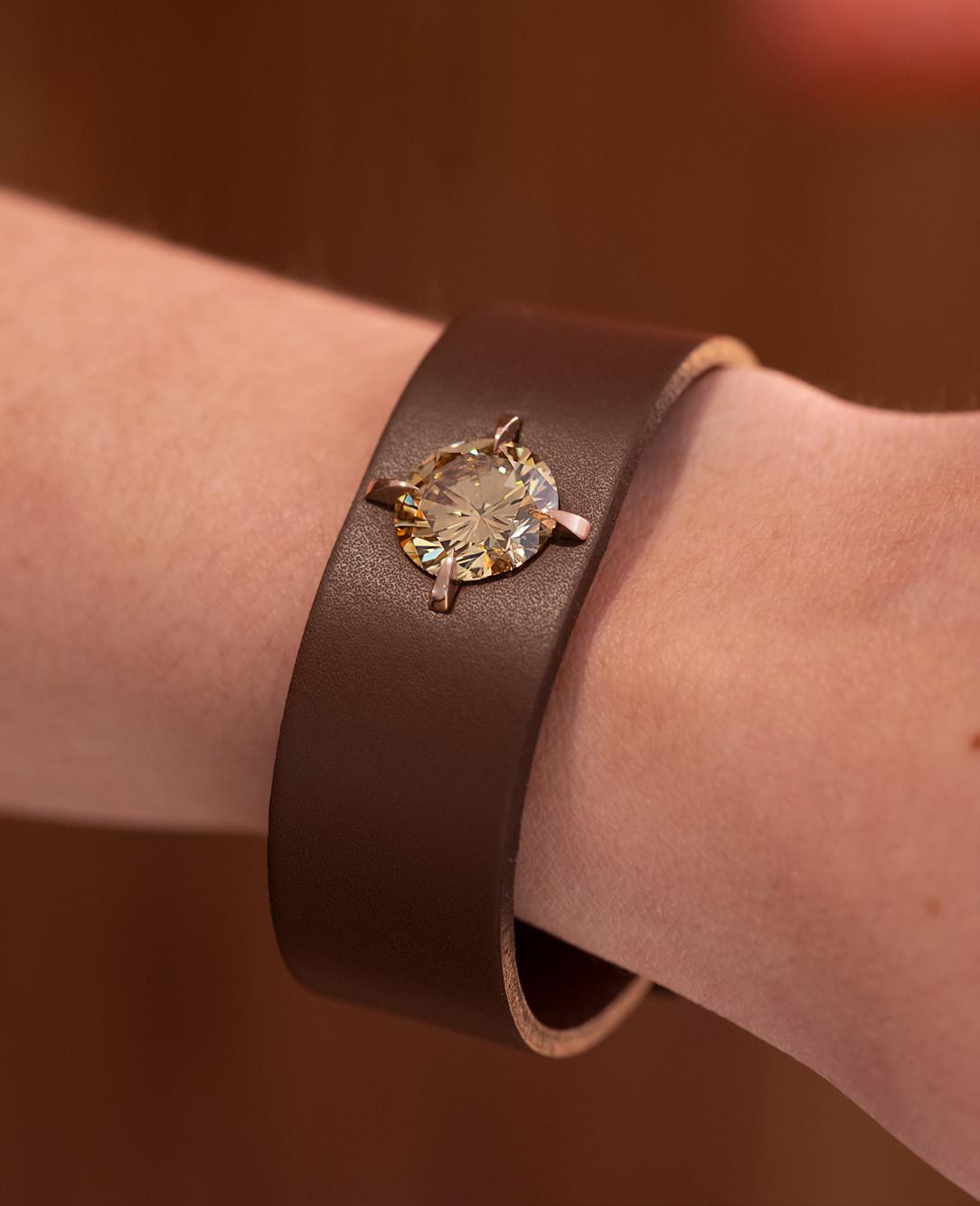

144 | THE EDIT 2023
 Clockwise from top left: 8.21 carat fancy deep brownish-yellow round diamond, 18K rose gold & leather bracelet. Rose cut diamond ring set in ceramic. 6.07 carat cabochon diamond with diamond pavé, ceramic, platinum and 18K rose gold ring. 12.32 carat kite-shaped diamond, moonstone bead, rubber and platinum bracelet.
Clockwise from top left: 8.21 carat fancy deep brownish-yellow round diamond, 18K rose gold & leather bracelet. Rose cut diamond ring set in ceramic. 6.07 carat cabochon diamond with diamond pavé, ceramic, platinum and 18K rose gold ring. 12.32 carat kite-shaped diamond, moonstone bead, rubber and platinum bracelet.
THANK YOU, BY THE WAY
Your NATURAL DIAMOND helps protect the lives of millions of wild animals globally, saving threatened species from extinction. naturaldiamonds.com/thankyou


























 Gabrielle Union wears Retrouvai ring, Skeie's Jewelers necklace (top), Anita Ko necklaces, Louis Vuitton top. Opposite page: Casey Perez necklace.
Gabrielle Union wears Retrouvai ring, Skeie's Jewelers necklace (top), Anita Ko necklaces, Louis Vuitton top. Opposite page: Casey Perez necklace.


























 Written by LYNN YAEGER
Photographs by ANDREW WERNER
Written by LYNN YAEGER
Photographs by ANDREW WERNER





 Written by JESSICA IREDALE
Written by JESSICA IREDALE














 Written by GRANT MOBLEY
Written by GRANT MOBLEY
 Wild caribou roam the area near the Ekati Diamond mine in Canada’s Northwest territories.
Wild caribou roam the area near the Ekati Diamond mine in Canada’s Northwest territories.















 Photographs by ANDREW WERNER
Photographs by ANDREW WERNER





















 Rings, Tiffany & Co.
Rings, Tiffany & Co.



















 Gabrielle wears Wempe bracelet, Tabayer rings, William Goldberg necklace. Messika hoop, Magda Butrym blazer.
Gabrielle wears Wempe bracelet, Tabayer rings, William Goldberg necklace. Messika hoop, Magda Butrym blazer.


 Skeie's Jewelers necklace (top), Anita Ko necklaces, Louis Vuitton top.
Skeie's Jewelers necklace (top), Anita Ko necklaces, Louis Vuitton top.
 From left to right: Anita Ko ring, Taffin necklace, Sydney Evan ring, Gabrielle's own rings, vintage Donna Karan Collection dress.
From left to right: Anita Ko ring, Taffin necklace, Sydney Evan ring, Gabrielle's own rings, vintage Donna Karan Collection dress.
 From left to right Gabrielle's own rings, Tiffany & Co necklace, Anita Ko bracelets, Jacquie Aiche bracelet, Ana Khouri ear cuff, DKNY sweater, Skims bralette and briefs.Opposite page: David Webb rings and necklace, Mateo earrings.
From left to right Gabrielle's own rings, Tiffany & Co necklace, Anita Ko bracelets, Jacquie Aiche bracelet, Ana Khouri ear cuff, DKNY sweater, Skims bralette and briefs.Opposite page: David Webb rings and necklace, Mateo earrings.

 Skeie's Jewelers necklace, Anita Ko necklaces, Anita Ko bracelet, Skeie's Jewelers bracelet, Eriness bracelet, Louis Vuitton top and skirt.
Skeie's Jewelers necklace, Anita Ko necklaces, Anita Ko bracelet, Skeie's Jewelers bracelet, Eriness bracelet, Louis Vuitton top and skirt.


 From left to right: Katie wears Stephanie Gottlieb earrings, Aknvas suit from Nordstrom, Jimmy Choo shoes. Hey Yeon wears Lorraine West ring, Arielle Ratner necklace, Aknvas suit from Nordstrom, Jean Paul Gaultier tank top from Albright Fashion Library, Alexandre Birman shoes.
Astrid wears The Clear Cut ring, Alice & Olivia suit from Nordstrom, Reike Nen shoes. Daniil wears Retrouvai necklace, KatKim ring, Officine Generale suit, Alexander McQueen shoes. Coco wears Arielle Ratner ring, Christopher John Rogers suit from Albright Fashion Library, Reike Nen shoes. Sonia wears Lorraine West ring, Kwiat necklace, Michael Kors suit.
From left to right: Katie wears Stephanie Gottlieb earrings, Aknvas suit from Nordstrom, Jimmy Choo shoes. Hey Yeon wears Lorraine West ring, Arielle Ratner necklace, Aknvas suit from Nordstrom, Jean Paul Gaultier tank top from Albright Fashion Library, Alexandre Birman shoes.
Astrid wears The Clear Cut ring, Alice & Olivia suit from Nordstrom, Reike Nen shoes. Daniil wears Retrouvai necklace, KatKim ring, Officine Generale suit, Alexander McQueen shoes. Coco wears Arielle Ratner ring, Christopher John Rogers suit from Albright Fashion Library, Reike Nen shoes. Sonia wears Lorraine West ring, Kwiat necklace, Michael Kors suit.

 From left to right: Sonia wears Stephanie Gottlieb ring, Anita Ko ring, Oliver Blandi ring, Area dress. Opposite page: Katie wears Oliver Blandi ring. Astrid wears Natasha Schweitzer ring, Lorraine West ring, Jade Trau bracelet. Hey Yeon wears Kwiat ring. Catsuits by Richard Quinn from Albright Fashion Library.
From left to right: Sonia wears Stephanie Gottlieb ring, Anita Ko ring, Oliver Blandi ring, Area dress. Opposite page: Katie wears Oliver Blandi ring. Astrid wears Natasha Schweitzer ring, Lorraine West ring, Jade Trau bracelet. Hey Yeon wears Kwiat ring. Catsuits by Richard Quinn from Albright Fashion Library.

 From left to right: Sonia wears Sorellina bracelet, William Goldberg ring, Mother of All dress. Coco wears Greenwich St. Jewelers ring, Stephanie Gottlieb ring, SVNR top and skirt. Daniil wears Sylva & Cie ring, Bite Studios top, Sally LaPointe pants. Katie wears William Goldberg ring, Araks dress. Astrid wears Jenna Blake ring, Stephanie Gottlieb bracelet, Mother of All dress. Hey Yeon wears Jade Trau ring, Reza ring, Forte Forte dress.
From left to right: Sonia wears Sorellina bracelet, William Goldberg ring, Mother of All dress. Coco wears Greenwich St. Jewelers ring, Stephanie Gottlieb ring, SVNR top and skirt. Daniil wears Sylva & Cie ring, Bite Studios top, Sally LaPointe pants. Katie wears William Goldberg ring, Araks dress. Astrid wears Jenna Blake ring, Stephanie Gottlieb bracelet, Mother of All dress. Hey Yeon wears Jade Trau ring, Reza ring, Forte Forte dress.


 From left to right: Sonia wears Clear Cut ring, Clear Cut necklaces worn as belt, Acne Studios top and skirt from Nordstrom, Katy Perry shoes. Coco wears Belperron ring, Michael Kors bodysuit and pants. Daniil wears Ana Khouri ring, Ferragamo top, pants and shoes. Opposite page: Coco wears Belperron ring. Sonia wears Clear Cut ring.
From left to right: Sonia wears Clear Cut ring, Clear Cut necklaces worn as belt, Acne Studios top and skirt from Nordstrom, Katy Perry shoes. Coco wears Belperron ring, Michael Kors bodysuit and pants. Daniil wears Ana Khouri ring, Ferragamo top, pants and shoes. Opposite page: Coco wears Belperron ring. Sonia wears Clear Cut ring.
 From left to right: Astrid wears Jenna Blake ring, Stephanie Gottlieb bracelet, Mother of All dress. Hey Yeon wears Jade Trau ring, Reza ring, Forte Forte dress.
Katie wears William Goldberg ring, Araks dress.
Opposite page: Lorraine West ring, Clear Cut ring, Arielle Ratner ring, Lorraine West ring, KatKim ring.
From left to right: Astrid wears Jenna Blake ring, Stephanie Gottlieb bracelet, Mother of All dress. Hey Yeon wears Jade Trau ring, Reza ring, Forte Forte dress.
Katie wears William Goldberg ring, Araks dress.
Opposite page: Lorraine West ring, Clear Cut ring, Arielle Ratner ring, Lorraine West ring, KatKim ring.



 From left to right: Sonia wears Clear Cut ring. Daniil wears Ana Khouri ring. Coco wears Belperron ring. Opposite page: Hey Yeon wears Elizabeth Octavia ring, Arielle Ratner ring, Sorellina necklace, Interior top and skirt. Astrid wears Ana Khouri ring, Kwiat bracelet, Ferragamo dress.
From left to right: Sonia wears Clear Cut ring. Daniil wears Ana Khouri ring. Coco wears Belperron ring. Opposite page: Hey Yeon wears Elizabeth Octavia ring, Arielle Ratner ring, Sorellina necklace, Interior top and skirt. Astrid wears Ana Khouri ring, Kwiat bracelet, Ferragamo dress.

 Sonia wears Kwiat necklace. Photographer, Mark Lim; Creative Director, Lizzy Oppenheimer; Stylist, Herin Choi; Hair, Edward Lampley; Makeup, Allie Smith; Manicurist, Mamie Onishi; Models, Astrid, Coco, Daniil, Hey Yeon Yoo, Katie Johnson, Sonia; Creative Production, Petty Cash Production; Photo Assistants, Hector de Jesus, Adam Kim, Mike Pardo; Digital Tech, Yu Hsing Lin; Fashion Assistants, Jasmine Fontaina, Sevn Rodriguez.
Sonia wears Kwiat necklace. Photographer, Mark Lim; Creative Director, Lizzy Oppenheimer; Stylist, Herin Choi; Hair, Edward Lampley; Makeup, Allie Smith; Manicurist, Mamie Onishi; Models, Astrid, Coco, Daniil, Hey Yeon Yoo, Katie Johnson, Sonia; Creative Production, Petty Cash Production; Photo Assistants, Hector de Jesus, Adam Kim, Mike Pardo; Digital Tech, Yu Hsing Lin; Fashion Assistants, Jasmine Fontaina, Sevn Rodriguez.

 From left to right: Eva Fehren ring, Norman Silverman necklace, EF Collection earrings, Sylva & Cie ring, Briony Raymond bracelet, vintage Thierry Mugler top, Stella McCartney skirt.
From left to right: Eva Fehren ring, Norman Silverman necklace, EF Collection earrings, Sylva & Cie ring, Briony Raymond bracelet, vintage Thierry Mugler top, Stella McCartney skirt.


 Eva Fehren earrings, vintage Versace top.
Eva Fehren earrings, vintage Versace top.





 Fromt left to right: Briony Raymond bangle, Vendorafa bangle, Guest in Residence top and briefs.
Fromt left to right: Briony Raymond bangle, Vendorafa bangle, Guest in Residence top and briefs.












 Tiffany & Co bangles, Baserange bralette and briefs, Social-Work skirt.
Tiffany & Co bangles, Baserange bralette and briefs, Social-Work skirt.











 From left to right: Bucherer ring, Vhernier earring, FoundRae ring, James Free Jewelers bracelet, Sidney Garber necklace worn as belt, Chanel dress. Opposite page: Anita Ko earring, Bulgari bracelet, William Goldberg necklace, vintage Jean Paul Gaultier top.
From left to right: Bucherer ring, Vhernier earring, FoundRae ring, James Free Jewelers bracelet, Sidney Garber necklace worn as belt, Chanel dress. Opposite page: Anita Ko earring, Bulgari bracelet, William Goldberg necklace, vintage Jean Paul Gaultier top.
 From left to right: Jemma Wynne bracelet, Omega watch, Jenna Blake ring, vintage YSL top, Louis Vuitton skirt. Opposite page: Louis Vuitton skirt, Ugo Paulon shoes.
From left to right: Jemma Wynne bracelet, Omega watch, Jenna Blake ring, vintage YSL top, Louis Vuitton skirt. Opposite page: Louis Vuitton skirt, Ugo Paulon shoes.


 From left to right: FoundRae ring, James Free Jewelers bracelets, Vhernier earring, Bucherer ring. Opposite page: Sidney Garber necklace as belt, Chanel dress.
From left to right: FoundRae ring, James Free Jewelers bracelets, Vhernier earring, Bucherer ring. Opposite page: Sidney Garber necklace as belt, Chanel dress.
 From left to right: James Free Jewelers bracelet, Almasika ring, Reza earrings, Kloto ring, vintage Miu Miu jacket. Opposite page: Macadam ring, Pomellato bracelet, Chanel earrings, necklace and ring, Macadam ring, Ann Demeulemeester top and tights, Chanel shoes.
From left to right: James Free Jewelers bracelet, Almasika ring, Reza earrings, Kloto ring, vintage Miu Miu jacket. Opposite page: Macadam ring, Pomellato bracelet, Chanel earrings, necklace and ring, Macadam ring, Ann Demeulemeester top and tights, Chanel shoes.

 From left to right: Paul Morelli hoop, Almasika earring, Jenna Blake necklace, Ferragamo dress. Opposite page: Verdura bracelet worn in hair. Photographer, Alexander Saladrigas; Creative Director, Lizzy Oppenheimer; Stylist, Marissa Baklayan; Hair by Shinya Nakagawa at BRIDGE using R+Co; Make up, Maud Laceppe; Manicurist, Yukie Miyakawa; Model, Alici; Creative Production, Petty Cash Production; Photo Assistants, Ben Kasun, Colin Eliot; Digital Tech, Eliot Oppenheimer; Fashion Assistant, Carol Li.
From left to right: Paul Morelli hoop, Almasika earring, Jenna Blake necklace, Ferragamo dress. Opposite page: Verdura bracelet worn in hair. Photographer, Alexander Saladrigas; Creative Director, Lizzy Oppenheimer; Stylist, Marissa Baklayan; Hair by Shinya Nakagawa at BRIDGE using R+Co; Make up, Maud Laceppe; Manicurist, Yukie Miyakawa; Model, Alici; Creative Production, Petty Cash Production; Photo Assistants, Ben Kasun, Colin Eliot; Digital Tech, Eliot Oppenheimer; Fashion Assistant, Carol Li.



 Pair of one carat baguette cut diamonds, D, IF, set in a pair of ceramic, platinum and 18K gold rings.
Pair of one carat baguette cut diamonds, D, IF, set in a pair of ceramic, platinum and 18K gold rings.



 Clockwise from top left: 8.21 carat fancy deep brownish-yellow round diamond, 18K rose gold & leather bracelet. Rose cut diamond ring set in ceramic. 6.07 carat cabochon diamond with diamond pavé, ceramic, platinum and 18K rose gold ring. 12.32 carat kite-shaped diamond, moonstone bead, rubber and platinum bracelet.
Clockwise from top left: 8.21 carat fancy deep brownish-yellow round diamond, 18K rose gold & leather bracelet. Rose cut diamond ring set in ceramic. 6.07 carat cabochon diamond with diamond pavé, ceramic, platinum and 18K rose gold ring. 12.32 carat kite-shaped diamond, moonstone bead, rubber and platinum bracelet.
